

Far Beyond the Stars (episode)
- View history
Experiencing a vision from the Prophets, Sisko sees himself as Benny Russell, a science-fiction writer in the 1950s, who struggles with civil rights and inequality when he writes the story of Captain Benjamin Sisko, a black commander of a futuristic space station.
- 1.2 Act One
- 1.3 Act Two
- 1.4 Act Three
- 1.5 Act Four
- 1.6 Act Five
- 2 Memorable quotes
- 3.2 Story and script
- 3.3 Cast and characters
- 3.4 Production
- 3.5.1 Star Trek and science fiction
- 3.5.2 Star Trek and "Far Beyond the Stars"
- 3.5.3 Deep Space Nine in 1953
- 3.5.4 Other trivia
- 3.7 Video and DVD releases
- 4.1 Starring
- 4.2 Also starring
- 4.3 Guest stars
- 4.4 Uncredited co-stars
- 4.5 Stunt double
- 4.6.1 Incredible Tales references
- 4.6.2 Unreferenced material
- 4.7 External links
Summary [ ]
Joseph Sisko , Captain Benjamin Sisko 's father, has left Earth for the first time to visit his son and grandson on Deep Space 9 , but his timing couldn't be worse. Although the Federation is in firm control of the station, the Cardassian border is still a risky place for Federation ships to patrol. In particular, the USS Cortez has recently been destroyed, and even a six-hour search by the USS Defiant failed to discover any survivors. That means Captain Quentin Swofford – a man Sisko knew well – is dead, and Sisko is distraught, given that he introduced Swofford to his wife. He is beginning to despair of making any kind of difference in the war effort at all, and is seriously considering stepping down and letting someone else make the tough decisions. Joseph promises to support his son no matter what decision he makes, but warns him to think carefully before he does anything.
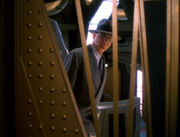
" Who was that? "
As he discusses the news with his father, Sisko is distracted and puzzled when he sees a strange man walk past his office dressed in 1950s Earth clothing. Dax , standing right outside in ops , insists she didn't see anyone, which only makes it a greater puzzle. Later, when walking down a corridor with Kasidy Yates , Sisko is again confused when a baseball player walks past and calls, " Hey, Benny! Catch the game? " Again, Yates is sure she didn't see anyone. When Sisko follows the man through a door, he finds himself suddenly in the middle of a busy New York street and is immediately hit by a taxi .
Doctor Bashir examines him in the infirmary and finds unusual synaptic potentials – his neural patterns look like they did when Sisko was having visions the year before . When Sisko takes a PADD to examine the data for himself, he finds himself instead looking at a copy of Galaxy at a New York newsstand . What's more, Sisko – or rather, Benny Russell – feels completely at home on this street, and when Albert Macklin comes around the corner they walk off together to the office.
Act One [ ]
The people Russell knows at the office and meets on the street are similar to the people Sisko knows on the station. They sound the same, and look at least somewhat similar, but they are not the same people. The news vendor is not Nog , Macklin is not Miles O'Brien , and Kay Eaton is not Kira Nerys . They are merely characters in a dream created from the likeness of his real-world friends. From this point until Sisko wakes up, the story is told from Benny Russell's perspective (as though the 1950s setting is the "real" world).
When Russell and Macklin arrive at Incredible Tales – the science fiction magazine for which they work – they find writer Herbert Rossoff ( Quark ) and editor Douglas Pabst ( Odo ) engaged in "The Battle of the Doughnuts , Round 28" (as Eaton describes it). Eaton herself has been experimenting with White Rose Redi-Tea (" A pitcher of plain water becomes a pitcher of iced tea ") – a concept her husband, Julius ( Julian Bashir ), as a "self-respecting Englishman," finds appalling. Macklin is, as always, looking for matches to light his pipe, even though Russell just gave them to him. When the bickering and general bustle ebbs enough, Pabst calls the meeting to order.
The magazine's illustrator, Roy Ritterhouse ( Martok ) comes in bearing a stack of science fiction sketches to distribute to the pool of writers for the next month's stories. Russell is particularly taken with a drawing of a space station – basically a circle with pylons at 120 degree intervals, and "USAF DS/9" stenciled around the edge. He takes the sketch and offers to create an appropriate story to accompany it. Trouble starts, however, when Pabst announces that their publisher wants a group photo of the writing staff for the next issue, and Pabst "suggests" that Eaton and Russell "sleep late" the morning it is taken – the public needn't know that women and blacks are writing for Incredible Tales along with the white men. Rossoff sarcastically quips about the dangers of "a Negro with a typewriter " and Russell is angry, but Pabst holds firm. There will be no picture of Eaton and no picture of Russell. " It's not personal Benny, but as far as our readers are concerned, Benny Russell is as white as they are. Let's just keep it that way, " Pabst states, matter-of-factly.
That evening, as Russell leaves the office ( Incredible Tales is located in the Arthur Trill Building ), the space station sketch is caught in a breeze and lands under the shoe of Burt Ryan ( Dukat ) – an NYPD detective with an attitude. He and his partner, Kevin Mulkahey ( Weyoun ) are suspicious of a janitor (as they perceive Russell) dressed in a nice suit , but give back the drawing with " This time you're getting off with a warning. Next time you won't be so lucky. "
Then, as he's almost home, Russell hears a preacher ( Joseph Sisko ) on a street corner who seems to be speaking directly to Benny. " Write those words, Brother Benny! " the preacher advises – write the words of the " God of the spirits of the prophets. "
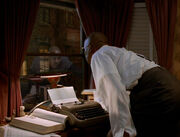
" Captain Benjamin Sisko sat looking out the window… "
With all these events fresh in his mind, Benny Russell sits down in his apartment before his typewriter with the space station picture in front of him and begins to write. " Captain Benjamin Sisko sat looking out the window… " Even as he writes the words Benny sees his reflection in his own window – only he has on a curious uniform instead of a shirt and tie and his glasses are gone. He presses on with his story well into the night.
Act Two [ ]
When the story is finally finished some days later he shows it to his fiancee, Cassie ( Yates ) at the diner where she waits tables. While he is sipping coffee at the counter, famous baseball player Willie Hawkins ( Worf ) comes in and flirts, only half-jokingly, with Cassie while saying hello to Russell. Russell also encounters Jimmy ( Jake Sisko ), a street kid. Fresh after hearing Hawkins tell how white people wouldn't want him living in their neighborhoods, Russell hears Jimmy's skepticism about the new story. What's more, Jimmy is trying to pawn a watch he "found" and Russell's cautions about him getting in trouble don't seem to do any good.
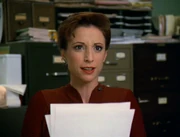
Kay Eaton appears as Major Kira
On the other hand, the entire writing staff of Incredible Tales loves the story, which Russell has titled "Deep Space Nine." In fact, it is the best thing Pabst's secretary Darlene Kursky ( Jadzia Dax ) has ever read. Russell, exhausted from lack of sleep, is worried that he's hallucinating – while Kay Eaton is complimenting the "strong female character" in his story, he takes off his glasses for a moment and sees her wearing a red uniform and strange ridges on her nose .
Unfortunately, Pabst himself is unwilling to print the story. " It's not believable, " he insists, since it features a Negro space station captain for a hero. Pabst tells Russell to make the captain white, but he angrily tells him that's not what he wrote. Pabst tells Russell that it is his call.
Act Three [ ]
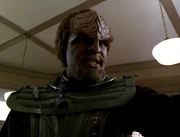
Willie Hawkins appears as Worf
Russell is sitting at the restaurant with a cigarette in his hand telling about his story and Jimmy isn't remotely surprised, and Cassie suggests it may be a sign he should stop writing and go into the restaurant business with her – owning and running the diner. When Hawkins comes in and grabs Russell by the shoulder, he's surprised to see ridges on his forehead and strange clothing . He jumps off the stool in surprise, but when he looks up again it is just Hawkins, asking if Russell had seen the game. Russell leaves, troubled by the vision.
That evening, he encounters the same preacher again. " Walk with the prophets, Brother Benny! " he insists. " Write the words that will lead us out of the darkness and onto the path of righteousness. " Russell rushes home and sits down before his typewriter once again, concentrating so hard he even forgets about his date with Cassie. She finds him sleeping with a stack of pages in his hand – a new Ben Sisko story – and tries to get him to relax by taking a "spin around the dance floor" in the living room. He's startled once again when he instead sees himself dancing in a strange room and to hear "Cassie" talking about "the Dominion ." He flashes back and forth between his living room and the space station – seeing things from his own story.
Act Four [ ]
As Russell questions his own sanity, Pabst insists he's certifiable – he's written six sequels to the "Deep Space Nine" story Pabst already refused to publish. Macklin makes a suggestion that could salvage everything though: make the story (at least the first story) a dream. If a poor Negro were dreaming of such a future, the story might work, Pabst grudgingly admits, and Russell agrees that anything would be better than not publishing the story at all.
Even as Russell and Cassie are celebrating getting the story published, however, another tragedy strikes. They encounter the preacher, who warns, " the path of the Prophets sometimes leads into darkness and pain ", just as gunshots ring through the air. Russell rushes forward and finds that Ryan and Mulkahey have shot and killed Jimmy. When Russell tries to fight his way to him, the two cops begin to beat him up, and Russell sees ridges on Ryan's neck and long thin ears on Mulkahey's face.
Act Five [ ]
Russell has been badly beaten and is walking with a cane , but a few weeks later on the day his story is finally published, he makes his way to the office anyway (with Cassie's encouragement). The staff are happy to see Russell for the first time since his beating. They also reveal that Macklin has sold a novel, and Russell is very happy for his friend. Then Pabst arrives… but with no magazine. Pabst explains that there's not going to be an edition of Incredible Tales that month; apparently the entire run was pulped because the publisher, Mr. Stone , felt the issue didn't meet their "usual high standards". Russell, already knowing the truth, asks what the publishers didn't like. The artwork? The layout? But Russell, already starting to break down, answers his own question: the magazine was pulped because the hero of "Deep Space Nine" is a colored man. Pabst tells Russell that he knows it isn't right, but he furiously defends the decision, saying that "it's not about what's right, it's about what is ." This leads into further bad news – the publishers have decided that Russell's services are no longer required. The rest of the staff recoil in shock, and even the normally unflappable Julius Eaton is horrified. Russell tells Pabst that he can't be fired, because he quits, before sweeping the contents of a nearby table on the floor in anger as he begins to have a nervous breakdown. He is devastated that everyone is attempting to deny both himself and Ben Sisko, that the publishers are attempting to destroy the story. But he says, sobbing, that they cannot destroy the idea. Ben Sisko, "Deep Space Nine", and all the people from the story, they exist inside his head, and in the heads of everyone who read it.
Russell finally collapses, sobbing and cradled by his former co-workers.
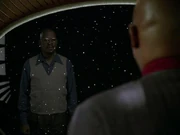
" You are the dreamer, and the dream. "
As he's carted away in an ambulance , Benny Russell finds the preacher sitting beside him and sees himself in a strange uniform . " Who am I? " he asks quietly. " You're the dreamer, " the preacher answers him, " and the dream. "
Captain Benjamin Sisko wakes up in the infirmary with Kasidy, Jake, Joseph, and Dr. Bashir standing over him, happy to see him awake. He was unconscious for only a few minutes, and Bashir reports that his neural patterns are returning to normal.
As Joseph gets ready to leave, Sisko, sitting on a couch in his quarters , says that his dream has encouraged him to stay on DS9 and keep fighting "the good fight." He also confides to his father that he wonders whether their world really is "the real world," or just a vision, and somewhere far beyond the stars Benny Russell really exists. He stares out the window , and sees a reflection of himself wearing Benny's clothes.
Memorable quotes [ ]
" Wishing never changed a damn thing. "
" Oh! She's got a worm in her belly!… oh that's disgusting. It's interestin', but disgusting. "
" Calm down, dear boy. We're writers, not Vikings . "
" You are the dreamer… and the dream. "
" Hey! You gonna buy that or not?! "
" All right, friends and neighbors, let's see what Uncle Roy brought you today. "
" Well I got news for you… today or a hundred years from now don't make a bit of difference – as far as they're concerned, we'll always be n*ggers . "
" If the world's not ready for a woman writer – imagine what would happen if it learned about a Negro with a typewriter – run for the hills! It's the end of civilization! "
" Herb's been angry ever since the day Joseph Stalin died… "
" I like robots . "
" Call anybody you want, they can't do anything to me, not any more, and nor can any of you. I am a Human being, dammit! You can deny me all you want but you can't deny Ben Sisko – He exists! That future, that space station, all those people – they exist in here! (pointing to his head) In my mind. I created it. And everyone of you knew it, you read it. It's here. (pointing to his head again) Do you hear what I'm telling you? You can pulp a story but you cannot destroy an idea, don't you understand, that's ancient knowledge, you cannot destroy an idea. (becoming hysterical) That future – I created it, and it's real! Don't you understand? It is real. I created it. And it's real! IT'S REAL! Oh God! " (he collapses, sobbing hysterically)
" I have fought the good fight. I have finished the course. I have kept the faith. "
" For all we know, at this very moment, somewhere far beyond all those distant stars, Benny Russell is dreaming of us. "
Background information [ ]
- A working title of this episode was "The Cold and Distant Stars", virtually the same working title as was used for " Past Tense, Part I ".
Story and script [ ]
- Marc Scott Zicree 's original pitch focused on Jake Sisko , and rather than actually experiencing a vision, he traveled through time, back to the 1950s, and met a group of struggling science fiction writers. However, at the end of the episode, it was revealed that he never time-traveled at all; it was all part of a trick played on him by an alien who wanted to find out something about Humanity. Ira Steven Behr didn't like the idea, saying, " It felt a little bit like a gimmick. There was no bottom to the story, " and he turned it down. However, Behr liked the backdrop concerning science fiction writers in a 1950s setting, so he kept that in mind, and several months later, he decided to switch the protagonist from Jake to his father and introduce the theme of racism. In an unusual break in protocol, Behr then pitched his idea to Zicree and asked him to write a story based upon it. Zicree did this, then Behr took Zicree's story outline, and, along with Hans Beimler , composed the script . ( Star Trek: Deep Space Nine Companion (p. 534))
- In Zicree's outline, Michael Dorn 's character was a boxer , not a baseball player. He was romantically involved with a white woman, which was discovered by the racist policemen, who subsequently beat him to death; this killing was replaced with the shooting of Jimmy in the finished episode. Also, in Zicree's version, Armin Shimerman 's character got encouraged by Russell's breakdown to go ahead and publish his Benjamin Sisko story. [1]
- The drawing entitled "Honeymoon on Andoris" did not have a title in the original script.
Cast and characters [ ]
- Originally, Casey Biggs was supposed to appear in this episode (probably in a different role than his usual character of Damar ), but he was in New York City at the time and couldn't spare time for making it.
- Despite the fact that he made a total of 282 Star Trek appearances, this is the only time that Michael Dorn appears on Star Trek as a Human . However, he did appear, without his Klingon makeup, as a Boraalan in TNG : " Homeward ", which also featured Penny Johnson .
- This is the only Star Trek: Deep Space Nine episode in which Armin Shimerman ( Quark ) and Rene Auberjonois ( Odo ) appear without make-up. (Auberjonois had appeared as a Human, Colonel West , in Star Trek VI: The Undiscovered Country and later as the Kantare Ezral in ENT : " Oasis ".) Aron Eisenberg ( Nog ) and Jeffrey Combs ( Weyoun ) appear again without makeup, in series finale " What You Leave Behind ", as holosuite guests at a farewell party on Deep Space 9 in late 2375 .
- Although Rene Auberjonois, Armin Shimerman, and Colm Meaney appear in this episode, their regular characters of Odo, Quark, and Miles O'Brien do not, nor are Aron Eisenberg and J.G. Hertzler seen in their regular roles of Nog and Martok .
- For this episode, Avery Brooks not only portrayed the dual role of Sisko and Benny Russell but also directed the installment, consequently endeavoring to capture, in the episode, the performances of his fellow actors. Regarding his interest in depicting the entire collective of 1950s characters, he commented, " The people we saw in that office each had a very specific identity. I wanted to see who those people were, in order to investigate one of the most oppressive times of the twentieth century. They were living with McCarthyism and the atomic bomb and the Red Scare . I mean, that was a very interesting period. " ( Star Trek: Deep Space Nine Companion (p. 534))
- The characters were used to highlight the episode's inherent theme of racism. Avery Brooks commented, " If we had changed the people's clothes, this story could be about right now. What's insidious about racism is that it is unconscious. Even among these very bright and enlightened characters – a group that includes a woman writer who has to use a man's name to get her work published, and who is married to a brown man with a British accent in 1953 – it's perfectly reasonable to coexist with someone like Pabst . It's in the culture, it's the way people think. So that was the approach we took. I never talked about racism. I just showed how these intelligent people think, and it all came out of them. " ( Star Trek: Deep Space Nine Companion (p. 536))
- Avery Brooks also commented, however, that the episode is not exclusively about racism; " The people thought it was about racism, well maybe so, maybe not […] But the fact of the matter in 'Far Beyond the Stars' is that you have a man who essentially was conceiving of something far beyond what people around him had ever imagined, and therefore they thought he was crazy. " ( Mission Inquiry: Far Beyond the Stars , DS9 Season 6 DVD special features)
- This episode was Avery Brooks' personal favorite, and it was his episode of choice for the Star Trek: Fan Collective - Captain's Log collection. Brooks stated, " I'd have to say, it was the most important moment for me in the entire seven years. " ( Mission Inquiry: Far Beyond the Stars , DS9 Season 6 DVD special features) He appreciated the episode so much that, when asked to sum up his feelings about it, Brooks smiled and said, " It should have been a two-parter. " ( Star Trek: Deep Space Nine Companion (p. 537))
- Apart from Avery Brooks himself, this episode is also a favorite of several members of the cast. ( Mission Inquiry: Far Beyond the Stars , DS9 Season 6 DVD special features) Rene Auberjonois, for example, commented, " Brilliant episode. One of the best of the whole series and Avery did a fabulous job of directing it. " Michael Dorn said, " It was wonderfully shot. " Penny Johnson commented, " This was beautifully handled and beautifully shot. But it still, in the heart, it got me. " ( Mission Inquiry: Far Beyond the Stars , DS9 Season 6 DVD special features) J.G. Hertzler commented, " I thought ['Far Beyond the Stars'] was one you could have built an entire series from. " [2] Of Brooks' performance in the episode, Jeffrey Combs commented, " Avery was spectacular. There was a scene toward the end where he falls apart with the camera right in front of his nose. It was just riveting. " ( Star Trek: Deep Space Nine Companion (p. 537)) The same scene was also extremely memorable for Nana Visitor . ( What We Left Behind )
- Armin Shimerman enjoyed the installment, too. He said, " 'Far Beyond the Stars" is without question my favorite episode. It is perfect science fiction. " Shimerman specifically thought highly of how the installment serves as a reminder of prejudice, especially racism, the actor commenting, " That's what that episode does terrifically well. " ( Mission Inquiry: Far Beyond the Stars , DS9 Season 6 DVD special features) He also remarked, " Obviously ['Far Beyond the Stars'] is not a Quark episode, but the reason I like that one so much is that it's perfect science fiction. I think it really stretches the imagination of the viewer and breaks down the fourth wall to talk about the real heroes of any TV shows, which are the writers. I loved what our writers did with it. It was one of the most creative TV episodes I've ever seen or been in. I do tend to watch it again whenever it's on because it was just a terrific episode. " ("Boom and Bust", Star Trek Magazine issue 127 )
- Armin Shimerman's enjoyment of the episode was despite the fact that he found appearing sans make-up was a challenge to adjust to. He commented, " Being out of makeup was slightly off-putting. I've grown accustomed to the Quark mask being a mechanism for support. That face describes who I am as an alien character. And also, while many actors worry about how they look on camera, I don't, because my face isn't on camera. So it was bizarre to be bare-faced on a Star Trek show. I never had been before. " ( Star Trek: Deep Space Nine Companion (p. 535))
Production [ ]
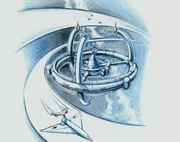
Roy Ritterhouse drawing of "Deep Space 9" which inspires Benny (drawn by John Eaves )
- For the art department, working on this episode was a thrilling experience. " The art department was very excited about what we were going to be doing for 'Far Beyond the Stars', " reminisced John Eaves . " We had all grown up with the wacky science fiction stories and movies of the Fifties and it was great to have the opportunity to pay homage to the past. " ("Far Beyond the Drawing Board", Star Trek Monthly issue 54 )
- "Far Beyond the Stars" was a particularly different episode for Star Trek: Deep Space Nine to work on, necessitating a lot of collaborative effort. John Eaves remembered, " Doug Drexler , Mike and Denise Okuda , and Anthony Fredrickson were all very busy working on the magazine covers and background art. Jim Van Over created the Fifties style version of the Deep Space Nine station. Fritz Zimmerman and Tony Bro designed these fabulous office sets representing Fifties New York City. Laura Richarz had a field day finding circa Fifties decor, and Herman Zimmerman and Randy McIlvain were busy doing the production design on the whole project. I got the task of doing the pack of drawings that the stories were to be written from. " ("Far Beyond the Drawing Board", Star Trek Monthly issue 54 )
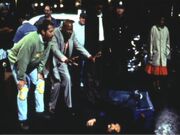
Avery Brooks sets up a shot on the set of "Far Beyond the Stars"
- In terms of why Avery Brooks was chosen to direct this episode, Supervising Producer Steve Oster explained, " Ira Steven Behr and I discussed the possibility of Avery directing, knowing that he was going to be in every frame of film. We don't like that combination, because it's very hard to direct yourself. However, this was a story about racism and prejudice and we felt very strongly that it would be wrong if it came from a bunch of people who didn't necessarily know about that experience. We knew that it was imperative to the story and imperative to the integrity of television for it to be done right. " ( Star Trek: Deep Space Nine Companion (p. 535-536)) Additionally, Oster reflected, " Originally, on our director's schedule for that season, Avery wasn't scheduled to direct 'Far Beyond the Stars', and I think as we talked about it more, it became clear, we can't not have Avery direct that episode, because it's all about representing this struggle in our country's past and, in some instances, the present. " Regarding how the invitation itself was given to him, Brooks himself recalled, " Ira Behr came to me. He said, 'I have this idea, and I wanna know whether you are interested, because you will be in front of the camera, but I also wanna know if you wanna direct.' I said, 'Well… okay. " ( What We Left Behind )
- Avery Brooks was pleased to be given the assignment of directing this episode. " You know, because of the writing of it, because it talked about 1953, because it talked about who we are or who we were, this idea of this brown man, writing this science fiction, I thought that was incredibly clever, " he enthused. ( What We Left Behind )
- Of course, one of the tasks Avery Brooks had in directing this episode was making its 1950s setting appear convincing. Michael Dorn stated, " Avery spent a lot of time and effort to make it look like the fifties. " ( Mission Inquiry: Far Beyond the Stars , DS9 Season 6 DVD special features)
- Upon filming the scene in which Benny Russell falls to the ground, Avery Brooks became extraordinarily involved in delivering his performance. Ira Steven Behr commented, " Avery was so deeply into the character that he went down and stayed down. " First Assistant Director Lou Race recalled shooting the scene; " He falls to the floor, and I'm saying, 'Well, I gotta say cut. But how long should I let this go on?' " Nana Visitor related, " They called cut, and he's… not coming out, and I know what that feels like as an actor. You're gone, and he was… he was gone. " Added Lou Race, " If I'd stood there for half an hour, I think he would have kept on. He was very committed to that part and very committed to that scene. " ( What We Left Behind )
Reception [ ]
- Ronald D. Moore said, " In my humble opinion, I think it's one of the best episodes in the entire franchise. (And I wish I was the one who wrote it!) Ira & Hans have written a true classic and when this show is long gone, I hope that people will still remember this one. " In particular, Moore singled out the ending. " I always liked the idea that all of DS9 may be nothing more than the fevered imaginings of Benny Russell. I still get a kick out of the ending and think it is one of the key ingredients to elevating the show to something very special. " ( AOL chat , 1997 )
- Appropriately, this episode first aired during Black History Month . According to Ron Moore, this wasn't planned – " Just a happy coincidence. " ( AOL chat , 1997 )
- This episode was nominated for three Emmy Awards : Outstanding Art Direction for a Series, Outstanding Costume Design for a Series ( Robert Blackman ), and Outstanding Hairstyling for a Series. According to the Star Trek: Deep Space Nine Companion (p. 537), everyone who worked on the episode felt that Avery Brooks gave an Emmy-award-winning performance, and there was a great deal of disappointment amongst both cast and crew when he wasn't even nominated.
- Ira Steven Behr reckoned that most fans didn't realize Avery Brooks had gotten as deeply as he did into playing Benny Russell's breakdown. ( What We Left Behind )
- Zicree commented: " I was thrilled at the bravery. It was Ira Behr who was entirely responsible for that story existing because he went to bat for it. He had to convince Rick Berman and Paramount. This was going to be overtly about racism and Jake's character is a teenager who breaks into a car and gets shot by racist cops. And now watching it twenty years later it has amazing resonance, it has more power now than it did then. It was courageous for a major studio to do that on a major science fiction show. " [3]
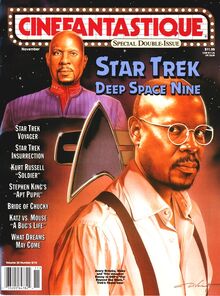
The Cinefantastique cover honoring the episode
- Cinefantastique ranked "Far Beyond the Stars" as the seventh best episode of Star Trek: Deep Space Nine . Cinefantastique honored the episode with a cover image in 1999 . ( Cinefantastique , Vol. 32, No. 4/5, p. 99-100)
- Empire Magazine placed "Far Beyond the Stars" third in a list of the top fifty Star Trek episodes. [4]
- Adam Nimoy , son of Leonard Nimoy , commented, " One of my favourites is 'Far Beyond the Stars' – but, y'know, you've got to know who they are to understand and get that episode. That's absolutely of the best television ever made, but you've got to know […] the history to appreciate what's going on. " [5]
- This episode has been repeatedly screened by Professor John Putman, of San Diego State University, to his students. " Of course in my classroom, using Star Trek: Deep Space Nine , particularly the episode 'Far Beyond the Stars', that is where I really bring in the experiences of the early 90s [concerning racism and social unrest]." ( What We Left Behind )
- Michael Chabon commented: " One of my favorite episodes of any Star Trek ever is the episode of Deep Space Nine , 'Far Beyond the Stars'… [It] squarely takes on the subject of race and racism in America, not in the future, in the past, in a really interesting way, but in a way that also clearly resonates on many levels with science fiction fandom as it currently exists or as it existed when that episode of Deep Space Nine was made. You know, that's what Star Trek 's for, in addition to all the other things that it may be for. " [6]
- Chabon also described this episode, along with TNG : " The Inner Light ", as "two of my favorite episodes of television, period." [7]
- Kirsten Beyer commented: " Can't get enough of Benny Russell. 'For all we know he's out there right now dreaming of us'. It feels classic while being entirely meta. I love how it doesn't shy away from the implications of race in the period and the tragedy of Russell's ultimate fate. " [8]
- In 2022, BBC Culture called it " the most remarkable Star Trek episode ever made. " [9]
Star Trek and science fiction [ ]
- Of this episode's relationship with the pioneering science fiction of the 1950s, Director Avery Brooks commented, " It presented a page of our history, from a time when science fiction was becoming a part of the mainstream. And when we talk about those writers, we're talking about the reason that we're even here! " ( Star Trek: Deep Space Nine Companion (p. 534))
- According to an interview in Star Trek Monthly issue 40 , the Incredible Tales staffers were based on various real-life genre authors. For instance, Albert Macklin was intended as an homage to Isaac Asimov . Indeed, Albert's first novel was to be published by Gnome Press , as was Asimov's debut book in 1950 – a collection of short stories entitled I, Robot . Kay Eaton , who wrote under the name "K.C. Hunter" to hide her gender, was a version of Catherine Moore , who similarly wrote under the name "C.L. Moore", as well as Star Trek 's own D.C. Fontana , who wrote for Star Trek: The Original Series .
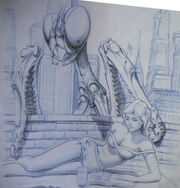
"Honeymoon on Andoris"
- The drawing titled "Honeymoon on Andoris" (which depicts a giant praying mantis scaling a skyscraper to find a beautiful woman at the top) is a parody of King Kong . This drawing may also be a reference to the novella The Savage Swarm by Harlan Ellison . [11]
- When Benny Russell enters the office on the day his story is to be published, Kay and Julius Eaton are discussing their story and Kay suggests the title "It Came from Outer Space", to which Julius responds positively, adding, " I wish I'd thought of it! " This is a reference to a 1953 Jack Arnold film of the same name , which was written by famous sci-fi author Ray Bradbury .
- Although Incredible Tales is a fictional magazine created for the episode, their competitor magazine Galaxy Science Fiction was an actual science fiction digest magazine published from 1950 to 1995 , and it featured writing from such greats as Robert A. Heinlein , Ray Bradbury, and Theodore Sturgeon .
- A memo from Douglas Pabst above Rossoff's desk reads, " No one would believe that a cheerleader could kill vampires " – a reference to Buffy the Vampire Slayer , a TV show which featured Armin Shimerman in a recurring role. Buffy returned homage to Star Trek in an episode of its last season, with a Spock lookalike.
Star Trek and "Far Beyond the Stars" [ ]
- During a scene where some of the Incredible Tales staff have an argument, Douglas Pabst says that he can't change the world, explaining, " I'm a magazine editor, not a crusader. " In a later argument, Julius Eaton tells them to be civilized and adds, " We're writers, not Vikings . " These lines are homages to the famous " I'm a doctor, not a... " series of quotes perpetuated by Leonard McCoy .
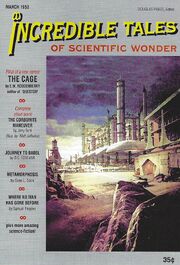
Incredible Tales cover – March 1953
- The cover of the March 1953 edition of Incredible Tales shows the surface of Delta Vega from " Where No Man Has Gone Before ". It also advertises such stories as " The Cage " (written by E.W. Roddenberry , who is also said to be the writer of " Questor "), " The Corbomite Maneuver ", " Where No Man Has Gone Before ", and " Journey to Babel " (written by D.C. Fontana ).
- The offices of Incredible Stories are found in the "Arthur Trill Building", a reference to both the Trill species and the real-life Brill Building .
- The title "Honeymoon on Andoris" is a reference to Andoria .
- A poster outside the Rendezvous Dance Club can be seen advertising " Phineas Tarbolde and the Nightingale Woman," a reference to Tarbolde 's Nightingale Woman mentioned in TOS : " Where No Man Has Gone Before ". The Star Trek Concordance (p. 251) first suggested Tarbolde's first name was "Phineas", later also listed in the Star Trek Encyclopedia (4th ed., vol. 2, p. 371).
Deep Space Nine in 1953 [ ]
- There was some talk that the final scene of " What You Leave Behind " would feature Benny Russell sitting outside a sound stage holding a script that read Star Trek: Deep Space Nine , essentially making the series, and all of Star Trek , a dream . ( Star Trek: Deep Space Nine Companion (p. 537); Cinefantastique , Vol. 32, Nos. 4/5, p. 99) Hans Beimler commented, " At one point we were considering ending the series with Benny Russell walking the station, what he imagined. But Benny Russell was something that was introduced in the sixth season . It's important that this series be a seven-year arc, not a two-year arc, so to end on that note I think would have been inappropriate. It's an interesting way to go, [though]. " ( Cinefantastique , Vol. 32, Nos. 4/5, p. 86) Recalled Ira Steven Behr, " At one point I pitched the idea that at the end of the series everything would have been from the imagination of Benny Russell. Of course they wouldn't let me do that – it would have taken away the entire franchise. But what's so crazy about the idea that DS9 was part of Benny's mind? It's part of Rick Berman 's mind and Michael Piller 's mind and my mind, Robert [Hewitt Wolfe] 's mind, Hans [Beimler] ' mind, René [Echevarria] 's mind, and Ron [D. Moore] 's mind. So of course it's part of someone's mind. " ( The Fifty-Year Mission: The Next 25 Years , p. 526)
- Zicree commented: " It would have been very interesting, but it would have screwed up all of Star Trek 's chronology. Rick Berman is right to say if DS9 is a dream, then what about the original Star Trek , what about Next Gen , what about the shows coming down the pike? Are they all dreams of Benny Russell. Ira said he doesn’t care about the other shows. But, in reality, it would have been a strange, strange, strange oddity. So, I guess Rick was right. It would have been interesting and daring but would have hugely pissed off the fans. I think it would have been interesting and I certainly would have admired Ira’s guts for doing that. I would have got a character payment for Benny, but in retrospect, it is okay that they didn’t do that. " [12]
- Benny is in the office, discussing his story, when his world and that of Sisko begin to merge. This begins with Darlene Kursky ( Jadzia Dax ) referring to the woman with a worm in her belly, after which K.C. Hunter momentarily becomes Kira Nerys as she compliments "this major of yours," and Roy Ritterhouse (Martok) says he wants to sketch the Cardassians in Benny's story. Furthermore, Michael Dorn ( Willie Hawkins and Worf ), Jeffrey Combs ( Kevin Mulkahey and Weyoun), and Marc Alaimo ( Burt Ryan and Dukat ) all appear for brief moments, wearing their usual make-up at various points.
- The rivalry between Douglas Pabst (Odo) and Herbert Rossoff (Quark), Albert Macklin (Miles O'Brien) having an affinity for machinery (Macklin wrote about robots; O'Brien was an engineer), and the depictions of Burt Ryan ( Dukat ) and Kevin Mulkahey (Weyoun) as villains are parallels of the Deep Space Nine plot.
- Herbert Rossoff calling Douglas Pabst a "fascist" mirrors Quark calling Odo one in the previous season in " The Ascent ".
- The Benny Russell plot continues in the seventh season episode " Shadows and Symbols ", although that vision is sent by the Pah-wraiths . Casey Biggs ( Damar ) appears as Doctor Wykoff at that time, continuing the practice of having characters in the Benny Russell version of the world be parallels of antagonists in the DS9 plot.
Other trivia [ ]
- This is the first time Kasidy Yates appears since " Rapture " in early season 5, despite her close bond to the Siskos in that episode (the long gap between that installment and this one was due to Penny Johnson's obligations to The Larry Sanders Show ).
- This is the only episode in Star Trek directed by the episode's lead actor to depict the actor's character heavily; Star Trek V: The Final Frontier has a similar distinction, being directed by leading actor William Shatner . Similarly, Star Trek III: The Search for Spock was directed by Leonard Nimoy , though his version of Spock has less screen time than in the also-Nimoy-directed Star Trek IV: The Voyage Home . Usually, when an actor directs, their character has a very small role (such as Brooks' role in " Tribunal ", Rene Auberjonois' role in " Prophet Motive ", Alexander Siddig 's role in " Business as Usual ", Patrick Stewart 's role in " In Theory ", etc.), rather than, as in this episode, the same person directing also playing a prominent lead role.
- This is the only Star Trek episode to contain the racial slur "n*ggers"; in this episode, it is said by Jake's character, Jimmy, in reference to his belief that black people will never get into space except to shine white people's shoes. Also unique is the utterance " For Christ's sake, " by the character Douglas Pabst. Both of these have been censored in re-airings.
- The song playing over the first Benny scene, the argument with the newspaper boy, is " The Glow-Worm ", written by Paul Lincke in 1909. It was recorded in 1952 by the vocal group Mills Brothers and reached number one in the pop charts that same year.
- "Far Beyond the Stars" is most probably referencing the story surrounding the production of the comics " Judgement Day ", written by Al Feldstein and drawn by Joe Orlando, in which an astronaut working for the Galactic Republic (an equivalent of the Federation) assesses a planet of robots for joining and ultimately rejects their candidature due to their color-based racism. In the very last panel of the comic, the astronaut is revealed to be black of skin, with the text reading, " And inside the ship, the man removed his space helmet and shook his head, and the instrument light made the beads of perspiration on his dark skin twinkle like distant stars … " The Comic Code Administrator, Judge Murphy, required of the editor, Gaines, to censor the black character. Feldstein reported having replied to the judge, " For God's sakes, Judge Murphy, that's the whole point of the goddamn story! " The story was eventually printed uncensored despite the judge's opposition, but the magazine suffered from this daring act.
- When Benny lists famous black writers and their works, he mentions the 1940 Richard Wright novel Native Son . In the same year as "Far Beyond the Stars", Avery Brooks appeared in the Tony Kaye film American History X , in which Brooks' character also had a strong affinity for Wright's novel and introduced it into the school curriculum.
- The quote from the Bible at the end of the episode is from 2 Timothy 4:7 . The full passage reads, " For I am already on the point of being sacrificed; the time of my departure has come. I have fought the good fight, I have finished the race, I have kept the faith. Henceforth there is laid up for me the crown of righteousness, which the Lord the righteous judge, will award me on that day, and not only to me, but also to all who have loved his appearing. "
- John Eaves stated in an interview that he was in charge of the Deep Space Nine drawing getting its footprint , and to accomplish this he saw a woman in the corridors wearing Combat Boots, and asked her to stamp on it, He didn't realise until he was told later but it was Jeri Ryan in costume, as she was filming the " The Killing Game, Part II " at the time and that was part of Her French resistance costume. [13]
- This episode was adapted in the novelization Far Beyond the Stars .
- Remastered scenes from "Far Beyond the Stars" are featured in the documentary What We Left Behind .
Video and DVD releases [ ]
- UK VHS release (two-episode tapes, CIC Video ): Volume 6.7, 6 July 1998
- As part of the DS9 Season 6 DVD collection
- As Avery Brooks' episode choice in the Star Trek: Fan Collective - Captain's Log collection
Links and references [ ]
Starring [ ].
- Avery Brooks as Benjamin Sisko and Benny Russell
Also starring [ ]
- Rene Auberjonois as Douglas Pabst
- Michael Dorn as Worf and Willie Hawkins
- Terry Farrell as Jadzia Dax and Darlene Kursky
- Cirroc Lofton as Jake Sisko and Jimmy
- Colm Meaney as Albert Macklin
- Armin Shimerman as Herbert Rossoff
- Alexander Siddig as Julian Bashir and Julius Eaton
- Nana Visitor as Kira Nerys and Kay Eaton (aka "K.C. Hunter")
Guest stars [ ]
- Brock Peters as Joseph Sisko and The Preacher
- Jeffrey Combs as Weyoun and Kevin Mulkahey
- Marc Alaimo as Gul Dukat and Burt Ryan
- J.G. Hertzler as Roy Ritterhouse
- Aron Eisenberg as a News Vendor
- Penny Johnson as Kasidy Yates and Cassie
Uncredited co-stars [ ]
- Henry Kingi, Jr. as diner patron
- Angus McClellan
- Ambulance driver
- Two ambulance paramedics
- Rendezvous patrons
Stunt double [ ]
- John Lendale Bennett as stunt double for Avery Brooks
References [ ]
1938 ; 145th and Lennox ; 1953 ; 2373 ; Alpha Quadrant ; amateur ; ambulance ; Amsterdam News ; Arthur Trill Building ; artwork ; Asimov, Isaac ; attractive ; Bajor ; Bajoran interceptor ( unnamed ); ballfield ; ballplayer ; baseball ; Bible ; bleacher ; blue plate special ; bongos ; boxing ; Bradbury, Ray ; Brooklyn Dodgers ; Buick Roadmaster Skylark ; Buick Super Sedanet ; Cadillac Fleetwood 60 Special ; cane ; Capitol Cab ; Campbell, Hugh ; Cardassia ; Cardassians ; Cardassian border ; Cardassian space ; cent ; chalk ; cheerleader ; Chevrolet Bel Air ; Chevrolet Suburban ; Christ, Jesus ; coin dispenser ; color ; colored , color blind ; Communism ; Cortez , USS ; Coon, Gene L. ; convict ; cover ; crowbar ; crusader ; cruller ; curve ball ; " Daily News "; deafness ; Defiant , USS ; delivery boy ; DeWaay ; dishwasher ; distributor ; Dodge Luxury Liner Special ; Dominion ; doorstop ; doughnut ; drawer ; dream ; dreamer ; DuBois, W.E.B. ; Dugler, Rex ; editor ; earrings ; Earth ; Eaves, Alicia ; Eaves, Olivia ; egg ; Ellison, Ralph ; Englishman ; Eva's Kitchen ; fantasy ; fascism ; First National ; flying saucer ; Ford Super De Luxe ; frank ; fridge ; From Here to Eternity ; Gnome Press ; God ; Goldberg, Seth ; grand jury ; " grand slam "; gun ; gutting ; H-bomb ; Harlem ; headline ; heart ; Heinlein, Robert A. ; hopscotch ; hot dog ; Hudson Hornet ; Hughes, Langston ; Hugo award ; Hurston, Zora Neale ; iced tea ; imbecile ; Incredible Tales readers ; indictment ; intellectual ; Jackson , Mrs.; janitor ; Japanese Zero ; Jem'Hadar ; Jem'Hadar fighter ( unnamed ); Johnson ; jumper ; Lancaster, Burt ; lemonade ; liberal ; Lincoln Capri ; Lincoln Continental ; Lindbergh, Anne Morrow ; Lindbergh, Charles ; London ; machine gun ; magazine editor ; make-believe ; Manhattan ; Men from Mars ; Mars ; mechanical engineer ; medical tricorder ; mood-o-meter ; Moore ; Municipal Bus Lines ; Nash Statesman ; Native Son ; necklace ; needy ; Negro ; neural pattern ; New York City ; New York Giants ; New York Globe, The ; New York Yankees ; newsstand ; novel ; novella ; nun ; outer space ; Parker, Charlie ; pearl ; Pearl Harbor ; pedestrian ; Peeples, Samuel ; piano ; pie ; pinko ; potato salad ; printer ; Prophets ; publisher ; pulp magazine ; pulp ; Puppet Masters, The ; quote ; race riot ; " Red "; Rendezvous, The ; reporter ; robot ; rocket ship ; sauerkraut ; science fiction ; scrambled eggs ; secretary ; Selected Poems of Langston Hughes ; sequel ; shoeshine boy ; sidewalk ; Sisko's ; skin pigmentation ; Smith Corona ; Snider, Duke ; " Solar Odyssey "; soup ; " Space Mongoose "; " Space Mutant "; spaceships ; Space Voyager ; squadron ; staleness ; Stalin, Joseph ; steak and eggs ; Stone ; Stone Publications ; stop sign ; " strike three "; sunbathing ; Sturgeon, Theodore ; surgery ; Swofford, Quentin ; Swofford's widow ; tater ; tea ; television set ; title ; tone of voice ; " Top cops "; traffic accident ; transport ; Tri-Borough Pest Control ; True Story ; typewriter ; United Nations ; US Air Force ; US Navy ; vampire ; vendor ; Viking ; voila ; volume ; war stories ; Wells, H.G. ; West, Jonathan ; white ; white people ; White Rose Redi-Tea ; whites ; wholesaler ; Wolfe, R. ; Wright, Richard ; writer ; Writer's Monthly ; Xhosa , SS
Incredible Tales references [ ]
" 1001: First Odyssey "; " Assault on Planet 10 "; Astounding Science Fiction ; Atomic Adventure ; " Attack on Planet Eminiar Seven "; " Bad Day at Red Rock "; Behr, I.S. ; Berman ; Beyond the Rim of the Starlight ; Braga ; " Cage, The "; Cogley, Samuel T. ; " Corbomite Maneuver, The "; " Court Martial "; " Dad's Revenge "; " Deep Space Nine "; " Dogs Themselves, The "; Eaves, John ; " Everything I Have Is Yours "; " Far Beyond the Stars "; " Federation and Empire "; " First Contact "; Fontana, D.C. ; " From the Moon to the Earth "; Galaxy ; " Glow-Worm, The "; " Hazardous Images "; Hamner, Robert ; Honest Joe's Used Rockets ; Honeymoon on Andoris ; " I Have No Voice And I Must Shout "; Incredible Tales ; Interstellar Adventure Book Club ; " It Came From Outer Space "; Jefferies, Matt ; Lectroid Attack! ; " Legends of the Ferengi "; " Journey to Babel "; " Loner in a Lonely World "; " Lucifer's Chainsaw "; " Me, Android "; " Metamorphosis "; " Midnight at the Mill "; " Most Fortunate Accident, A "; Phineas Tarbolde and the Nightingale Women ; " Please, Take Me With You " ( characters ); " Quantity of the Monster "; " Questor "; Roddenberry, E.W. ; Sisko, Benjamin ; Sternbach, Rick ; " Strange Martian "; " Third Foundation "; " This Island Mars "; " Trials and Tribble-ations "; " Where No Man Has Gone Before "; " Venusian Chronicles "; " Voyage into the Atom "
Unreferenced material [ ]
Baldwin, James ; Unearthly Stories
External links [ ]
- "Far Beyond the Stars" at StarTrek.com
- " Far Beyond the Stars " at Memory Beta , the wiki for licensed Star Trek works
- " Far Beyond the Stars " at Wikipedia
- " "Far Beyond the Stars" " at MissionLogPodcast.com , a Roddenberry Star Trek podcast
- 2 ISS Enterprise (NCC-1701)
Deep Space Nine's 'Far Beyond the Stars' Is About Star Trek Itself
Deep Space Nine's classic episode 'Far Beyond the Stars' is a moving social allegory about racism, but it's also about the dream that is Star Trek.
- Star Trek: Deep Space Nine 's most unique episode is "Far Beyond the Stars," a story set in a Sci-Fi magazine's offices in 1950.
- One of DS9's most celebrated episodes, it deals with institutional racism at a time when no one else was talking about it.
- Yet, the story of Benny Russell and his Black space captain is also the story of Star Trek itself.
For a 60-year-old storytelling universe, it's nearly impossible to point to a single story that is its most influential and important. However, Star Trek: Deep Space Nine 's Season 6 episode "Far Beyond the Stars" is arguably the entire saga's most important hour. Benny Russell, the character played by actor and episode director Avery Brooks, is a man capable of dreaming up a future his peers cannot comprehend. In a way, Deep Space Nine used "Far Beyond the Stars" to tell a story about Star Trek itself. Though, there are some major caveats.
The episode was conceived from a discarded story pitch from freelance writer Marc Scott Zicree using a common idea from this universe. Jake Sisko, a budding writer , would time-travel to the heyday of the 1950s pulp magazine era to meet with and talk to science fiction writers. The twist was going to be that these writers were, in fact, aliens looking to understand something about humanity. Showrunner Ira Steven Behr didn't want to do it, saying "there was no bottom to the story," in the Star Trek: Deep Space Nine Companion by Terry J. Erdmann with Paula M. Block. However, while driving, he wanted to revisit the concept by making Captain Sisko the central protagonist and use it to tell a story about racism. Since there were no writers of color on the DS9 staff, Behr offered the episode to Brooks as a director. Despite being in every scene, he was as meticulous behind the camera as he was in front of it. So, while this episode is a story about racism, that's not how the director approached it.
Why Benny Russell's Dream of Star Trek Was So Unbelievable
Star trek: deep space nine: when was julian bashir replaced by a changeling.
From the producers to the cast, "Far Beyond the Stars" is often cited as their favorite or the "best" episode they worked on, because of its powerful themes. "You know, the people talked about 'it was about racism,'" Brooks said in a Season 6 DVD featurette, "but maybe so, maybe not. This is America…racism is one of the things we deal with, just like sexism…those things are inextricably connected to who we are." But it was also about dreaming of something better , just like Star Trek .
- Avery Brooks directed eight other episodes of Deep Space Nine in addition to "Far Beyond the Stars."
- "Far Beyond the Stars" is the thirteenth episode of Deep Space Nine 's sixth season, which is available to stream on Paramount+
- Star Trek: Deep Space Nine: Far Beyond the Stars by Steven Barnes novelizes the episode of the same name.
Brooks goes on to say, "color has little to do with it," arguing that what made Benny Russell's story -- effectively the show Deep Space Nine -- so inconceivable to his colleagues is the infinite diversity of the setting. Along with a Black space station captain, there were aliens of all kinds living in (relative) harmony with one another. Benny's stories weren't about race but, much like Star Trek itself, a universe where things like appearance, gender identity, and other social constructs don't matter.
It was the "behavior" or the people around him that created the conflict that caused Benny to break down in tears by the end of the episode. The day he finally convinces Pabst, the "villain" of the piece, to publish his story, he's brutally beaten by two police officers. The day his issue is supposed to be published, Benny learns the publisher destroyed all copies of the magazine rather than tell his story of an integrated future. It's an interesting meditation on what might have happened if Star Trek hadn't been conceived of by a middle-aged white man.
Gene Roddenberry Created Star Trek in an Attempt to 'Manifest' That Future
Lower decks perfectly honors star trek's obsession with caves.
In 1964, when Gene Roddenberry first started pitching his " Wagon Train to the stars" to networks, television was a new medium. His previous series, the short-lived The Lieutenant had an episode (starring future Uhura actor Nichelle Nichols ) dealing with racism. Much like Benny's story, the network decided not to air it rather than allow such a thing to be shown to viewers.
Convinced of television's power to influence its audience, Roddenberry decided couching his social allegories in science fiction was a way to sneak subversive stories onto the airwaves watched by millions of Americans. Some episodes of The Original Series , like Season 3's "Let That Be Your Last Battlefield," were not subtle. The battle between a race of people who were half-black, half-white, and vice versa destroyed their world.
- Star Trek included television's first interracial kiss between Lt. Uhura and Captain Kirk in the episode "Plato's Stepchildren"
- Star Trek: The Original Series was one of the first major television series to feature a multiracial main cast.
- Star Trek 's diverse cast was always meant to represent the entirety of humanity.
Yet, much of what Star Trek did flew under the radar of mid-20th Century America. The mere presence of George Takei's Sulu, an Asian man without an accent, or Nichols' Uhura, a woman of color in a leadership role, was truly subversive. People could accept a green-blooded man with pointed ears more than they could've accepted Number One, the woman first officer of the Enterprise lost when the pilot was reshot. It's something Benny Russell could relate to.
'Far Beyond the Stars' Is as Relevant Today as It Was in the 1990s
Sisko is a better star trek captain than he's given credit for.
One thing that attracted Brooks to this story was its setting in 1953. Along with racism, sexism abounded. Nana Visitor plays Kay Eaton, a woman writer who published under the name K.C. Hunter, much like real-life Star Trek Dorothy Fontana used the pseudonym D.C. Fontana. "If we had changed the people's clothes," Brooks said in the Deep Space Nine Companion , "this story could be about right now." Rather than making it "about racism," Brooks said he "showed how these intelligent people think, and it all came out of them."
Nearly 30 years later, the episode became more relevant than ever. The documentary The Center Seat: 55 Years of Star Trek was released in 2021, one year after demonstrations protesting racial brutality at the hands of police took place across the U.S. Jake Sisko actor Cirroc Lofton said, "in case you haven't been paying attention to the headlines [police brutality] hasn't gone away." Deep Space Nine flipped the script by using the past to tell the story of why Star Trek 's future is as important as it is distant from the present day.
The Original Series only got three seasons on the air in its first run, which is unfortunately further than it ever would've gotten had a man like Benny Russell been its creator. Instead of flying into a rage, as Roddenberry was alleged to have done from time to time, Benny breaks down into tears. When he realizes his story will never see the light of day, he tells his editor "The future is real--I made it real!" pointing to his head. Roddenberry and the other Star Trek storytellers were dreamers, but, as is said in the episode, Benny Russell is both "the dreamer and the dream."
Deep Space Nine Foreshadowed Star Trek's Future If Not Our Own
Star trek: lower decks paid off a deep space nine character arc.
While the world today is still facing the same issues 70 years after the year in which "Far Beyond the Stars" is set, the Star Trek franchise got the point, at least. When the saga returned to television after a dozen years off-the-air, the series lead of Star Trek: Discovery is a Black woman . The writers' rooms and the directors behind the camera became more diverse than they were back in the 1990s. The shows are finally including stories about sexual and gender identity, something the 1990s shows were terrified to touch.
Star Trek has high-minded ideals at its core, but it's made by fallible human beings. "Far Beyond the Stars" acknowledges this as well through its ancillary cast. Armin Shimmerman plays Herb Rostoff, a Jewish-coded character who was a communist. He stands up for Benny at first but backs down when his own position is threatened. Alexander Siddig played Julius Eaton, as Brooks described him "a Brown man with a British accent," who is aloof about Benny's ordeal.
These writers understood the injustice being done, but nonetheless let Benny stand alone, indirectly supporting the status quo. Thankfully, the Star Trek of today is more inclusive, from the folks behind the scenes to the quality of stories given to historically underrepresented demographics. In a way, "Far Beyond the Stars" wasn't just an indictment of the real world, but also how Star Trek itself sometimes failed its own ideals. It's why, nearly three decades later, it's still the most powerful episode of Deep Space Nine .
Star Trek: Deep Space Nine
In the vicinity of the liberated planet of Bajor, the Federation space station Deep Space Nine guards the opening of a stable wormhole to the far side of the galaxy.
Star Trek: Deep Space Nine
Far Beyond the Stars
Cast & crew.
Brock Peters
Joseph Sisko/Preacher
Jeffrey Combs
Weyoun/Officer Mulkahey
Marc Alaimo
Gul Dukat/Officer Ryan
J.G. Hertzler
Gen. Martok/Roy Ritterhouse
Aron Eisenberg
Ensign Nog/Newspaper Vendor
Information
© 2011 CBS Corp.
Accessibility
Copyright © 2024 Apple Inc. All rights reserved.
Internet Service Terms Apple TV & Privacy Cookie Policy Support
'DS9's “Far Beyond the Stars” Remains One of Star Trek’s Most Relevant Episodes About Race
An episode from the 1990s feels particularly reminiscent of today’s pop culture discourse.
In the Star Trek: Deep Space Nine Season 6 episode “Far Beyond the Stars”, Captain Benjamin Sisko ( Avery Brooks ) is at a precipice—the Federation is in the midst of a war that has no end in sight, and worse, people he was close to keep dying. Sisko doesn’t see the point of his work anymore, but just when he begins losing faith in his job as a Starfleet captain, Sisko finds himself transported into a vision where he is a Black science-fiction writer in the 1950s. And thus begins one of Star Trek’s most poignant, and meta takes on race and inequality in America.
What Is Far Beyond the Stars About?
“Far Beyond the Stars” is a heart-rending story of a Black man whose dreams of publishing a story with a Black lead are constantly quashed. In the vision, Sisko is Benny Russell, and his colleagues and friends from Deep Space Nine transform into characters in Benny’s life. Benny works at Incredible Tales, a science-fiction publication owned by the unseen Mr. Stone, and edited by Douglas Pabst ( René Auberjonois ). It’s obvious from the early moments of the vision that the world Benny inhabits is unequal, not just for him, but for others as well. In our first introduction to the Incredible Tales editorial room, Julius Eaton (played by Sudan-born British actor Alexander Siddig ) is shocked to learn his white colleague Herbert Rossoff ( Armin Shimerman ) is earning four cents a word for his stories.
Later, Pabst mentions that magazine readers want to know what the writers look like and hence they’ll be taking photos of them. And then he immediately turns to Kay Eaton ( Nana Visitor ) and tells her to stay home the day of the photo shoot. Kay is a female writer who writes under the ambiguous moniker K.C. Hunter to hide her identity—this is a direct reference to Star Trek writer D.C. Fontana, who had to do the same, but also a reminder of how far the franchise has come. Kay is rightly incensed, but then Benny asks if he should stay home as well. It’s interesting that Pabst doesn’t even think to make the request of Benny; it’s almost as though Benny’s absence is a given, and he doesn’t deserve such courtesy.
The Racial Discrimination Doesn’t End at Incredible Tales
A running theme of the episode is Willie Hawkins’ ( Michael Dorn ) exploits on the baseball diamond. He’s clearly doing better for himself than Benny if his sharp suits are anything to go by. But despite being a renowned baseball player, when Benny’s girlfriend Cassie ( Penny Johnson Jerald ) asks why Willie hasn’t moved out of Uptown, Willie explains that he’ll never be accepted in the city, or treated like an equal. In Uptown people look at him with pride, that is unfortunately not the case elsewhere. Racism permeates every echelon of society, as Willie’s story demonstrates.
The microaggressions that Benny faces at work are only compounded by the political situation outside. Benny lives in a predominantly Black neighborhood Uptown. The residents are plagued by police who are blatantly discriminatory. Benny encounters two particularly vile cops, Officer Mulkahey ( Jeffrey Combs ) and Officer Ryan ( Marc Alaimo ), who accuse Benny of stealing a sketch that belongs to him and even threaten to arrest him. For what? Instances of excessive policing, threats, and violence are daily news in the US. “Far Beyond the Stars” came out in 1998, and yet it feels like a reflection of today. The trigger-happy cops eventually shoot Benny’s friend Jimmy ( Cirroc Lofton ), a hustler who may (or most likely may not) have been breaking into a car. But instead of simply arresting Jimmy, the cops shoot him dead, and when Benny intervenes, they beat him almost to death. Benny ends up recuperating at home for weeks and appears to have life-altering injuries, simply because he came between two officers and their bigotry.
Benny's Life Is Shockingly Familiar
Benny’s life is shockingly similar to our present-day—being underpaid and underappreciated due to the color of his skin, dealing with police harassment, losing friends, and almost his own life, to police violence. But the theme of the episode isn’t simply a showcase of racism. No, Star Trek has always been about holding a mirror to the world as it was and projecting hope into the future. The episode is ultimately about a dream, and whose dreams are allowed to come true.
Benny is a writer and when struck with inspiration, he writes his sci-fi truth, about Deep Space Nine , a story set in the future with a Black captain. His colleagues are enwrapped, but Pabst is unmoved. He likes the story but doesn’t think it’s believable because the hero is Black. People from Mars are believable, but a Black captain? The memes write themselves.
RELATED: 'Star Trek: Deep Space Nine' Actors Share BTS Details From Returning for 'Lower Decks'
As editor and the man who has to answer to the higher-ups, Pabst is overly cautious—he’s a gatekeeper curating what the audience will enjoy without giving them a choice. Since Pabst believes the Deep Space Nine story could be incendiary, the Incredible Tales team comes together to suggest alternatives, until finally concluding that Benny turn it into a dream. Even Pabst is convinced by the change and promises to pay Benny for the story. But, in the end, the issue with Benny’s story is ‘pulped’ by Mr. Stone and Benny is fired. For 15 years, Benny has been trying to get his big break in writing, and just when he thinks he’s made a difference, the powers-that-be destroy his dreams. Interestingly, Albert Macklin ( Colm Meaney ), Benny’s other white colleague, sells his book to a publisher while Benny is recovering from his injuries, though his stories haven’t been as resoundingly well-received as Benny's.
News of the pulping is shocking to the editorial team but coupled with his firing, Benny is driven to speak his mind openly. Benny’s impassioned speech, delivered with such emotion and raw pain by Avery Brooks, is heartbreaking. He is a human being who deserves to have an equal chance to tell a story, to share an idea, or to dream. He pleads for Pabst, Mr. Stone, and the viewer to see a future where Black people are leading characters in stories; where they can simply exist. Watching “Far Beyond the Stars” feels particularly prescient of current discourse surrounding genre properties. In light of the reactions to any diversity in media, be it Halle Bailey’s casting as Ariel in the live-action version of The Little Mermaid or Black actors playing Elves in Rings of Power , an episode like this demonstrates how dehumanizing it can be for entire communities to be erased from entertainment, and how this impacts the way those communities are treated in their workplace and in the world.
Of all the characters in the 1950s timeline, Jimmy is the most cynical. He constantly mocks Benny’s science-fiction writing because he doesn’t believe that there will ever be a future where Black people will be ‘on the moon;' that is, not unless white folks need someone to ‘shine their shoes.’ Despite being a young man, Jimmy can’t imagine such a world because he has no context to dream big—he doesn’t have stories and entertainment that show him he too belongs in space. And that’s the fight that Benny, and all creators of color, are constantly fighting for.
The Episode Shows Us How Power Dynamics Can Affect the Entertainment We Consume
Benny’s colleagues are supportive of him, and Herbert goes out of his way to antagonize Pabst for toeing the company line. But all that support comes to naught if the decision-makers are bigoted. Benny dared to dream, and he was punished for it. But his struggles teach Sisko a valuable lesson to persevere in his dreams.
“Far Beyond the Stars” mirrors the strides that Star Trek made (and continues to make) to cast actors of color in the franchise. Star Trek was a game-changer in popular media, there’s no denying that. Nichelle Nichols ’ appearance in the original series as Lt. Nyota Uhura inspired an entire community to dream. The franchise isn’t perfect, but it continues to evolve by making more people of color and the LGBTQ+ community a visible part of the shows, be it on-screen or behind the scenes.
At a time when New Trek, Star Wars , superhero stories, and The Little Mermaid are constantly under attack for being too ‘woke’ simply for having a representative cast, “Far Beyond the Stars” is a powerful reminder about what genre fiction has always been—ideas and hopes for the future. Despite attempts to review bomb properties and vile Twitter threats, as Benny Russell says, ‘you cannot destroy an idea.’
- Show Spoilers
- Night Vision
- Sticky Header
- Highlight Links

Follow TV Tropes
http://tvtropes.org/pmwiki/pmwiki.php/Recap/StarTrekDeepSpaceNineS06E13FarBeyondTheStars
Recap / Star Trek: Deep Space Nine S06E13 "Far Beyond the Stars"
Edit locked.

Benjamin Sisko is now Benny Russell, an African-American writer for the Incredible Tales magazine, discussing comics with a newspaper vendor (Nog) before heading to work with his co-worker, Albert Macklin (O'Brien). Joining Benny in the office is Kay and Julius Eaton (Kira and Bashir), Herbert Rossoff (Quark), editor Douglas Pabst (Odo), and artist Roy Ritterhouse (Martok). One sketch by Ritterhouse resonates with Benny: a space station. When a memo goes around the office that pictures of the writers are being requested, both Benny and Kay are asked to "sleep in late" by Pabst. As far as the readers know, Kay (who writes under a pseudonym) is a man and Benny is white, and Pabst would prefer to keep it that way, to Benny's chagrin. The ugly truths of the era's prejudices continue to rear their ugly heads when, while walking home from work, Benny finds himself confronted by two racist police officers ( Dukat and Weyoun).
On his way home, Benny is singled out by a preacher (Joseph) who espouses the glory of the Prophets, and beseeches Benny to write the truth in his heart. Moved by the preacher's words and inspired by the drawing of the space station, Benny immediately sets to work in his modest apartment writing a story. As he comes up with the name of his protagonist, "Benjamin Sisko," he opens the blinds to look out the window, but rather than seeing his own reflection, for a brief moment, he sees his protagonist, Sisko.
Benny finishes his story and shows it off to his friends at a diner the following morning: Cassie (Kasidy), a waitress and his girlfriend; Willie Hawkins (Worf), a rising baseball star combating prejudice in the major leagues; and Jimmy (Jake), a disillusioned petty criminal. Jimmy isn't so sure that the story would make print. The suspicion is confirmed when, even though most of Benny's coworkers commend his story, Pabst takes umbrage with the protagonist of Deep Space Nine and refuses to print it on the basis that the lead character is black.
Benny is disheartened. Walking home that evening, he is approached by the preacher once more, asking Benny to walk with the Prophets and to write the words that would lead them to righteousness. Undeterred, Benny sets to work writing a new story, typing into the night another story of the adventures of Benjamin Sisko. Throughout the next couple of days, Benny keeps having strange visions, seeing the people in his life as characters from his story; Kay as the feisty Kira, Willie as the proud warrior Worf, and Cassie as Sisko's love interest Kasidy. These strange visions distress him greatly, leading Benny to think he's losing his grip on reality and becoming Sisko .
The following day, Pabst explodes on Benny for continuing to write Sisko stories. Albert suggests ending his story as though it was all a dream, which may be the only chance that Benny has to have the story published at all, so he leaps at the opportunity. Beside himself with joy at finally having found success in his writing, Benny goes out partying with Cassie to celebrate. He is approached once more by the preacher, who cautions Benny that this is only the beginning, and the path of the Prophets would lead into darkness and despair.
Shortly afterwards, gunfire rings out. Benny goes to investigate and sees Jimmy dead on the streets, shot while trying to break into a car by the police officers that harassed him some nights before. The two officers brutalize Benny and beat him within an inch of his life for hitting one out of anger, with Benny seeing them as the villains of his story.
After taking a few days to recover, Benny heads back to the office to see his story finally hit the shelves. Unfortunately, when Pabst returns from the presses, Benny learns that the entire magazine had been pulped by the publisher. Benny believes the magazine was pulped because of his story. To make matters worse, the publisher has also fired Benny. Benny finally loses his grip, calling out everyone in the room and passionately defending not only his humanity, but Sisko and everything pertaining to Deep Space Nine : "You can pulp a story, but you can't destroy an idea!"
Benny suffers a nervous breakdown and is taken away in an ambulance. While being taken to a hospital, he is approached one last time by the preacher, who commends Benny for walking in the path of the Prophets. When Benny looks out the windows of the ambulance, he sees a field of stars zooming by him as the Prophets' preacher calls him "the Dreamer, and the Dream."
- There's a note from the editor on Herbert's desk rejecting the idea of a story about a cheerleader who kills vampires. Armin Shimerman was playing Principal Snyder in Buffy the Vampire Slayer at the time.
- Albert is an artist. The actor, J.G. Hertzler is also an artist who was known to make sketches of the cast and productions during his downtime. Albert's drawings used in the episode, however, were not made by Hertzler.
- Probably. Sisko does wonder at the end whether his vision of Benny was all fantasy or whether Benny's vision of Sisko is the fantasy. And it was actually intended for a bit to reveal at the end of the series that the entire show (and presumably the rest of the Trek franchise) was a story that Benny wrote.
- One of Benny's colleagues also suggests this as a solution to get his "unrealistic" story about a black captain printed by adding a dream reveal at the end. The publisher still rejects it.
- Ambiguously Christian : Russell is shown wearing a taqiyah, which was strongly associated with the Nation of Islam during the 50s, yet also seems taken-in by the Christian street preacher.
- The newspaper vendor is excitable and in business for himself, much like Nog.
- Kay is headstrong and pulling her weight in a traditionally male role, just like the freedom fighter Major Kira.
- Julius is scholarly and even-tempered, much like Julian.
- Herbert puts principles over business, quite the opposite of Quark, but he does quarrel with his universe's equivalent of Odo and bristles at the insinuation that he's a communist.
- Albert is meek and tongue-tied, unlike the loud and bull-headed O'Brien, but he is interested in robots, something an engineer could sympathize with.
- Roy is blunt and irreverent, much like Martok.
- Pabst is a gruff authoritarian, much like Odo.
- Willie is a physical specimen and feels like an outcast on his team, like Worf in Starfleet, but he's gregarious and always smiling rather than a stiff Perpetual Frowner .
- Jimmy looks down on Benny's fiction and is pessimistic, quite the opposite of the crusading journalist and novelist Jake.
- Cassie is Benny's fiancée and interested in going into business for herself, just like the independent freighter captain Kasidy.
- Darlene is vapid, very much unlike the wise Dax, and thinks that a woman with a worm in her belly is gross.
- The street preacher provides moral guidance for Benny, just like Joseph does for his son.
- The two cops are villains with government backing, just like Dukat and Weyoun.
- As the Good Book Says... : The preacher naturally quotes from it, but Joseph Sisko does too, surprising Ben as he never knew him to do this. It's one of the few references to a real mainstream religion in Star Trek. Joseph: The question is, what are you going to do? Ben: The only thing I can do. Stay here and finish the job I started. And if I fail— Joseph: "I have fought the good fight. I have finished the course. I have kept the faith." Ben: I've never known you to quote from the Bible. Joseph: I'm full of surprises, aren't I?
- Bittersweet Ending : No question, Benny's plight is a straight-up Downer Ending . But when he wakes up as Sisko again, he feels renewed energy toward "fighting the good fight."
- Brits Love Tea : As an Englishman, Julius is unimpressed by one particular vision of the future—instant iced tea!
- Bashir finds that Sisko is experiencing the same synaptic potentials in his brain as he did during "Rapture" .
- Sisko living weeks as Benny Russell within the span of a few unconscious minutes mirrors Picard living years as Kamin in about twenty minutes during " The Inner Light " in The Next Generation .
- Casting Gag : In Sisko's dream, Kay (played by Nana Visitor ) and Julius (played by Alexander Siddig ) are a married couple. In real life Visitor and Siddig had gotten married not long before this episode was produced.
- Celebrity Paradox : One of the writers Benny mentions when reciting the list for the current issue of Galaxy is Theodore Sturgeon , who also wrote two episodes of Star Trek: The Original Series . So you have an episode of Star Trek mentioning a writer who wrote two episodes of the original series.
- Chewing the Scenery : Benny's breakdown when he's fired. He sure seems like he's going to take that table with him.
- Cigar Chomper : Roy Ritterhouse, Martok's character, frequently has a cigar clenched in his teeth. This allows him to affect a similar growling speaking style that Martok uses.
- Continuity Nod : Worf's character, Willie Hawkins, is a No Celebrities Were Harmed version of Willie Mays — same first name, team, and position, same rivalries, similar number (Mays wore number 24, while Hawkins wears number 42). It's not surprising that a Willie Mays-like character might appear in Sisko's vision of 1950s New York given his recent acquisition of Mays' rookie card last season...
- Crapsack World : This episode pulls absolutely no punches about 20th century racism, and the toll it takes on Benny and his friends. Nor the sexism, as the magazine keeps the fact that they have a female writer a secret.
- Dirty Coward : Douglas Pabst is an example of moral cowardice; despite recognising that Benny being discriminated against is wrong, he does nothing about it and discourages Benny from making a fuss. (This is actually a bit of a leg up on his obvious real-world inspiration, John W. Campbell , who was an enthusiastic authoritarian and white supremacist.)
- Food as Bribe : Herbert threatens to quit because the donuts are stale . Pabst lures him back with a promise of fresher donuts tomorrow. "I'll even throw in a couple of crullers."
- Formula-Breaking Episode : The main story of this episode is about a writer facing racism in the '50s, with the main cast playing a different set of roles.
- Framing Device : Sisko's experience as Benny is framed as a vision sent by the Prophets to keep him from losing his resolve.
- Freak Out : Big time. All the racist abuse Benny deals with in his daily life comes out in a furious rant and ends up in a nervous breakdown.
- Heroic BSoD : Sisko starts going into one when he learns that his friend Quentin Swofford has been killed. The vision from the Prophets is meant to help him work through it.
- Benny is based on Samuel R. Delany , whose story Nova was similarly rejected by Analog magazine for having an African-American protagonist.
- Albert Macklin, the writer of robots who eventually sells a novel to Gnome Press, is essentially Isaac Asimov , who sold I, Robot to Gnome Press. (Asimov was also a science consultant on Star Trek: The Motion Picture and inspired the concept of Data .)
- Herbert Rossoff, with his brusque demeanor, outspoken liberal politics, and uncompromising dedication to his craft, is Harlan Ellison by any other scream.
- Kay "K.C. Hunter" Eaton is based on Catherine "C.L." Moore , and the same reasoning underlies the use of initials. For the same reason, she's also a reference to D. C. Fontana .
- Jules Eaton, her husband, is Moore's husband Henry Kuttner , who was one of H. P. Lovecraft 's proteges.
- Douglas Pabst is John W. Campbell , both at his best (a dedicated and influential writer and editor) and worst (eccentric, racist, sexist, and authoritarian). Campbell was the editor who rejected "Nova," and, through his effective monopoly, ensured there was almost nowhere else to go.
- The plot line about Benny's story is also inspired by the real world controversy surrounding the Comics Code Authority's refusal, on openly racist grounds, to allow publication of the EC Comics comic story "Judgement Day", by Al Feldstein and Joe Orlando. The story in question was a Robots Enslaving Robots satire of racism, in which the twist ending was that the disgusted human observer of the racist alien robots, whose face had been hidden in a spacesuit throughout the story, was revealed to be a black man. William Gaines's disgust at this caused EC to finally stop publishing comics altogether.
- Rossoff lists the writers in the September 1953 issue of Galaxy when he threatens to join them: Theodore Sturgeon (writer, "Shore Leave" and "Amok Time" . Also making it a case of Celebrity Paradox ), Isaac Asimov (see above), and Ray Bradbury (who never had a direct association with Star Trek , but he did have a starship on The Next Generation named after him). Sturgeon really was the writer of the cover story of the real-life September 1953 issue of Galaxy .
- Hope Spot : For a time, Benny is overjoyed that it looks like his story will be published after all. Then he's savagely beaten by two racist cops who have just killed Jimmy, spends weeks laid up, returns to work only to learn that the publisher had pulped the entire month's issue of the magazine rather than print Benny's story, and is then fired as well. On top of all that suffering, he suffers a breakdown and is carted away to a mental hospital.
- Hypocritical Humor : Rossoff derides the cliched picture of a scantily-clad beauty menaced by a bug-eyed monster , then immediately picks it for his story. Rossoff: That is the worst piece of garbage I have ever seen. Ritterhouse: Thank you. Rossoff: I'll take it.
- Insane Troll Logic : The idea of a Negro commanding a space station in the future is rejected by the editor because it's not realistic. Rossoff retorts, "And men from Mars are?"
- Irony as She Is Cast : In-Universe . Greedy, hyper-capitalistic Ferengi Quark is cast as Herbert Rossoff, who Pabst suspects of being a communist.
- There's a memo in the writing room criticizing the idea of a cheerleader slaying vampires .
- The Benny Russell story revolves around whether anyone would be interested in a black captain of a space station, which is Star Trek: Deep Space Nine itself.
- Herbert Rossoff is abrasive, self-important, and ill-tempered, but he's also an outspoken progressive and is Benny's staunchest defender, disgusted by Pabst's moral cowardice.
- Willie Hawkins is pretty arrogant and constantly hits on Cassie, but he's friendly enough to Benny and seems genuinely concerned for him when Benny freaks out at one point. He's also quite friendly and appreciative towards his young fans, happily indulging them mobbing him for autographs.
- Leaning on the Fourth Wall : Sisko is looking directly at the camera when he's pondering whether his life is merely the creation of some science fiction writer.
- Mars Needs Women : One of the sketches Roy Ritterhouse comes up with (which the writers then have to create stories for) is of a beautiful, scantily-clad woman being menaced by what looks like a giant praying mantis. The writers scoff at the cliche, but that doesn't stop Herbert from offering to write it.
- Match Cut : Dr Bashir hands Sisko a PADD showing his symptoms, and we instantly cut to Benny being handed a copy of Galaxy in 1950's New York.
- Most Writers Are Writers : In the alternate timeline, most of the main cast members are writers or other staff for a science fiction magazine.
- The Incredible Tales cover also features the Delta Vega station from "Where No Man Has Gone Before", and Galaxy has a painting based on Starbase 11 from "Court Martial" and "The Menagerie".
- Nightmare of Normality : The crux of the episode, with Ben Sisko (Emissary and Starfleet captain) deluded into believing himself a sci-fi writer in the 1950s.
- No Celebrities Were Harmed : The Incredible Tales staffers were based on various real-life genre authors. Benny is Samuel R. Delany , Albert Macklin is Isaac Asimov , Kay Eaton is a mixture of C. L. Moore and D. C. Fontana , Herbert Rossoff is Harlan Ellison , Jules Eaton is Henry Kuttner and Douglas Pabst is John W. Campbell .
- Nothing Personal : Pabst tries to argue this over Benny being excluded from a photograph being published of the staff writers, but Benny certainly takes it personally.
- The Oner : Benny's final speech is delivered in a single, long take.
- Police Brutality : The detectives shoot Jimmy to death because "he had a weapon" (a crowbar used to break into a car) though it's indicated he wasn't actually threatening them. Benny hits one of them in anger over this, and they then brutally beat him, even when he's on the ground. Earlier, they give Benny trouble outside his place of work even though he wasn't doing anything.
- Politically Correct History : Defied, unlike TNG's visit to the past, in which Geordi and Guinan both seem to have no difficulties in Mark Twain 's San Francisco. The widespread societal and institutional racism against African-Americans in the pre-Civil Rights US, both in its subtle and open forms, is openly acknowledged and is the main theme in the episode's plot. Additionally, the second-class status of women is shown.
- Douglas Pabst utters the religious-based epithet "for Christ's sake". This was the first (and to date, only) time it was uttered in Trek franchise history and was one of the few times it had ever been heard on an American commercial television series. Even in the late 2010s it is rarely heard, even on cable/streaming.
- Race Lift : In-universe, Pabst only agrees to publish Benny's story if he changes the captain's race to white. Benny doesn't budge.
- Raygun Gothic : Particularly in the drawing that Roy Ritterhouse does of the space station, which looks just like it would have had the series been created in the Fifties.
- "The Reason You Suck" Speech : Even as he's slipping into a Heroic BSoD , Benny Russell delivers an epic one to Pabst, and by extension the magazine and the entire system, before losing it completely. "To hell with you, and to hell with Stone! [...] Call anybody you want! They can't do anything to me. Not anymore. And nor can any of you. (starts crying) I am a human being, damn it. You can deny me all you want, but you cannot deny Ben Sisko. He exists! That future, that space station, all those people, they exist, in here (points to his head), in my mind. I created it, and every one of you know it. You read it! It's here! You hear what I'm telling you? You can pulp a story, but you cannot destroy an idea! Don't you understand? That's ancient knowledge. You cannot destroy an idea! That future, I created it, and it's real ! Don't you understand? It is real ! I created it and it's real! It's real!" (collapses)
- Red Scare : A newspaper headline announces REDS TEST H-BOMB. Later, Rossoff loses it when Pabst accuses him of being a Communist.
- Schrödinger's Butterfly : The episode ends with Sisko wondering whether he is real or merely the creation of Benny Russell.
- Streaming Stars : As he's being carried off in the back of an ambulance, Benny looks out the rear windows and sees stars streaming past the window like a spaceship at warp.
- Then Let Me Be Evil : Jimmy has chosen to embrace a hoodlum lifestyle, since he feels that white people are always going to treat him as a criminal and/or inferior person just because of his skin color and will never give him any quarter even if he is a perfectly law-abiding and well-behaved citizen, so he has decided that since it is seemingly no use leading an honest life, he might as well try to profit off of dishonesty and crime. Sadly, his choice leads to him being gunned down by racist police officers without just cause.
- United Space of America : The drawing of a space station has USAF markings.
- Visions of Another Self : A nearly episode-long instance of it.
- Vitriolic Best Buds : The writers spend a great deal of the episode sniping at each other (especially Julius and Herbert), but they're clearly fond of each other despite it. When Benny is fired, the entire writing staff rally around him.
- Why Didn't I Think of That? : One of the writers wishes he'd thought of using It Came from Outer Space as a title.
- You Cannot Kill An Idea : Invoked almost word-for-word during Benny's rant.
- Star Trek: Deep Space Nine S06E12 "Who Mourns for Morn?"
- Recap/Star Trek: Deep Space Nine
- Star Trek Deep Space Nine S 06 E 14 One Little Ship
Important Links
- Action Adventure
- Commercials
- Crime & Punishment
- Professional Wrestling
- Speculative Fiction
- Sports Story
- Animation (Western)
- Music And Sound Effects
- Print Media
- Sequential Art
- Tabletop Games
- Applied Phlebotinum
- Characterization
- Characters As Device
- Narrative Devices
- British Telly
- The Contributors
- Creator Speak
- Derivative Works
- Laws And Formulas
- Show Business
- Split Personality
- Truth And Lies
- Truth In Television
- Fate And Prophecy
- Edit Reasons
- Isolated Pages
- Images List
- Recent Videos
- Crowner Activity
- Un-typed Pages
- Recent Page Type Changes
- Trope Entry
- Character Sheet
- Playing With
- Creating New Redirects
- Cross Wicking
- Tips for Editing
- Text Formatting Rules
- Handling Spoilers
- Administrivia
- Trope Repair Shop
- Image Pickin'
Advertisement:
Star Trek: Deep Space Nine : "Far Beyond The Stars"
“Far Beyond The Stars” (season 6, episode 13; originally aired 2/11/1998) In which Benny Russell writes his story…
Related Content
(Available on Netflix , Hulu , and Amazon .)
Metaphors are fine. Metaphors are, in fact, perfectly lovely and useful and amazing tools when it comes to telling stories. I love a good metaphor, because it’s poetic and just plain fun, coming at your brain sideways in order to trick you into understanding an idea by making you think about something else. A metaphor can be a kind of code, a form of subversion that ostensibly secrets a powerful message inside a seemingly harmless framework. Want to talk about the horrors of war without mentioning a specific conflict? Throw on some fake ears and foley in a few laser blasts, and call the whole thing The Battle Of Kanak’Kar or something. Want to discuss sexual orientation and gender issues? Put everything on another planet, with aliens who look just like us but are slightly different, and have a ball. The metaphor becomes not just a tool inside the text, but the text (or visual medium) itself. It creates a cushion of distance between the subject and the presentation, and that distance allows everyone to contemplate potentially divisive or explosive topics from a remove. Maybe you can’t change minds by tricking them, but it’s a start, and it’s better than staying silent, right?
Sometimes, though, a metaphor isn’t enough. Sometimes you need to scream—not talk about screaming, not have someone scream in some different, made-up language that nerds will obsess over for years to come; not couch a scream in diffidence or bury it in poetry. Just scream. Maybe then, someone will hear you.
Star Trek has a long history of using science fiction tropes to deal with social issues. We did a semi-jokey Inventory on the subject four years ago, and it’s always been a symbol of the franchise’s noblest aims—to be more than just an adventure show, to have ambition beyond nifty monsters and star fields. But as admirable as that aim is, it’s too often a clunky, heavy-handed way to moralize. Check that Inventory more closely, and you’ll realize that while most of those episodes (and films) are fun, few of them rank in any of their respective series’ best. Using a metaphor to tackle a controversial issue is an approach that reeks of putting message before story, which can easily turn into an excuse to lecture an audience; after all, most messages come with a specific moral value attached, which means there’s little room for ambiguity or mystery. Force-feeding is rarely an effective means of storytelling or lesson teaching. At the time, it lets everyone pat themselves on the back for being progressive and clever; decades later, it looks pedantic, trite, and more than a little campy.
This isn’t always the case. Star Trek: The Next Generation managed to do issue episodes better than the original series, and some of its attempts are very strong stuff. But even then, the metaphor works best when it deals in broad terms. “Darmok” is a fascinating examination of the difficulties of communication between cultures, and the challenge of finding common ground. You could apply it to any number of disastrous encounters between different races of humankind, but there’s no need to. The fundamental truth transcends the specific. Something like “The Outcast,” which has Riker falling for an androgynous alien from a society where gender distinctions are harshly censured, succeeds, in part, because its soul isn’t just about the persecution of the homosexual or the transgendered. If you want to, you can take a powerful statement on the importance of tolerance and respect for all sexual orientations from the episode. But you can also look on it as a critique of totalitarian governments. Or just a tragedy about Riker losing a friend. By tapping into the universal concepts underlying specific cultural problems, TNG was able to get their point across without being anchored to one view. It’s a potent use of metaphor, and yet there’s a distance to it. The separation between our world and the ones we see on screen means that commentary comes at a remove. The remove makes the criticism easier to take, but it also diminishes its impact. This isn’t personal, the metaphor allows us to believe. We’re only observing. We’re not a part of this.
“Far Beyond The Stars” takes the metaphor and turns it inside out. It is not a subtle hour of television. It has its gimmicks, but the gimmicks are in no way relative to its effect. The double-casting—seeing familiar faces in different roles, seeing actors out of make-up, seeing Michael Dorn smiling—is fun to watch, but there’s something sad about it, too; something lost and awkward and lonely. This is not an episode which holds back. There is no happy ending for its hero. Instead of using the illusions of fiction to cloak or obscure painful realities, writer Benny Russell (Avery Brooks) attempts transcendence. There is no comforting distance between us and his situation, no camouflage for his pain. Even the time (Benny is in 1953 America) isn’t all that far away. There is no protection for an audience eager to cling to its illusions. This is a desperate man’s effort to cling to sanity, to speak and be heard in a place which demands his silence. The metaphor is not there to teach us a lesson about the suffering. The metaphor is there so that the suffering might rise above.
In case the four paragraph preamble to a point didn’t tip you off, I’m not entirely sure how to approach this one. It’s exceptional in a way that makes me nervous about dissection or critique. I’m used to writing silly things about reversed polarity and Cardassians and what not. Racial injustice is not something I feel qualified to discuss. I can’t quote you specifics on the struggles of African American pulp fiction writers from the 1950s, nor can I offer a personal anecdote in any way relevant to the matter at hand. To do the latter would be obscene; not because the episode is some holy, sacred object (I liked it a lot, and it’s grown on me since watching it, but it’s kind of crazy and clunky at times, sort of like this review), but because I, in my limited experience, cannot speak to Benny’s plight. When it’s Sisko, or Bashir, or Odo, or Kira—I get that. That’s easy. But actual systematic prejudice? I’ve had the biological and geographical luck to have been spared such a thing, and while I can empathize (great art makes empathy easier), I'm also reluctant to speak with any kind of authority on the subject.
Part of the value, then, of an hour like this (and yeah, it’s not all set in the past, and the way the script and Avery Brooks’ direction chooses to integrate the “reality” of the show with the “reality” of Benny’s world is quite striking) is by presenting a different perspective from the sort that usually gets center stage in popular entertainment. It’s true that Brooks is the first black lead of a Trek series, and it’s true that Deep Space Nine (much to its credit) has never tried to downplay or ignore this. Yet DS9 takes place in a comparatively utopian future. It’s a more pessimistic show than TNG , but that pessimism doesn’t take away from the fact that the Federation—the dominant “good guy” force—doesn’t discriminate based on race or, one would hope, gender or sexual preference. To the audience, Sisko’s blackness is an important step forward for the franchise, indicating a broader acceptance of non-white protagonists. In the context of the show, though, it’s just another part of who he is; it matters, but it doesn’t define him in the eyes of those around him. There’s something refreshing about that, of the fantasy of a future which has so many different kinds of people (human and otherwise) that you’re too busy trying to keep up to hate any of them. (Unless you’re a Cardassian. Things are pretty easy then.)
At the same time, though, there’s a lie in that fantasy, the same lie people tell themselves when they talk about “post-racial” America. The future is a lovely place to imagine, but we don’t live there, and in the present, things are more complicated, more frustrating, and quite often more awful. Today, diversity in television and film remains a pressing issue, because by clinging to narrow definitions of “protagonist”—by insisting that audiences are ready to see onl certain genders or ethnicities in certain roles—we are robbed of the width and breadth of experience that fiction is supposed to provide. Worse, many of us are robbed of a voice in that fiction. So the simple fact that “Far Beyond The Stars” tells a black story with a black hero and his black girlfriend and their black friends means something. What happens to Benny has, like “The Outcast,” resonance that goes beyond one person’s pain, but no matter how deep or far you go, Benny is still standing at the heart of it. It’s telling, and upsetting, to realize that it’s still unusual to see even an hour of television which doesn’t give us a white audience surrogate, that doesn’t have some square-jawed Caucasian strolling into a situation, taking its measure, and saving the day. There are white folks in “Far Beyond The Stars,” and some of them are quite nice, but even the nicest of them is fundamentally ineffectual. They can apologize, they can sympathize, they can even protest, but that’s as far as it goes. Benny tries and he fails, and even when the metaphysics take over, they can’t deny that simple fact. Anyone who’s watched enough TV has seen a story about a black man or woman being told what they can and can’t do, but for once, there’s no outsider standing to the side, shaking his head sadly. There’s just Benny and us.
That’s wrenching to watch. Strip away the sci-fi elements, and this is a straightforward tail of prejudice, with barely enough meat on the bones to carry it through an entire hour. Benny wants to write stories about a black captain; his editor, Douglas Pabst (Rene Auberjonois, who looks older than I was expecting), refuses to publish those stories because he doesn’t think the public is ready for them. They come up with a compromise—the stories will all turn out to be “dreams”—but the owner of the magazine pulps the issue, refusing to accept Benny’s work. Benny loses his job and collapses. He isn’t beaten to death (although his friend Jimmy, played by an amusingly unconvincing Cirroc Lofton, is shot and killed by the cops) or framed for a crime he didn’t commit. He just loses a chance to do what was most important to him, for no better reason than bigoted stupidity. Brooks spends most of his time as Benny playing it quieter than we’re used to seeing him. This is a man who keeps his head down, and then one day he raises it, and suffers for the effort. Benny’s big monologue is half-crazed poetry, the sort of broken heart madness that Brooks is so good at. He risks absurdity, but it’s earned. The hour manages its racism casually and oppressively, like getting the color of the paint on the walls right. Even Jimmy’s death is just something that happens, with no surprise at all. When the hero finally breaks under the pressure, it snaps the scene into focus. These aren’t just indignities. This is a constant battery of mental and physical abuse.
Brooks’ performance dominates the episode, which is for the best; the rest of the cast turns in work that’s varying degrees of successful. (Anyone wanting to get a clearer sense of everyone’s relative abilities would do well to watch this; apart from Brooks, I think Auberjonois, Penny Johnson, and Armin Shimerman come out the best). But even in the worst performances, there’s enough of a sense of the actor, and of the character we’re used to seeing them play, that it works. As for the metaphysics, well, it has its moments. Sisko’s transition from being stressed over his job and worried about the future to seeing visions of Benny and his world is defiantly odd, refusing to offer a simple, easy explanation for what’s happening. It’s not just a hallucination; Bashir determines Sisko’s neural patterns are spiking or whatever, much the same way they were spiking or whatever back when Sisko was getting visions from the Prophets. You could say, then, that this is the underlying truth of the entire series—it’s all just Benny’s fantasy—and I won’t say you’re wrong. But I’m not sure Benny’s world is ever solid enough to make that qualification mean anything. What we see is defined enough to make this episode work, but it doesn’t have the history or the breadth of the series as a whole to make the “It’s all in a writer’s head!” argument more than just a fun thing to speculate on in comment threads.
In terms of the character doubling, some choices are obvious: Dukat and Weyoun as asshole cops isn’t a huge surprise, and even though Cassie doesn’t have the same ambitions Kasidy does (for understandable reasons), her relationship with Benny is as strong as Kassidy’s is with Sisko. Other connections are subtler, like, say, O’Brien turned into the Isaac Asimov stand-in Albert Macklin, who loves machines much like an engineer would. Jimmy isn’t exactly like Jake (Lofton’s performance is endearingly forced, and he is, I think, the only actor to ever say the n-word on a Trek show), but his relationship with Benny is of the sort where you can imagine the writer trying to come up with something better for both of them, a situation in which the older man can impart some much needed knowledge to the younger. Seeing Odo as Pabst might be the coldest cut of all, as Pabst’s placating approach to his work is similar to Odo’s behavior during the Cardassian occupation: a shape-shifter who only chooses the form that will please his masters.
Yet Odo, our Odo, rose above this, and if you accept, for a moment, that Benny really did write everything we’ve been watching over the last six seasons, there’s something beautiful in how he tried to find ways to turn ordinary people into heroes. The writing staff at the magazine became a brave crew with complicated histories and passions; more, they became a family, one in which Sisko is first among equals. Cassie got a ship and adventure. Willie Hawkins, the lady loving baseball player became a warrior (a somewhat humorless and stiff-necked warrior, but when a guy keeps hitting on your girl like that, you gotta take revenge where you can find it). The asshole cops get justice as villains who will, in the end, be defeated. And Benny? Benny gets a space station and a loving father and a loving son. He gets the respect of his peers and the voice of the gods.
A metaphor—a secret lesson, a code to slip past the guardians of culture—that can do some good. It can be necessary, and useful, and just. But a metaphor can also be all that you have left. It can be a way out. A way free. "Far Beyond The Stars" succeeds because it does have universal concerns: the desire for respect, to be free to aspire without constraint. But by refusing to cloak those concerns in pure symbol, by reminding us that these things do happen, are, in fact, still happening every day, the episode escapes the trap of message and commentary and creates something unique. Maybe somewhere, Benny Russell is dreaming. And maybe someday, he won’t need those dreams.
Next week: We return to our regularly scheduled programming with a double shot of “One Little Ship” and “Honor Among Thieves.”
‘Star Trek: DS9’ Star Avery Brooks on Directing ‘Far Beyond the Stars’ and Honoring Black Authors (Flashback)
How 'star trek: deep space nine' addressed racism with 'far beyond the stars' | retro, 'selling the oc' star alex hall hits back at brittany snow's 'call her daddy' comments (exclusive), ryan gosling surprises fans at 'the fall guy' stuntacular pre-show, 'mufasa: the lion king' trailer no. 1, 'welcome to wrexham's ryan reynolds and rob mcelhenney say hugh jackman is jealous of their bromance, 'spider-man: across the spider-verse' live in concert tour dates announced, 'dance moms' stars react to first et interview (exclusive), 'dance moms' stars share where they stand with abby lee miller (exclusive), 'dance moms' chloe lukasiak on abby lee miller and trauma she says she endured (exclusive), 'dance moms' paige and brooke hyland on getting closure from reunion special (exclusive), miranda lambert shocks stagecoach with surprise reba mcentire appearance, joey king reveals her favorite track from taylor swift's 'ttpd' (exclusive), jax taylor and brittany cartwright give update on where their relationship stands (exclusive), mike myers says there's 'absolutely' more story to tell in a possible 'austin powers 4' (exclusive), nicole kidman beams over daughters' rare appearance at her afi honor (exclusive), colin jost's best white house correspondents' dinner jokes, 'rhoc' alum taylor armstrong reacts to shannon beador and john janssen-alexis bellino romance drama, why da'vine joy randolph has her awards season trophies packed away (exclusive), joe alwyn 'not in touch' with taylor swift following 'tortured poets' release (source), anthony ramos & reba mcentire on getting emotional over 'the voice' singers' 'heartbreaking' stories, matthew mcconaughey makes rare red carpet appearance with all 3 kids, the actor opens up to et about directing the celebrated episode and honoring black authors with sisko's alter ego, benny russell..
For Star Trek: Deep Space Nine ’s most beloved episode, "Far Beyond the Stars," Avery Brooks pulled double duty in more ways than one.
The actor spoke with ET leading up to its premiere 25 years ago, admitting he "was exhausted" after directing and acting in the episode, which saw him play two sides of the same Benjamin Sisko. Brooks said he agreed to the challenge for "many reasons," but figured at the end of the day, "Well, after all, I know about this stuff."
In "Far Beyond the Stars," Sisko, needing an escape while grieving a friend and hearing tragic reports from the ongoing Dominion War, finds respite after dreaming himself out of the 24th century and into Harlem circa 1953. As he discovers, it’s no Risa vacation because Sisko’s alter ego, a science-fiction author named Benny Russell, faces a battle of his own.
"The notion is that [Russell]'s a writer and he wants people to deal with how he sees the world," Brooks explained. "And indeed the world is not particularly ready to see, in the mainstream of it, somebody talking about Brown people being alive in the future."
"It is at once a fascinating story and part of the reason I sit here," he said.
Another reason? Benny Russell was a chance to "investigate the [lives]" of influential Black authors amid, as he saw it, a lack of discussion on who those people are. Off the cuff, he namechecked Octavia Butler, Samuel R. Delany, Richard Wright, John A. Williams, Phyllis Wheatley, and Sterling A. Brown, clarifying that his impromptu list could go "on and on."
"This canon of literature is rich in its history and has, in fact, impacted the world in extraordinary ways," Brooks added. "It's a magnificent canon. A magnificent thing created in such a short time."
The episode was written by DS9 showrunner Ira Steven Behr, who Brooks praised for "boldly" and "coldly" taking to the page. As he saw it, Benny Russell’s world is "inextricably connected to racism and prejudice" but "Far Beyond the Stars" isn’t about racism and prejudice.
"To shoot a piece about that, it's a waste of time. I'd turn it off. Why do you want to watch that? We might as well do some cinéma vérité. We might as well just look at the news and look at how horrible we are to each other in that way. The piece is not about that," Brooks said. "I hope there's something liberating [in] that we investigate people's lives. And we see that [in this case], Benny Russell decided that no matter what you say, in the impersonal and the direct of the thing, I am going to go on. You can't do anything with what's in my mind and what's in my heart. That sooner or later, people will rise. The thought will rise."
Deep Space Nine , which celebrated its 30th anniversary last month, is held by many as the epitome of what fans want from a Star Trek show, offering pointed nods -- big and small -- to past stories, but also pushing the boundaries of Gene Roddenberry’s initial vision. In 2017, Vulture crowned DS9 as the best Trek , citing how the series "balanced each season with great stand-alone episodes enriched by longform arcs," while "creating one of the most poignant depictions of Black fatherhood that has ever appeared on television."
Twenty-five years after it debuted, "Far Beyond the Stars" currently gets spoken in the same breath as "The City on the Edge of Forever," "The Measure of a Man" and other hallmark Star Trek episodes. The appreciation is also internal, with Star Trek: Strange New Worlds tipping its cap in "The Elysian Kingdom," which saw the Enterprise get trapped in a fairytale penned by none other than Benny Russell.
When asked what he hoped fans would take away from "Far Beyond the Stars," Brooks insisted the conclusion, like every week, is up to them.
"The [viewers] complete the thought," he said. "And that's the beauty of it. What they carry away, will be the thing that lives in the world… All we can do then is hope that you will stay long enough to see what the thought was and then complete it in your life."
Star Trek: Deep Space Nine , along with every Star Trek series, streams on Paramount+.
RELATED CONTENT:
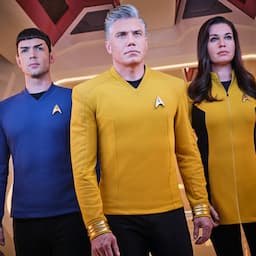
'Star Trek' Reveals Crossover With 'Lower Decks, 'Strange New Worlds'
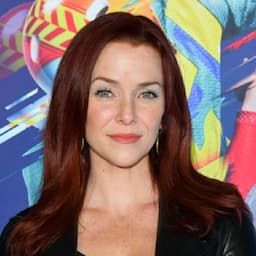
Annie Wersching, 'Star Trek' and '24' Actress, Dead at 45

How 'Deep Space Nine' Reimagined a Classic 'Star Trek' Episode
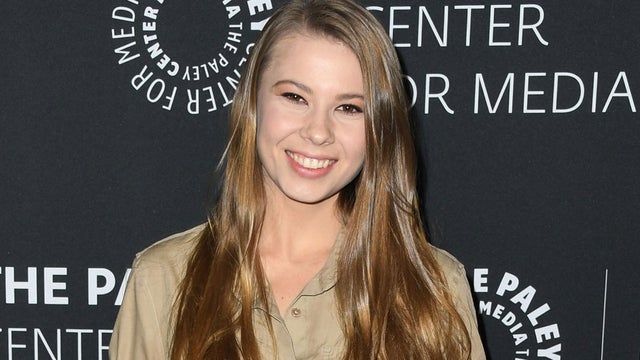
- Star Trek: Strange New Worlds
- ET Black Stories
Latest News
Updates on celebrity news, tv, fashion and more.
Memory Beta, non-canon Star Trek Wiki
A friendly reminder regarding spoilers ! At present the expanded Trek universe is in a period of major upheaval with the continuations of Discovery and Prodigy , the advent of new eras in gaming with the Star Trek Adventures RPG , Star Trek: Infinite and Star Trek Online , as well as other post-57th Anniversary publications such as the ongoing IDW Star Trek comic and spin-off Star Trek: Defiant . Therefore, please be courteous to other users who may not be aware of current developments by using the {{ spoiler }}, {{ spoilers }} OR {{ majorspoiler }} tags when adding new information from sources less than six months old (even if it is minor info). Also, please do not include details in the summary bar when editing pages and do not anticipate making additions relating to sources not yet in release. THANK YOU
Far Beyond the Stars
- View history
Far Beyond the Stars is an episode of Star Trek: Deep Space Nine . It was directed by series star Avery Brooks and written by Ira Steven Behr and Hans Beimler. It aired in February 1998, with a novelization adaptation released in June that same year. Benjamin Sisko experiences another life where he is Benny Russell , a talented science fiction writer of the 1950s, who comes up against the racism of American society.
- 1 Description
- 2.1.1 Episode characters
- 2.1.2 Novelization characters
- 2.2 Locations
- 2.3 Starships and vehicles
- 2.4 Races and cultures
- 2.5 States and organizations
- 2.6 Other references
- 3.1 Related media
- 3.2.1 Notable cast and crew
- 3.4.1 Timeline
- 3.5 External links
Description [ ]
References [ ], characters [ ], episode characters [ ], novelization characters [ ], locations [ ], starships and vehicles [ ], races and cultures [ ], states and organizations [ ], other references [ ], appendices [ ], related media [ ].
- Sources that continue Benny Russell's story after "Far Beyond the Stars" include " Shadows and Symbols ", Unity , the Star Trek: Typhon Pact novels Plagues of Night and Raise the Dawn and " The Dreamer and the Dream ". The character also briefly appears in Warpath . The comic When the Stars Come a-Calling and the Crucible novel Provenance of Shadows feature Russell before the events of "Far Beyond the Stars". The character is also mentioned in " Captain Proton: Defender of the Earth ", " Isolation Ward 4 " and " Captain Proton and the Orb of Bajor ".
Background [ ]
- Steven Barnes included an afterword in the novelization in which he looks at the role of African-Americans in science fiction and the changing attitudes to them. He commented on Deep Space Nine that it is " a major cultural turning point for America, and therefore, the world as a whole... DS9 is, as far as I'm concerned, the first successful dramatic television show in history with a non-Caucasian star ".
- Barnes had to write the novelization in a month, but "had a ball" doing so. He also commented that during the short time, he had " to create a full wraparound backstory, and do considerable research into New York in the 1950s and 1930s ". ( Voyages of Imagination )
- Barnes was given notes on several aspects of the episode by Michael Okuda . These notes included the design of the Incredible Tales office and the eclectic contents in it. [1]
- "Far Beyond the Stars" was the last standard-length Star Trek episode to receive a novelization . Earlier such novelizations included " Relics ", " Trials and Tribble-ations ", " Flashback " and " Day of Honor ". Later novelizations included the feature-length episode What You Leave Behind and two-part stories from Star Trek: Voyager and Star Trek: Enterprise .
Notable cast and crew [ ]
- Directed by Avery Brooks
- Avery Brooks as Benjamin Sisko and Benny Russell
- Nana Visitor as Kira Nerys and Kay Eaton
- Rene Auberjonois as Odo and Pabst
- Alexander Siddig as Julian Bashir and Julius Eaton
- Armin Shimerman as Quark and Rossoff
- Michael Dorn as Worf and Willie Hawkins
- Terry Farrell as Jadzia Dax and Darlene Kursky
- J.G. Hertzler as Roy Ritterhouse
- Aron Eisenberg as the vendor
- Marc Alaimo as Dukat and Burt Ryan
- Jeffrey Combs as Weyoun and Kevin Mulkahey
- Brock Peters as Joseph Sisko and the preacher
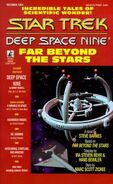
Connections [ ]
Timeline [ ], external links [ ].
- Far Beyond the Stars article at Memory Alpha , the wiki for canon Star Trek .
- Far Beyond the Stars article at Wikipedia , the free encyclopedia.
- 1 ISS Enterprise (NCC-1701)
- 3 Odyssey class
- Buy the Book…
- Reviews Hub

the m0vie blog

Following Us
- Adding Our RSS Feed to Your Gmail
- Following our Feed in Internet Explorer
- Millennium (Reviews)
- Star Trek: Deep Space Nine (Reviews)
- Star Trek: Enterprise (Reviews)
- Star Trek: The Next Generation (Reviews)
- Star Trek: The Original Series (Reviews)
- Star Trek: Voyager (Reviews)
- The X-Files (Reviews)
- X-Files Fandom Poll Form
Check out the Archives

Awards & Nominations

Star Trek: Deep Space Nine – Far Beyond the Stars (Review)
I am black, I have spent time in a mental hospital, and much of my adult life, for both sexual and social reasons, has been passed on society’s margins. My attraction to them as subject matter for fiction, however, is not so much the desire to write autobiography, but the far more parochial desire to set matters straight where, if only one takes the evidence of the written word, all would seem confusion. – Samuel Delany, The Straits of Messina
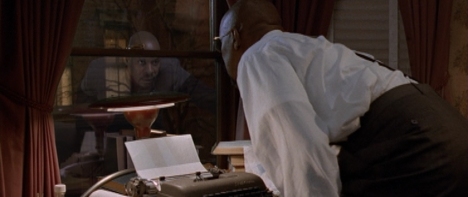
Keep dreaming.
Far Beyond the Stars is a masterpiece.
It is one of the best episodes of Star Trek ever produced, a neat encapsulation of the franchise’s core beliefs and humanist values filtered through a utopian lens. It is a story built upon the idea that things get better, that circumstances improve, that hope wins out. It is hard to imagine an episode of the franchise that more effective embodies this philosophy. Far Beyond the Stars is a love letter to the transformative potential of science-fiction, an ode to the capacity to imagine a world that is better than this one.
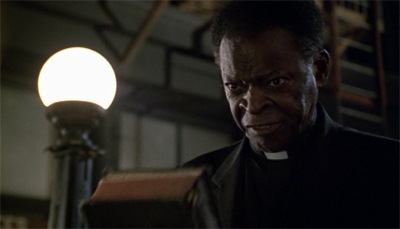
Star Trek sometimes gets a little preachy.
There is some irony that Star Trek: Deep Space Nine should be the series to deliver this particular story. After all, the writing staff on the show have long championed their position as the “bastard stepchild” of the franchise, taking every opportunity to subvert and undermine a lot of what fans take for granted about the fifty-year-old pop culture institution. Deep Space Nine is the version of Star Trek where currency still exists, where war still rages, where terrorism still occurs. So there is something surprising in seeing something as pure as Far Beyond the Stars .
Deep Space Nine is a series notable for cheekily toying with the assumptions that Star Trek fans have about the Star Trek universe. In Past Tense, Part I and Past Tense, Part II , the series reminded audiences that things would likely get worse before mankind could usher in the franchise’s utopia. In Homefront and Paradise Lost , the series implied that Starfleet was just as much a threat to Federation values as the looming Dominion invasion. Sisko crossed ethical lines that Kirk or Picard would consider sacrosanct in episodes like For the Uniform or In the Pale Moonlight .

Things PADDs.
However, Deep Space Nine has never been quite as cynical about the franchise’s core values as many would argue. As much as Ira Steven Behr hesitated to produce Trials and Tribble-ations as part of the franchise’s thirtieth anniversary celebrations, he eventually committed and the production team gave it their all. As much as Behr might have objected to the initial plans for the Defiant in Star Trek: First Contact , he still included a nice nod to the events in In Purgatory’s Shadow .
The writing staff on Deep Space Nine love the franchise, and its trappings. That is why they brought back old concepts like the three classic Klingons for Blood Oath or the mirror universe in Crossover . The sixth season is among the most provocative seasons of Star Trek in the franchise’s history, kicking off a two-year-long war arc that would seem to run counter to Gene Roddenberry’s wishes for the franchise. However, it remains very clear that the production team respect the franchise’s history and legacy.
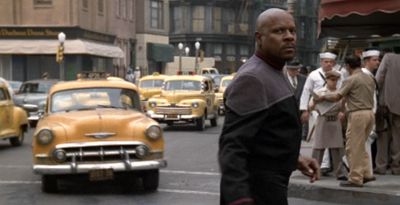
City on the Edge of Tomorrow.
Far Beyond the Stars is very much an archetypal Star Trek story. In fact, it is tempting to describe the episode as cross between The City on the Edge of Forever and The Inner Light , two episodes that can make a convincing argument for being the best episodes of their respective runs. As in The City on the Edge of Forever , the lead character finds himself thrown back to mid-twentieth-century New York, trying to reconnect with the Star Trek future. As with The Inner Light , the lead character lives an an extended adventure in only “a few minutes.”
Far Beyond the Stars unfolds against the backdrop of the fifties, which is an important era in the history of the Star Trek franchise. The original Star Trek launched in September 1966, perhaps the last gasp of the Kennedy’s Camelot. In the midst of the Cold War, Star Trek dared to imagine a future where mankind had not only survived, but thrived. However, Star Trek was just as much a product of the forties as the sixties, its perspective shaped and formed by the experience of its writers during the Second World War and by the new world order left standing in the aftermath.
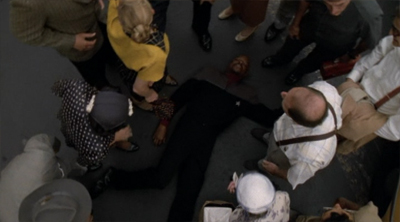
Sweet dreams.
There are certainly shades of this in Far Beyond the Stars . Like Gene Roddenberry or Gene L. Coon, it is implied that Benny Russell is a veteran of the Second World War. When Benny protests that he has “only been working at it for a few years” , Cassie corrects him, “A few years? More like fifteen, if you count all those stories you wrote in the Navy.” Benny shrugs off that writing as “amateur stuff” , but it seems clear that his vision of the future is heavily informed by those experiences.
Star Trek has acknowledged that its cultural foundations lie in the Second World War, both politically and culturally. Near the end of the show’s first season, The City on the Edge of Forever made the connection literal. Sending Kirk back to New York in the late thirties, the episode revealed that the American involvement in the Second World War was perhaps the most important event in the foundation of the Federation. This sentiment would be repeated almost forty years later with Storm Front, Part I and Storm Front, Part II at the start of the final season of the Berman era.
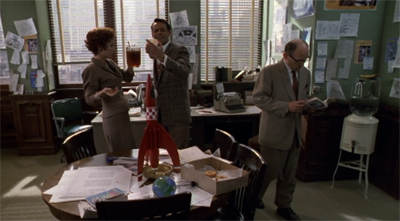
Writers’ room.
However, there is also a cultural gap that exists between the Second World War and the Kennedy administration, a period of history that inevitably led to the development and broadcast of Star Trek that stands between those two key moments in popular culture. Far Beyond the Stars plays almost as an exploration of that hidden history, of the shifts in science-fiction culture that took place between the end of the Second World War and the broadcast of The Man Trap .
Far Beyond the Stars is a celebration and exploration of the science-fiction magazine culture of the fifties that paved the way for the expansion of science-fiction into other media in the years that followed. It is story set primarily in the writers’ room of a pulpy sci-fi magazine, where the authors toil over typewriters to churn out fiction with catchy titles like “Honeymoon on Andoras” or “Please, Take Me With You.” Magazines like Incredible Tales and Galaxy recall real-world pulp like Amazing Stories or Astounding .
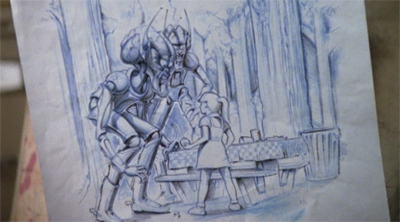
It’s no picnic…
These periodicals had a tremendous influence on the evolution of on-screen science-fiction. It seems reasonable to argue that films like Forbidden Planet would not exist without these stories, as Richard Scheib contends :
It comes with a plot that could have been taken out of any copy of Amazing Stories or Astounding in the previous decade. It is clear that the authors have read the pulp magazines of the 1940s. There is a love of science-fictional gadgetry and wondrous technology – brain-boosting devices, moving sculptures, forcefields, rayguns, the planetary energy wells and of course Robby the Robot whom one expects could quote Asimov’s Three Laws of Robotics at the drop of a mechanical hat.
Naturally, Forbidden Planet would go on to be a major influence on Star Trek , making these magazines part of the franchise’s cultural genealogy.
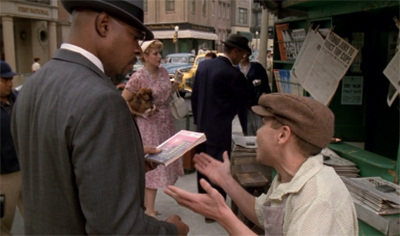
Sisko must have had quite the bump on the Nog-gin.
More than that, these magazines were home to key influences on Roddenberry. Richard Mathieson published his first short story Born of Man and Woman in The Magazine of Fantasy & Science Fiction , embarking on a career that would include a teleplay credit on The Enemy Within . Jerome Bixby was a fixture of these magazines, editing Planet Stories and publishing prose in magazines like Worlds of Tomorrow , before contributing scripts and story ideas for episodes like Mirror, Mirror and Day of the Dove .
When Benny arrives with “the new issue of Galaxy” , Herbert Rossoff rhymes a list of the authors credited on the latest edition. “Heinlein, Bradbury, Sturgeon.” Sturgeon wrote Shore Leave and Amok Time . Ray Bradbury was invited to write for Star Trek , but declined; he would be cited as an influence on J. Michael Straczynski and Bryce Zabel’s proposed reboot of the franchise . Similarly, Roddenberry invited Heinlein to write for the show, but Heinlein turned Roddenberry down; writer Manu Saadia has described Star Trek as “above all a critique of Robert Heinlein.”

The stories are out of this world…
Even the characters in Far Beyond the Stars are intended to evoke these forties and fifties magazine writers. With his interest in robotics and his distinctive pipe, Albert is clearly meant to evoke Isaac Asimov. Asimov had a very long and involved history with the franchise, enjoying an affectionate and constructive relationship with Gene Roddenberry . Hiding behind her initials to disguise her gender, Kay Eaton evokes both Star Trek writer D.C. Fontana and also magazine writers like C.L. Moore.
Even the production design of the episode is absolutely saturated with in-jokes and references that seem to position Benny Russell’s work as part of a broader cultural movement pushing towards Star Trek . Pabst’s reference to “Andoris” evokes “Andoria.” The cover to Galaxy teases the story Court Martial along with an illustration that evokes the matte backgrounds from the original Star Trek . In March 1953, Incredible Tales published The Cage , The Corbomite Manoeuvre , Journey to Babel , Metamorphosis , and Where No Man Has Gone Before .
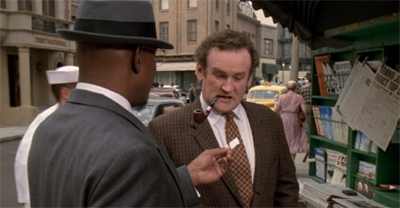
One of the nicer subtler touches of Far Beyond the Stars is how eager the cast and crew are to use the setting as an excuse to include lots and lots of smoking.
All of this suggests that Benny Russell is working at time when all the influences that will inspire Star Trek are coming into play, but they have not yet coalesced into a vision for the future. Far Beyond the Stars suggests that Star Trek had to be willed into being, that it had to come from some unconscious hunger for a better future than that suggested by the staid mood of the nineteen fifties. Far Beyond the Stars insists that Star Trek is the dream of a better future, an invocation of a world more hopeful and more idealistic than the immediate future plans to be.
Indeed, during his breakdown, Benny repeatedly insists that Deep Space Nine is real simply because he can dare to imagine it. “You can pulp a story but you cannot destroy an idea,” Benny warns Pabst. “Don’t you understand? That’s ancient knowledge. You cannot destroy an idea. That future, I created it, and it’s real.” As far as the episode is concerned, the most potent and powerful conception of Star Trek lies the way that the very idea of this utopian future speaking to “someone without a lot of hope” or “someone dreaming of a better future.”
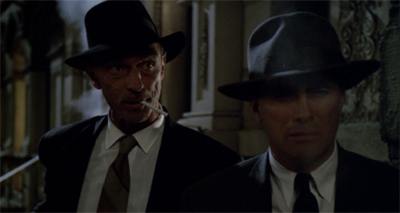
See what I mean?
It is a very romantic approach to Star Trek , suggesting that the very idea of a utopian future can be subversive gesture of resistance or empowerment. Interestingly enough, this is a theme to which Star Trek: Enterprise returns in its own final season. As the Star Trek franchise was facing cancellation for the first time in almost two decades, and as the War on Terror raged, episodes like Babel One , United , The Aenar , In a Mirror, Darkly, Part I and In a Mirror, Darkly, Part II insisted that the idea of the Federation was subversive in its own way.
There is something beautiful in the suggestion that ideas can change the world, that daring to imagine a better world has the power to change this one. In some ways, this is a very ideologically pure defence of the Star Trek franchise, one that skips past all the moments when Star Trek has fallen well short of that idealism by indulging in reactionary rhetoric or pandering to racism or sexism. Far Beyond the Stars is a stirring defence of Star Trek from first principle, contending that its shortcomings cannot undermine the hope embodied by its core premise.
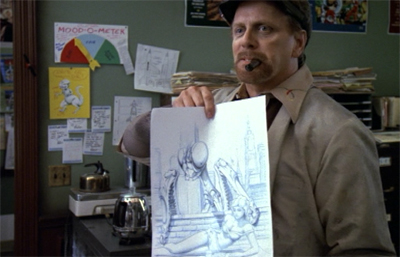
Here’s another one.
In many ways, this optimism evokes the way that writer Grant Morrison talks about the power of Superman as a very concept. Morrison has described Superman as “our greatest-ever idea as the human species” , and talked about how as a child he represented the very idea of hope in the face of annihilation :
My parents were anti-nuclear activists, so the bomb was a big frightening specter in our household. Then I discovered superhero comics and realized that here was an idea that was bigger than the bomb. Superman can withstand an atom bomb explosion. They literally saved me from the horror of the atom bomb.
There is something very pure in that idea, in the suggestion that the very act of imaging something bigger and stronger and better than the atomic bomb represented some sort of victory. Far Beyond the Stars suggests that Benny Russell finds some strength in daring to imagine a future better than that presented to him.
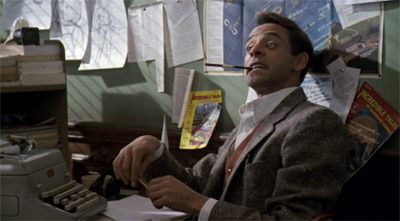
Points for variety.
Far Beyond the Stars consciously frames this utopian idealism in the context of fifties America. In particularly, the story finds Benjamin Sisko reimagined as Benny Russell, an African-American science-fiction writer working in a culture that is openly hostile to him. Benny lives in a world where successful African-American athletes cannot even live in the same neighbourhood as their white team mates, where young black men can be gunned by the police for breaking into a car, where he can be stopped and demeaned by the authorities for no reason.
Far Beyond the Stars is an episode that is consciously built around the fact that Sisko is a black man in a position of authority that would have been unimaginable to audiences less than half-a-century earlier. It is a surprisingly candid piece of social commentary, given that Star Trek has tended to dress up it commentary in metaphor and allegory. The franchise could deal with homosexuality in the abstract through episodes like The Outcast and Rejoined , but it could not produce scripts like Blood and Fire or show two members of the same gender kissing in The Offspring .
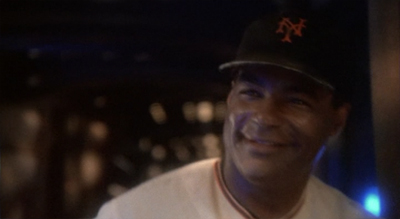
However, Avery Brooks worked very hard to ensure that Sisko retained a distinct sense of his cultural heritage. Sisko was not written or presented in a way that was “colourblind.” Sisko was explicitly African-American, even in the twenty-fourth century. This was important to Brooks, and it inspired him to take the role :
“Certainly the fact you have a black man in a command position is very important. That is something that goes far beyond just having black people working on a show, which itself is also very important. It goes to children being able to see themselves on screen and visualize that in the future they will be doing something of importance to the world at large. It addresses the situation of having all kinds of people interacting and cooperating for the mutual survival of the planet. The writing was exceptional, and the funny thing is I initially said no to Star Trek. My wife convinced me to go to the audition. She was the one who said, ‘You can’t say no to this.’”
Sisko’s quarters are decorated with African artwork, with the writers even drawing attention to its arrival in The Search, Part I . Sisko has a long-standing interest in culinary art of his home in New Orleans, and even his casual costuming reflects a distinctly African-American heritage as compared to the casual attire of Kirk or Picard.
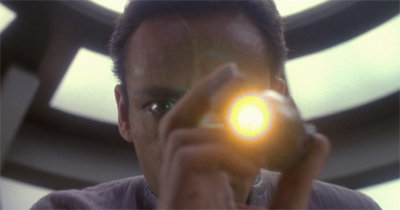
Light relief.
Deep Space Nine exists in a future where racism no longer exists, where Sisko no longer faces the sort of institutional prejudices that apply to minorities in contemporary societies. On Star Trek: The Next Generation , there was a tendency to assume that this utopia was built upon the establishment of a singular human mono-culture; that a French character like Jean-Luc Picard could speak with a British accent like Patrick Stewart, and where everybody shared the exact same values and perspective.
One of the strongest aspects of Deep Space Nine has been the emerging realisation that it is possible for cultures to peacefully coexist while retaining their own identities. Worf can partake in Klingon customs, within reason. major Kira can worship her gods in her own way. That cultural diversity trickles down to the human characters as well. Benjamin Sisko is human, just like James T. Kirk or Jean-Luc Picard or Kathryn Janeway, but that does not mean that they all share the exact same culture.
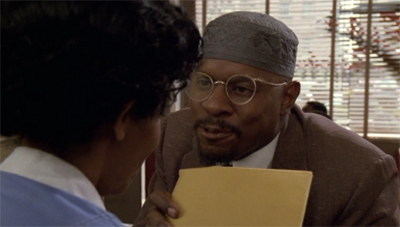
Everybody’s got a story.
Indeed, this was part of the reason why the producers asked Avery Brooks to direct Far Beyond the Stars . As Steve Oster acknowledges in the Star Trek: Deep Space Nine Companion , Brooks brings some authenticity:
“We discussed the possibility of Avery directing, knowing that he was going to be in every frame of film,” Steve Oster acknowledges. “We don’t like that combination, because it’s very hard to direct yourself. However, this was a story about racism and prejudice and we felt very strongly that it would be wrong if it came from a bunch of people who didn’t necessarily know about that experience. We knew that it was imperative to the story and imperative to the integrity of television for it to be done right.”
After all, Far Beyond the Stars was an episode about the African-American experience in fifties America, but it had been written by a bunch of white writers. Brooks was a creative individual who would put his own stamp on it.
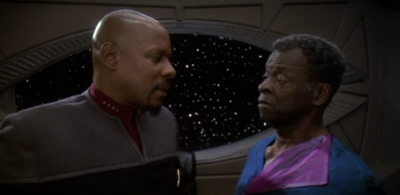
Father beyond the stars…
Indeed, Brooks worked very hard over the course of Deep Space Nine to shape and mould the character Sisko in collaboration with the writers. Ira Steven Behr has talked about arguing with studio executives on Brooks’ behalf to let him “shave his head and keep the goat” , a choice that was obviously of importance to the actor. Brooks was particularly invested in the relationship between Ben and Jake Sisko , even insisting that the producers alter What You Leave Behind so that Sisko would not be seen to entirely abandon his son.
And so it was important to Avery Brooks that Deep Space Nine recognise Sisko’s blackness, to acknowledge his cultural heritage and not to treat him as a generic television protagonist that happened to be played by an African-American actor. The result is a truly compelling and fascinating character. Sisko is never defined by his ethnicity, but his culture is very much a part of his identity and heritage. Deep Space Nine was arguably the first truly multicultural Star Trek series, and that was reflected in Sisko himself.
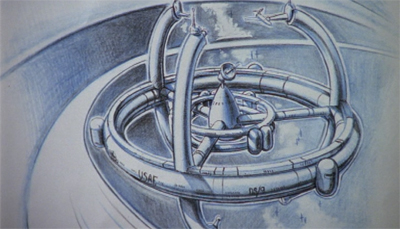
Spaced out.
Deep Space Nine has acknowledged Sisko repeatedly as an African-American, but never as explicitly as with Far Beyond the Stars . Cast into the role of Benny Russell, Sisko and the audience are confronted with reality of a prejudice and hatred based solely on a person’s skin colour. As Mark Anthony Neal argues in Looking for Leroy , Benny Russell is part of the cultural context of the genre’s mid-twentieth century history:
In terms of black science fiction writers, Benny Russell anticipates the careers of Samuel Delany, Nalo Hopkinson, and the late Octavia Butler, and brings into greater focus some of the experimental fiction of early-twentieth-century writers such as W.E.B. Du Bois, whose short story The Comet was published in 1920, and George Schuyler, whose 1930 novel Black No More centres on a scientist who is capable of turning black people white.
Russell even explicitly cites some of his contemporaries in an argument with Pabst. “What about W.E.B. du Bois, Zora Neale Hurston, Langston Hughes, Ralph Ellison, Richard Wright?” Benny demands of his editor, who claims that the public is not yet ready for “stories written by Negroes.” Benny challenges him, “Did you ever heard of Native Son?”
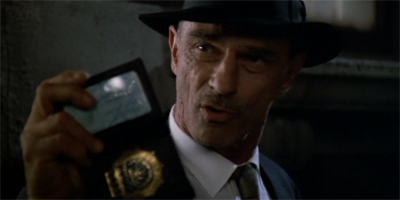
Unfair cop.
Benny is a professional. He works in a white-collar job, writing fiction that is distributed to a mass audience. He dresses neatly. He is polite and respectful. However, he is still demeaned and humiliated. Locking up after work one night, he is stopped by two racist cops. “Nice suit,” notes Mulkahey. However, the compliment comes with an accusation, “Where’d you get it?” It is a particularly nice touch that Far Beyond the Stars names its racist cops Ryan and Mulkahey, decidedly Irish names. The Irish had once been subject to such racism, but now they dish it out.
When Benny dares to imagine a future where a black man could be the commanding officer on a space station, other African-American characters scoff at his optimism. “A coloured captain?” chuckles Jimmy in disbelief. “The only reason they’ll ever let us in space is if they need someone to shine their shoes.” The black characters in Far Beyond the Stars repeatedly find themselves subject to prejudice and racism, in various forms. Sometimes, that racism is overt, as with the police officers. Sometimes, it is more subtle, as demonstrated by editor Douglas Pabst.
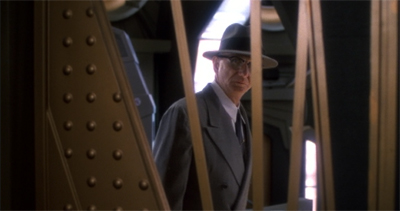
Force to pulp the pulp.
Pabst positions himself as a neutral party in this contemporary culture. He insists that he is not racist, but that he is beholden to public that is not ready for such progressive science-fiction. When Benny lists off the successful African-American writers who are allowed to embrace their blackness, Pabst dismisses his writer’s concerns out of hand. “That’s literature for liberals and intellectuals,” he reflects. “The average reader’s not going to spend his hard earned cash on stories written by Negroes.”
He pleads with Benny, “Look, Benny, I’m a magazine editor, I am not a crusader. I am not here to change the world, I’m here to put out a magazine. Now, that’s my job. That means I have to answer to the publisher, the national distributors, the wholesalers and none of them are going to want to put this story on the newsstand. For all we know, it could cause a race riot.” Pabst tries to present himself as a reasonable person with legitimate concerns, who is only operating within a larger framework. He is, as Herbert Rossoff calls him out, “a coward.”
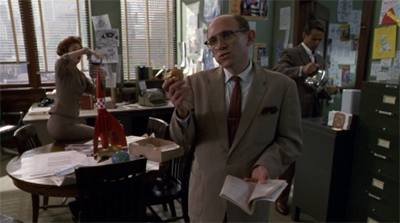
Chewing it over.
Pabst is also the face of a more subtle form of racism than the law enforcement officers who casually drop the word “boy” into conversation. He is a figure that many African American writers will recognise. Science-fiction writer Samuel Delany recognised a similar figure from his work in the sixties, as he outlined in Racism and Science Fiction :
I submitted Nova for serialisation to the famous sf editor of Analog Magazine, John W. Campbell, Jr. Campbell rejected it, with a note and a phone call to my agent explaining that he didn’t feel his readership would be able to relate to a black main character. That was one of my first direct encounters, as a professional writer, with the slippery and always commercialised form of liberal American prejudice: Campbell had nothing against me being black, you understand. (There reputedly exists a letter from him to horror writer Dean Koontz, from only a year or two later, in which Campbell argues in all seriousness that a technologically advanced black civilisation is a social and a biological impossibility. … ) No, perish the thought! Surely there was not a prejudiced bone in his body! It’s just that I had, by pure happenstance, chosen to write about someone whose mother was from Senegal (and whose father was from Norway), and it was the poor benighted readers, out there in America’s heartland, who, in 1967, would be too upset.
There is perhaps an element of self-criticism to the characterisation of Pabst. Pabst recalls those stories about David Livingston rushing down to the set to prevent two same-sex extras holding hands in The Offspring or Ronald D. Moore’s pointed observation that the only thing stopping gay characters from appearing was Rick Berman .
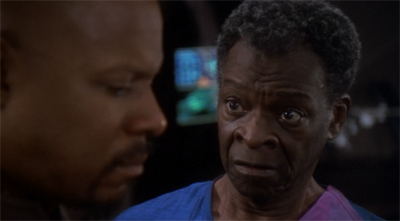
It is tempting to believe that the politics of Far Behind the Stars are relatively outdated, that the experiences of Benny Russell can be consigned to the history books as an expression of closemindedness that would no longer occur. By the time that Far Beyond the Stars aired in February 1998, during Black History Month, most Americans would have hoped that the country had moved far past the bigotry and hatred that slowly chips away at Benny Russell over the course of the narrative. Things have to have gotten better, surely?
In some ways, they have. It is hard to imagine a publisher pulping an entire magazine run because the lead character is revealed to be black. Indeed, those barriers were arguably in the process of being broken down at around the same time that the story is set. The famous (and controversial) comic Judgment Day was published in April 1953 , featuring a black astronaut standing in judgment of an alien society as an explicit commentary on racial prejudice. The Civil Rights movement would emerge in the later part of the decade.
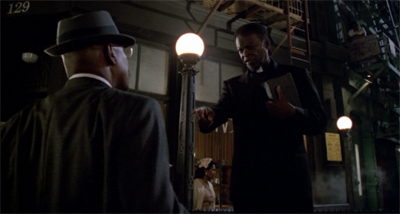
Preach out and touch faith.
Quoted in The Fifty-Year Mission , writer Ira Steven Behr acknowledges that the morality of Far Behind the Stars might seem a little awkward and heavy-handed, coming more than forty years after the bulk of the story is set:
To an extent it’s like shooting ducks in a barrel, because who the hell is going to say that racism is good at this stage of the game? So you’re kind of preaching – you would imagine – to the converted already, but I thought it was an interesting way to do it.
Behr might have something of a point in this regard, given the overt nature of the episode’s moral and the fairly unequivocal prejudice that Benny finds himself facing.
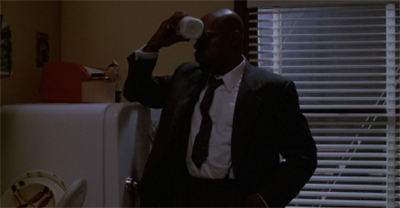
Cooler heads.
However, Far Beyond the Stars works as a cultural allegory about prejudice. More than that, it works on multiple levels. Most superficially, it works as an affectionate period piece mapping out a cultural history of Star Trek as something that emerged from the political consciousness of the fifties and sixties. Star Trek was in many ways an expression of the liberalism and idealism that arose from the younger generation in response to the staid conservatism of the fifties.
More than that, Star Trek was in part driven by the response to this sort of historical prejudice and long-standing injustice. Star Trek certainly had its flaws and its blind spots in this regard. It struggled with how best to embrace youth culture in episodes like This Side of Paradise or The Way to Eden ; it repeatedly did an injustice to Uhura in scripts like The Changeling or Plato’s Stepchildren ; its sexual politics were decidedly muddled in episodes like Dagger of the Mind or A Private Little War . However, the series was very earnest in its desire for a better world.
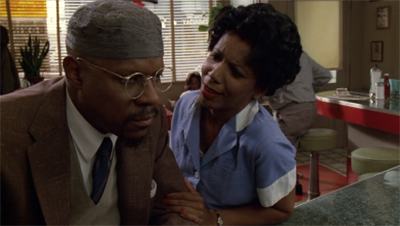
A Cass act.
This was particularly apparent in the third season, with preachy idealistic episodes like Let That Be Your Last Battlefield and The Day of the Dove . In Yesterday’s Enterprise , Jan Johnson-Smith argues that this is a valid context for Far Beyond the Stars :
The episode confronts America’s history of bigotry and the dreams of its population for equality by contrasting it with the equality of the ‘real’ Deep Space Nine diegesis and characters with which we are familiar. The significance of Russell/Sisko being ‘the dreamer and the dream’, and the parallels with the famous ‘I have a Dream’ speech of martin Luther King in January 1963 are hard to miss. The episode also confronts its own series’ history, the dream of equality and the dream of the future; as Michèle and Duncan Barrett say, ‘the dream is the dream of science fiction: it is an analogy for Star Trek itself.’ The concern is whether the dream is aspirational or delusional.
In its exploration of the political and cultural climate of the fifties, contrasting it with the idealism of the Star Trek universe, Far Beyond the Stars provides a powerful and compelling historical context for the franchise. This is a perfectly reasonable argument.

His dreams shot to hell.
However, there is more to it. The United States might have moved past the more overt racism on display in Far Beyond the Stars , but the truth is that far too much of the episode still resonates. Drawn to gunshots, Benny finds himself standing over the body of Jimmy. The young black man was killed by two trigger-happy cops. “He had a weapon,” Mulkahey insists. “A crowbar?” Benny protests. It recalls the high-profile murders of young black men by law enforcement in recent history, many of whom were unarmed .
Contemporary society might have moved past the stage where a black (or female) science-fiction writer is news, but not everybody has been accepted. Star Trek waited fifty years for an explicitly gay regular character, with Hikaru Sulu in Star Trek Beyond and Lieutenant Stamets in Star Trek: Discovery . Marvel Comics has argued that their audience simply does not want prominent female or minority characters . GamerGate exists as a backlash against feminist critics of popular culture, chasing them out of a predominantly male space .
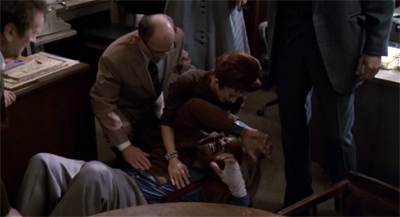
He won’t take this lying down.
There are probably a lot of contemporary writers and journalists who will empathise with the plight of Benny Russell, having been shouted down by angry mobs and hounded by those opposed by perspectives beyond their own. Female gamers are frequently subjected to rape and death threats for presuming to intrude into the medium . Recent months have seen Jewish journalists targeted with anti-Semitic rhetoric and imagery for daring to comment on contemporary politics .
Sadly, progress is not always assured. The horrors of fifties racism cannot be brushed aside and forgotten, even if the particulars have changed. “Every time I achieve a real victory, something like this happens and everything seems to turn to ashes,” Sisko reflects early in the episode, and it is hard not to empathise. The election of Barrack Obama as the first African-American President of the United States was supposed to signal a new post-racial moment for the United States . Instead, paranoid response to his presidency sparked the creation of white identity politics .
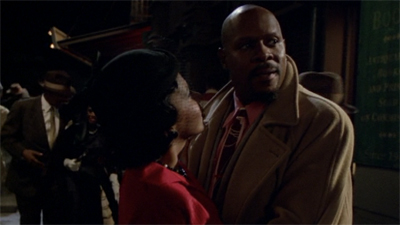
Russelling up some social change.
Much less seriously, there is still a culture of consciously downplaying the race and gender of the writers of genre fiction. A striking example from recent history is the pen name of “J.K.” for author Joanne Rowling. Rowling is author of the best-selling Harry Potter series, but her publisher suggested she initially disguise her gender :
Bloomsbury, the publishers of the Harry Potter series, said the author took her grandmother’s name. A spokesman said: “Clearly it was not her name given at birth but it could have been her confirmation name. When we asked her for her initials, she said J K.” She added that the publishers decided to use initials instead of a name to attract boy readers. “As it happened the first book was such a success that within two months of publication she was on Blue Peter, so it was blown. There are many examples of authors changing their names.”
There is something very disheartening in this. Rowling is undoubtedly one of the most successful authors of the twentieth and twenty-first centuries. However, it was still deemed advisable that she conceal her gender in order to avoid alienating her potential audience.
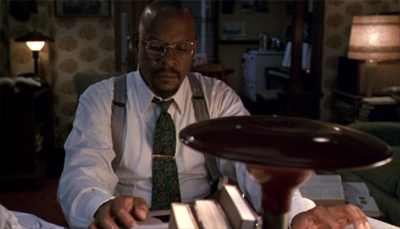
Against type.
Even in the context of the nineties, far removed from the overt racism of the fifties, it should be stressed that Benjamin Sisko was very much an aspirational figure. African-Americans were under-represented as television leads at the time. Writer Steven Barnes argued that white viewers had to be prepared for Brooks as a Star Trek lead, that the character was cautiously introduced in a way so as not to threaten white audiences :
I have enjoyed DS9, and felt that they soft-pedaled Sisko for the first few seasons, bringing him slowly to a more and more macho characterization. They knew the audience had to be carefully primed to accept such a thing. Avery Brooks is marvelous. Virile, intelligent, humorous-what a waste that A Man Called Hawk show was! He was EASILY the best thing about Spenser for Hire (which I enjoyed), and if they ever make a Spenser movie, only Brooks or Larry Fishburne could play Hawk convincingly. He is simply wonderful. Now that Deep Space Nine has been airing for almost 6 years, what are your thoughts on the show and the character development of Captain Benjamin Sisko? His early characterization was quite soft-spoken. I think this was no accident-they were trying to create the first African-American lead in an hour-long dramatic series. Quite a balancing act. Very slowly, they’ve let his strength-his true character-emerge.
Barnes has something of a point here. There is something disheartening about the fact that the studio took so long to fully trust Brooks to make the role his own. More than that, it is frustrating that this was still an issue in the early nineties. Far Beyond the Stars suggests that Captain Benjamin Sisko was too much for fifties readers, but there is some suggestion that nineties audiences still needed to be acclimatised and prepared.
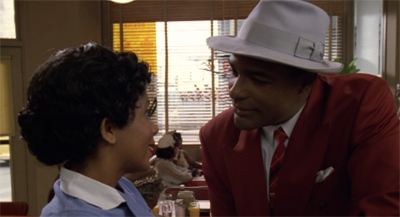
Playing ball.
To be clear, this is an issue with nineties popular culture in general and not with Deep Space Nine in particular. Shows like The X-Files and Buffy: The Vampire Slayer had predominantly white casts. Deep Space Nine has enough black cast members that it can tell a story like Far Beyond the Stars using regular and recurring players. Benny is able to interact with figures from the black community like Cassie or Jimmy or Willie or even the Preacher. It would be hard to name five regular and recurring African American actors on any other Star Trek show.
Despite the studio’s attempts to temper him earlier in the run, Brooks is absolutely phenomenal when he is given the freedom to cut loose. Brooks has a performance style that is all his own, a beautiful hybrid of the heightened staccato rhythm of William Shatner and the raw Shakespearean power of Patrick Stewart. When really cutting loose, Brooks feels very much of a piece with the heightened universe around him, a larger-than-life figure in a fantastical world. Sisko is one of the most compelling and engaging major characters in the franchise, in part thanks to Brooks.
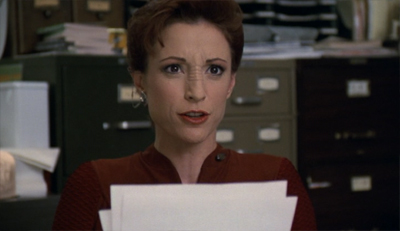
One tough cookie.
Far Beyond the Stars is very much a showcase for Brooks’ performance as Benny. Brooks brings the character to life, perfectly following Benny his numb acceptance of the status quo towards his epiphany and his embrace of the idea of Benjamin Sisko. According to Nana Visitor, his performance of the breakdown scene was something to behold :
There are only two things that come to mind. One was that I fashioned my look on a self-portrait my mother had done of herself when she was my age at that time period — and I looked eerily identical. In one of the shots I took the pose she was in — hand to chin — and it was a little secret homage to my mother. The other thing was how on-the-edge Avery’s performance was. When his character collapses, I remember being alarmed and unsure that the actor was OK. I’d never gotten scared like that for another actor’s welfare in all my experience. It was chilling to watch.
Brooks does phenomenal work in the role. In some respects, Far Beyond the Stars is his defining performance. The sheer anguish of his breakdown at the episode’s climax is perhaps Sisko’s most mimetic moment. Along with Vreenak’s “it’s a faaaake!” from In the Pale Moonlight , it is a truly iconic moment for Deep Space Nine .
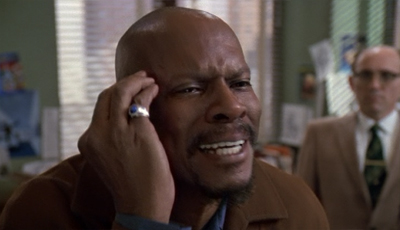
Oh, Vreenak would just love this dude.
Even beyond the power of the central metaphor and Brooks’ central performance, Far Beyond the Stars is a spectacular piece of television that has been put together with a great deal of care. The fifties setting of Far Beyond the Stars might have been intended to support a single episode, but the writers and the production design team put a lot of effort into fleshing out the world. The Paramount back lot looks beautiful, filled with vintage cars and loving recreating the period décor.
It speaks to how well Far Beyond the Stars is constructed that all of the characters in this vision mirror their Star Trek counterparts in some way or another, with even this dreamscape serving to illuminate some of the core character beats on Deep Space Nine . There is some fundamental truth in how Far Beyond the Stars portrays these characters, making it seem like more than just a clever throwaway. For example, Pabst is very clearly designed to mirror the character of Odo. Pabst may not literally be Odo, but he reflects some of Odo’s core aspects back.
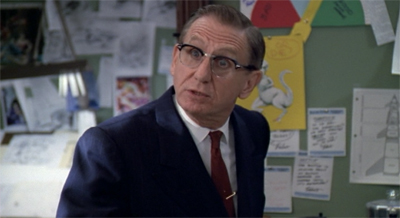
Blast from the Pabst.
Like Odo, Pabst is primarily motivated by a pursuit of order rather than justice. Like Odo, Pabst is willing to tolerate a perpetual state of injustice so long as the appearance of order is maintained. Pabst and Rossoff fight over the donuts, a regular occurrence fought to “a draw, same as always.” Like Odo and Quark, Pabst and Rossoff represent the opposite ends of the ideological spectrum. Pabst represents the establishment, but without any real underlying moral core. Rossoff is very much the quirky outsider, but with a surprisingly strong moral character.
Rossoff labels Pabst a “fascist” , and he might not be wrong. Pabst’s collaboration with the powers that be perhaps mirrors Odo’s compromise with the Cardassians during the Occupation, as explored in Necessary Evil and Things Past . Odo has always been the most morally flexible character in the Deep Space Nine ensemble, and that is reflected in Pabst. In many ways, Pabst betrays his writers like Odo betrays his friends in Children of Time or Behind the Lines . Pabst is a certainly very interesting read on Odo.
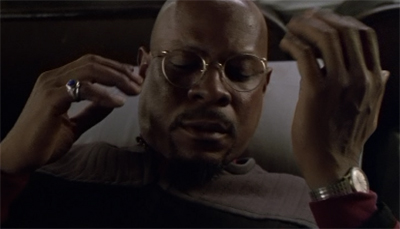
Dressed to impress.
There are parallels with other characters, of course. Rossoff is very clearly a twisted reflection of Quark. He takes offence to Pabst calling him “a pinko” , but the truth is that Pabst might have a stronger conscience than the rest of the writing room. This is the central irony of Quark. Deep Space Nine has repeatedly suggested that Quark is not nearly selfish and greedy enough to be a Ferengi, with episodes like Business as Usual and The Siege of AR-558 suggesting that Quark has a much stronger moral centre than most of the other characters would acknowledge.
Reflecting Bashir, Julius is a bit of a snob. “White Rose Redi Tea,” he muses after his wife makes some instant tea. “What an appalling concept.” When K.C. insists that “H.G. Wells would’ve liked it” , Julius rejects the idea out of hand. “I doubt that. No self respecting Englishman would.” Like Martok, Roy is gregarious and larger-than-life. When the writers object to the buxom beauty in his sketch for “Honeymoon on Andoris” , he shrugs, “So I had too much sauerkraut on my franks that night. What can I say?”
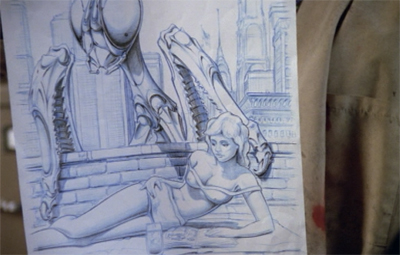
Insect appeal.
Beyond Pabst and Rossoff, perhaps the most insightful character commentary comes in the form of Albert Macklin, who is mirrored with O’Brien. In the world of Deep Space Nine , the decency of Miles Edward O’Brien is treated as a universal constant. It is that basic decency that bleeds over to the mirror universe in episodes like Through the Looking Glass and Shattered Mirror , and which makes the obligatory “O’Brien must suffer” episodes so compelling. It is no surprise that Albert Macklin seems like the nicest guy on the writing staff.
More than that, Far Beyond the Stars suggests that Macklin shares O’Brien’s interest in technology. “Albert’s got the right idea,” Pabst advises Benny. “He’s not interested in negroes or whites. He writes about robots.” In fact, Macklin even seems to share his counterpart’s desire to fix things. While the entire staff argues over Pabst’s refusal to publish the “Deep Space Nine” stories, it is Macklin who ultimately proposes a solution. “I’ve got an idea,” he suggests. “Why not make them, you know, a dream?”
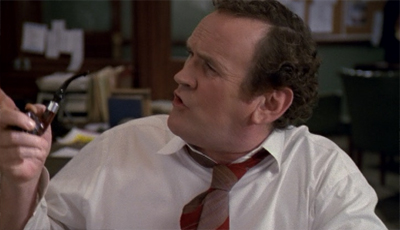
Put that in your pipe and smoke it.
This is quite clever of itself, but Far Beyond the Stars goes a little further. It suggests that Macklin is primarily interested in robots and machines because he has difficulty interacting with people. He is incredibly socially awkward, from his introduction to Benny at the start of the episode. “I thought you might be going… eh… to the… office…?” he asks Benny. He stutters repeatedly. When Rossoff takes a cheap shot at Macklin for writing about robots, he responds, “I like robots. They’re very efficient.” The implication is that humans are… not.
This is interesting in the context of O’Brien, if only because it seems to hint at a nice little character detail. Episodes like Empok Nor have repeatedly insisted that O’Brien became an engineer because he did not want to be a soldier any longer. The implication would seem to be that O’Brien liked fixing things instead of destroying them. However, through the character of Macklin, Far Beyond the Stars asks the audience to consider whether O’Brien is more interested in mechanics because they are fundamentally simpler than people. They lack the complications.
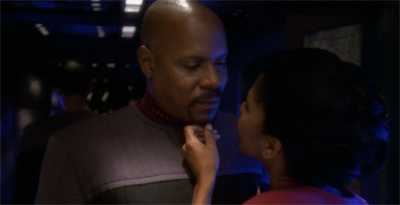
Star-crossed lovers.
However, the character seem to exist in a space between the Star Trek universe and the real world. The characters not only mirror their Deep Space Nine counterparts, but also the actors. As The Star Trek: Deep Space Nine Companion demonstrates, the sets were populated with lots of little in-jokes and references:
Visible everywhere are pinned-up memos from Mr. Pabst. One memo to Albert Macklin advises him that “four laws of robotics is too many”, and suggests that he lose one. The memo brings to light the similarity between Albert and famed science fiction writer Isaac Asimov, who wrote a series of novels in which robots operated according to three “Laws of Robotis.” Asimov’s groundbreaking novel, I, Robot was published by Gnome Press, as was Macklin’s first novel. Another Pabst memo, this one to Herb Rossoff, advises that “no one would believe that a cheerleader could kill vampires.” This inside joke works on two levels, given that Rossoff’s counterpart, Armin Shimerman, appeared for several seasons on the series Buffy, the Vampire Slayer.
Armin Shimerman cites this little in-joke as “the only time the production or anyone (except the actors) ever acknowledged my other existence on Buffy.” It is a very clever reference to Shimerman’s career beyond Deep Space Nine .
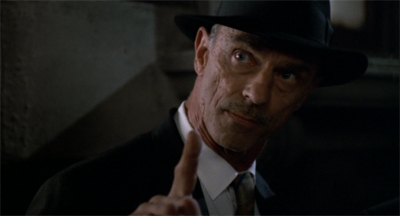
Another nice touch: of course twentieth century Gul Dukat has a scuzzy mustache.
Indeed, Rossoff’s advocacy for Benny could be seen as a nod to Shimerman’s off-screen advocacy. Shimerman is one of the most socially-conscious members of the Deep Space Nine cast, having served for six years as a member of the National Board of the Screen Actors’ Guild and serving as the organiser (and representative of) the Trek Against Trump campaign in late 2016 . It makes perfect sense that Shimerman would be cast as the member of the Incredible Tales writing staff most sensitive to Benny’s plight.
Less seriously, there is something very clever in casting Nana Visitor and Alexander Siddig as a married couple. The two actors got married during the fourth season of Deep Space Nine , and had started a family together. Although the marriage did not last, the Deep Space Nine writing staff would work in a number of sly references to the relationship over the final four seasons of the show. In Fascination , the two characters almost hook up. In Apocalypse Rising , Kira blames Bashir for her pregnancy. Far Beyond the Stars takes the in-joke to its logical conclusion.
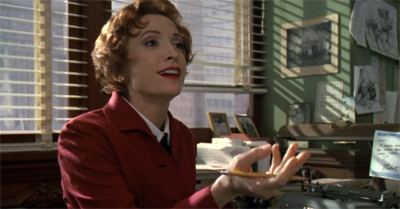
Far Beyond the Stars is a remarkable piece of television, and it made an incredible impact on both the writers and the fans. Indeed, the concept of Benny Russell was so striking and effective that the production team even returned to it for a few scenes in Shadows and Symbols , drafting in Casey Biggs to play a fifties equivalent of Damar. The fifties setting has even been used in tie-in fiction, making an appearance in the Millennium trilogy along with Unity and Raise the Dawn .
Most strikingly, the writers even considered returning to Benny Russell at the very end of Deep Space Nine . The intention would obviously have been to pay-off the suggestion that Benny Russell was both “the dreamer and the dream” , that he was every bit as real as Sisko and that the two characters were somehow recursive. Perhaps all of Deep Space Nine existed inside the mind of Benny Russell, while Benny Russell existed inside the mind of Benjamin Sisko. It certainly would have been a sly and winking ending, bordering on cheeky.
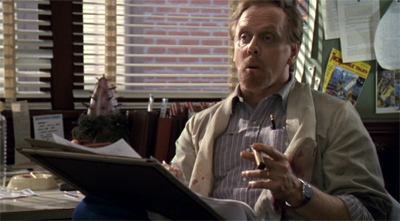
The art of pulp.
Ira Steven Behr argued in favour of this ending, but lost. According to The Fifty-Year Mission , one of the deciding factors was the existence of a larger shared universe:
At one point I pitched the idea that at the end of the series everything would have been from the imagination of Benny Russell. Of course, they wouldn’t let me do that idea – it would have taken away the entire franchise. But what’s so crazy about the idea that DS9 was part of Benny’s mind? It’s part of Rick Berman’s mind and Michael Piller’s mind and my mind, Robert’s mind, Hans’ mind, René’s mind, and Ron’s mind. So, of course it’s part of someone’s mind.
Behr makes a very valid point, and there is something to be said for expanding the theme of Far Beyond the Stars to encompass all of Deep Space Nine and arguably all of Star Trek .
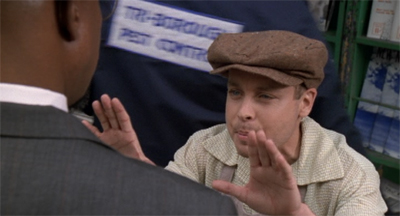
I read the news today, oh boy…
There is a lot to be said for Behr’s argument. Star Trek is not real. It is a multimedia franchise. It is not a documentary from the future, it is a drama that is authored by staff writers. Given the almost mythic quality of the franchise, and its unique place in popular consciousness, there is something to be said for suggesting that the strongest interpretation of Star Trek is the dream of a hopeful future from somebody who has lived in a world without that hope or that dream.
Of course, there any number of counter-arguments. A dream ending might be seen to undercut all of the stories that came before, particularly undercutting any sense of tension or drama. While the audience is aware that Star Trek is not real, actively reminding them of that fact at the very end of the last episode would seem the perfect way to sour the mood. More than that, revealing the entire franchise to be an extension of Benny Russell’s imagination would arguably be the sort of sly twist that Behr would never tolerate from any other Star Trek production team.
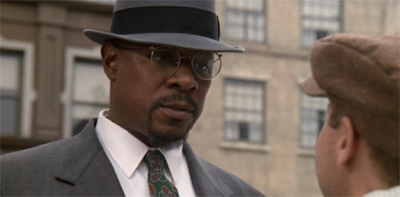
The write stuff.
Understandably, the production team were divided on the issue of whether Deep Space Nine should be considered the dream of Benny Russell. Discussing the finale with Cinefantastique , Hans Beimler opposed the idea:
Said Beimler, “At one point we were considering ending the series with Benny Russell walking the station, what he had imagined. But Benny Russell was something that was introduced in the sixth season. It’s not an element from the beginning. It’s important that this series be a seven-year arc, not a two-year arc, so to end on that note I think would have been inappropriate . It’s an interesting way to go, but you have to look at the series in its entirety, and I think that’s why we made the decisions that we made.”
It is a fair argument. It seems unreasonable to hang the big final twist of the final episode on an episode that aired in the middle of the sixth season, ignoring the one-hundred-and-seventy-odd episodes around it.
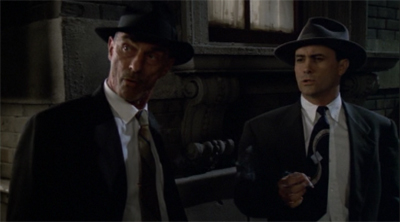
A little L-T on details…
At the same time, Beimler’s logic is not entirely convincing. After all, What You Leave Behind does not really pay off Emissary in any substantive way. Sisko’s one job in Emissary was to bring Bajor into the Federation. That narrative thread was left untied, last discussed in Rapture . If Beimler is arguing that a series finale has an obligation to go right back to the start in order to wrap up a “seven-year arc” , then the choices made by the production team do not reflect that.
More to the point, What You Leave Behind ultimately hinges on a set of plot point introduced in the fifth season and clarified in the sixth season. The Dominion War was declared in Call to Arms , but took over the show in A Time to Stand . The Pah-Wraiths were introduced in The Assignment , but the promise of an epic showdown with the Prophets was cemented in The Reckoning . However the twin climaxes of What You Leave Behind were the end of the Dominion War and the final battle with the Pah-Wraiths.
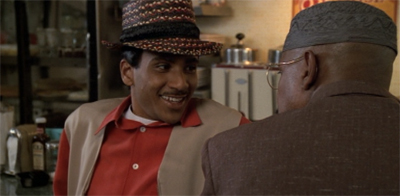
Hussling Russell.
There’s inherently nothing wrong with delivering on these more recent threads. Indeed, Deep Space Nine has been quite good at improvising as it goes, picking up plot points as it moves forward. The production team have never been afraid to drop elements that weren’t working and add new details to the overall arc. The Maquis plot was wrapped up in Blaze of Glory , while Rapture seems to put a pin in the idea of Bajor joining the Federation at any point in the near future.
With all of that in mind, there’s certainly no reason why What You Leave Behind couldn’t include a callback to Benny Russell and Far Beyond the Stars . The episode is certainly strong enough to support that eight, and deserves to be singled out as one of the defining stories from the seven-season run of Deep Space Nine . Certainly, a small shot at the end of What You Leave Behind would not feel unnecessarily intrusive. It would not be like awkwardly shoehorning William T. Riker and Deanna Troi into These Are the Voyages…
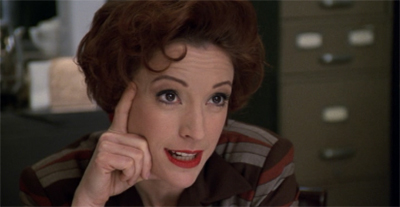
K.C. in point.
For his part, writer Ronald D. Moore always appreciated the ambiguity of Far Beyond the Stars :
My own opinion is that this is one of the best things about the episode. I always liked the idea that all of DS9 may be nothing more than the fevered imaginings of Benny Russell. I still get a kick out of the ending and think it is one of the key ingredients to elevating the show to something very special.
Perhaps that might have been cheapened by deciding one way or another at the end of What You Leave Behind .
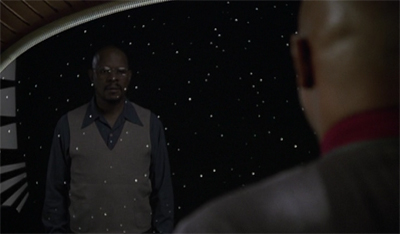
There is something powerful in that twinned image of Benjamin Sisko staring out of the window of his quarters, looking at Benny Russell staring back from inside his apartment. Which one of those reflections is real? Is either of them? Are both? Are they both figures of some greater slumbering imagination, neither having a great claim to being “real” ? If the future of Star Trek is real because Benny can dare to imagine it, does that mean that Benny is real because Sisko can dare to imagine him?
It is beautiful stuff. Like Star Trek itself, Benny is at once the dreamer and the dream.
You might be interested in our reviews of the sixth season of Star Trek: Deep Space Nine :
- A Time to Stand
- Rocks and Shoals
- Sons and Daughters
- Behind the Lines
- Favour the Bold
- Sacrifice of Angels
- You Are Cordially Invited…
- Resurrection
- Statistical Probabilities
- The Magnificent Ferengi
- Who Mourns for Morn?
- Far Beyond the Stars
- One Little Ship
- Honour Among Thieves
- Change of Heart
- Wrongs Darker Than Death or Night
- Inquisition
- In the Pale Moonlight
- The Reckoning
- Profit and Lace
- Time’s Orphan
- The Sound of Her Voice
- Tears of the Prophets
Share this:
Filed under: Deep Space Nine | Tagged: benny russell , better future , deep space nine , Dominion War , hatred , metafiction , racism , star trek , star trek: deep space nine , utopia |
24 Responses
This is an excellent episode, and I always felt it was sort of DS9’s The Inner Light. In both episodes, a large part of the power has to go to the actors. When you read just the screenplay, it still works, but the power is lost a little bit. Avery Brooks’ and Patrick Stewarts’ powerful performances truly do help anchor both the episodes.
I also like that in this episode we don’t truly get an explanation for what happened. Sometimes, the most affecting moments in our lives are things we can’t really explain, and I like that the episode didn’t feel the need to provide some technobabble explanation for the events.
I will say that I have two small quibbles with this episode. One is that it feels as if the role of the female syfy writer is downplayed a little too much. I get that it is Sisko’s story, but she felt a little unfairly marginalized. The other issue I have is with Joseph Sisko’s preacher character. That felt a bit too much like the cliched mystic negro character, and I wish they could have tweaked him to make him more realistic.
William, Brock Peters is absolutely the actor you want quoting from Revelations! Casting = justified. I think it was pretty well understood to the audience (well, to me on first viewing) from his first scene that he was definitely not Joseph, something more than a preacher, and clearly speaking on behalf of the Prophets (“Praise to the word of the prophets”).
The Magical Negro is a problematic character primarily because he shows up to solve the white guy’s problems. Prophet/Joseph doesn’t solve Benny’s problems and Benny ain’t white (thank you, yes, I am Captain Obvious).
I’d argue that there’s also some nice symmetry there. Joseph is Sisko’s father. So of course he shows up as a Father (of sorts) in Sisko’s vision. It’s kinda like Odo showing up as a passive character with fascistic leanings or Quark being strangely fundamentally decent underneath a dramatic exterior or O’Brien fixing things.
I don’t know. I think Kay’s situation is made as clear as possible while keeping her a supporting player. I thought it was a nice character touch when she figures out who should be having the dream after Albert comes up with a very mechanical solution to the problem, because of course she understands what it is to dream of a better world.
I’m now watching Deep Space Nine marathon on Netflix they have all the episodes…
I hope you enjoy. It is a fantastic show.
Far Beyond the Stars is a curious diversion among DS9’s excellent sixth season, but it’s also a strong contender for not just best episode of the year, but perhaps the entire series as well. There have been episodes during this time in DS9’s history that have told stories away from the Dominion War, and while some are better than others, Far Beyond the Stars goes one better by transplanting the entire cast of characters into a whole other scenario.
The onset of the Dominion War shakes Sisko’s deepest beliefs on a number of occasions. S6 touches base with it in A Time to Stand, Far Beyond the Stars and In the Pale Moonlight until it culminates in him taking a Starfleet leave of absence in Tears of the Prophets.
Truthfully, Sisko has always had a problem with matters of faith. Losing his wife Jennifer to a Borg attack nearly led to him resigning his Starfleet commission (in Far Beyond the Stars he only considers it) as well as his continued scepticism that he’s the Bajoran Emissary. Sisko’s convictions have never been on the same page as his courage. And Far Beyond the Stars is interesting for the way it casts Sisko in the role of a man also struggling to maintain faith in the face of overwhelming opposition.
After the latest casualty of the Dominion War takes another toll on Sisko’s sanity, he suddenly finds himself living the life of Benny Russell, a frustrated SF magazine writer in 1953, dreaming of a much better future for blacks everywhere. But racism is rife, and Benny faces either doubt from his own people, or open hostility from others for even daring to dream of such things.
Benny pours his hopes, dreams and emotions into his writing, and after seeing a rough sketch of a futuristic space station, he starts envisioning the most important people in his life as the denizens of that station, and the universe it inhabits. But he can’t see any of his work in print because of the heretical notion of a black captain.
Far Beyond the Stars may seem baffling to the novice viewer, and it could be to even a seasoned Trek veteran because watching it for the first time is akin to seeing an alternate reality. But unlike DS9’s perennial Mirror episodes, where the same players are engaged in a whole different ballgame, Far Beyond the Stars takes the same idea and runs with it to somewhere far more fulfilling.
On two separate occasions, Sisko/Benny looks at his reflection and it becomes a literal window into some other life and some other world. Benny’s dreams begin to take shape in the waking world, and blur to such a degree he can no longer recognise the difference. But beyond that, it does have something to say that Star Trek is usually reluctant to – addressing the subject of race.
Trek is a multicultural franchise. TOS in particular has a command crew made up of many different nationalities. Much could be said of TNG, DS9 and VGR, that expands the net even further to include aliens, androids and holograms. But this is something usually taken at face value, and is something Star Trek doesn’t talk about. Far Beyond the Stars is the exception, and puts the subject of race in a frank perspective (Cirroc Lofton even gets to use the N-word).
Unlike the way VGR clumsily introduced misogyny to the Kazon in order to reinforce Janeway’s position as a female authority figure, Far Beyond the Stars is a surprisingly pure, open account of how difficult it is to maintain a morality when confronted by those who can’t see past a person’s race, creed or gender. The episode even literalises it by removing all of the prosthetics and funny faces, allowing each of the actors to speak from they’re hearts.
This episode contains some of the best acting spanning the entire franchise, with Avery Brooks’ impassioned breakdown at the climax particularly impressive – a scene that shows some real acting from Brooks, and should have accrued him some prizes, but he was criminally overlooked (like Marc Alaimo in Waltz).
By the end, Sisko’s experience allows him to persist with his duties, but hindsight lends the episode an added air of poignancy when subsequent S6 episodes (a season particularly hard on Sisko) show how tenuous faith can be. This is something illustrated by the episode itself when Sisko confides in his father “Everytime I achieve a real victory, something like this happens and everything seems to turn to ashes!”
When I reviewed Waltz, I said DS9’s sixth season just gets better and better. Far Beyond the Stars is proof that so too does the series as well.
It really is a beautiful piece of television.
I meant to mention this before Darren but there was no room for it – I’m glad you name-checked Richard Scheib in your review. Moria is one of my favourite websites and Scheib one of the best of online film critics. His reviews are required reading whenever I’m about to check out a new genre film and I think he’s criminally underrated. It was such a lovely surprise to see an excerpt from one of his reviews here. Thankyou Darren for shining a light on one of the most overlooked online genre contributors.
Thanks David. I try to get a broad sampling of popular culture in these reviews. Standing on the shoulders of giants, and so forth.
I always read Pabst as somewhat an analogue for Rick Berman.
There seems to be several layers of character analogues here – the regular characters (from the future) with their fictional 50’s counterparts; those 50’s counterparts with their real analogues from the 50s (Asimov, Fontana, etc); and those real 50’s scifi creators with the real scifi creators who made DS9.
Ira Behr was very canny and professional dealing with Berman, because Behr and company understand show business very well (hell, they even fetishize it). That doesn’t mean that they weren’t frustrated by Berman’s conservatism on occasion.
And I’m not one to completely dismiss Berman – he did contribute to Star Trek in positive ways. But that doesn’t negate the negative effects resulting from his decisions during his tenure of producing Star Trek.
I always remember this comment from Moore: “This is one of those uncomfortable questions I hated getting when I was working on the show, because there is no good answer for it. There is no answer for it other than people in charge don’t want gay characters in Star Trek, period. This stuff about, How would you know? Maybe there are lots of people walking through those corridors that are actually gay. What would you have us do? Show them holding hands? That would be ridiculous. Our regulars don’t hold hands, which its own kind of a sad commentary on the state of human relations, that they can’t even hold hands. Just think about what it would say to have a gay Starfleet captain. It would mean something in Star Trek. It would mean something in science fiction. It would mean something in television. Why isn’t Star Trek leading the way anymore, in the social, political front?”
This episode is a healthy dose of self-criticism. I don’t believe any of the 50’s characters were intended as exact analogous to any of the show’s writers; however, I do believe they may have been intended to reflect the writers’ attitudes towards Berman’s “no gays” policy – from outspoken denouncement (Herb), to focusing on maintaining cordiality (Julius), to quiet support for those challenging the status quo (Albert).
I don’t think this episode was primarily an allegory for the conservative politics of the Berman administration – but that is certainly what it was about in part.
When looking back on Berman’s tenure, it’s difficult to disagree with Herb Rossoff’s assessment: he was a coward.
That’s an intriguing read, actually. I hadn’t really thought of that, beyond the obvious parallel of Pabst and Berman both being very conservative stakeholders and overseers. If that’s the case, would it make Behr out to be Herb? That might also fit, given Behr’s long-standing affection for Quark.
I do allude to the cowardice regarding homosexual characters in the review, but you’re right, it might be a much bigger thing than I make it. Particularly since I wrote this review before watching Chimera, which seems very explicitly to be about the way that the Star Trek franchise’s liberalism failed with regard to LGBTQ people.
The first time Christianity is recognized in Star Trek, isn’t it? Besides that I found this show to be extremely moving and ridicilously well played. Still, the similarites of the “imagined”/50s characters to their “fiction”/ST counterparts were intriguing. The police (Weyoun/Dukat) as the bad guys, O’Brien’s affinity to robots/tech, etc. I just found the part of Dax a little unsettling – what does this tell us about Sisko’s impression of her beyond the “old man”-attitude?
And to repeat the praise of the acting. Anyone claiming Avery Brooks were a bad actor may have a look at this episode. He is so nuanced, so believable in his pain, so different and still so similar to Sisko…. Just great! You can see the pain in his eyes, you feel it.
You could argue for certain TOS episodes have shades of it, like Who Mourns for Adonais? (the whole “one god is enough for us”) and Bread and Circuses (the way they react to Christianity as the default “correct” belief system for an alien planet) as suggesting Christianity exists in the Federation. There are also certainly shades of it to the wedding ceremony in Balance of Terror, if more from the set design than the dialogue (“our many beliefs”).
But don’t forget Janeway’s “and by the powers vested in me by Starfleet Command”. Does every starship captain in the Federation have a God complex by the 24th Century?
The war is weighing on Sisko, and the death of a friend does him no favors. It makes sense, really, considering what he’s been through and the responsibility he has on his shoulders. He’s in control of the most crucial location in the entire war-lose it, and it’s over. He’s probably something of a galactic hero to the Federation. The Prophets send him the vision of Benny Russell to reinvigorate him. “Far Beyond the Stars” is about Benny and his struggle on one level, absolutely, but it’s that combined with all the other layers that elevate it into the stratosphere. It’s a straightforward tale of prejudice, executed very well without dipping into problematic territory. It’s an ode to the power of believing in a better future. It’s a fun meta episode about the nature of Star Trek. Armin Shimerman said it best-it’s perfect science fiction.
It’s a fantastic piece of television.
If Benny could keep dreaming of a better world despite all of the obstacles in his path, then Sisko can keep on moving forward and do what needs to be done.
I like how it allows Sisko to process some of the issues he’s been sitting with all season—like, the image of Jake being killed by Dukat and Weyoun is something that probably kept Sisko awake at night for months in a way he never really let himself acknowledge.
Alexander Siddig is biracial, no? Or if he doesn’t identify that way, he is at least, a person of color. Yet his character “passed” or was not subject to the same type of discrimination that Benny was. I loved this episode but I think it would have been even stronger if there was even a line or two acknowledging that element as well. It would even reflect somehow the different type of “passing” that Bashir benefitted from as a genetically modified individual.
There are so many levels as to how this episode remains incredibly relevant, but I really love its critique of genre fans that think somehow casting protagonists with underrepresented minorities (of all types) is pandering. Representation matters!
Interesting points about Siddig and Bashir. I’d never really thought of it like that. I figured that his Britishness served to exclude him from these sorts of obvious prejudices, coupled with the fact that – like Benny before that vision – he also didn’t upset the apple cart.
Yet he is included in the cast photo, right? Pretty interesting for a Sudanese person, even a Sudanese Englishman.
Something I never noticed before is how much of this episode is Sisko being given some space to acknowledge and process some of the trauma and anxiety he must have been sitting on for a long time. For instance, the specific image of Jake murdered by Dukat and Weyoun is something that must kept him awake at night for months during Dominion control of the station.
Leave a comment Cancel reply
This site uses Akismet to reduce spam. Learn how your comment data is processed .
Recent Posts
- 373. Pirates of the Caribbean: The Curse of the Black Pearl (#225)
- 371. Poor Things (#246)
- 370. Dune: Part Two (#12)
- 369. Memento (#57)
- 368. Monty Python and the Holy Grail (#154)
Recently tweeted…
- "I Simply Am Not There": The Existential Horror of Eighties Excess in "American Psycho"...
- Star Trek: The Original Series (Reviews)
- Star Trek: Deep Space Nine (Reviews)
- Star Trek: Voyager (Reviews)
Available at…

Blogs Well Worth Your Time
- 1001 Must See Films
- Andrew at the Movies
- Anomalous Material
- Cut the Crap Movie Reviews
- Encore Entertainment
- Fandango Groovers
- FlixChatter
- Four of Them
- It Rains… You get Wet…
- Jameson Cult Film Blog
- Jar Watches Films
- Let's Go To The Movies
- M. Carter at the Movies
- Marshall and the Movies
- Movie News First
- Musings from a Man Lost in La Mancha
- Never Mind Pop Film
- Paragraph Film Reviews
- Roger Ebert's Journal
- Ross v. Ross
- Scannain.com
- Screenwriter (Donald Clarke, Irish Times)
- Strange Culture
- The Film Cynics
- The Pompous Film Snob
- The Projection Booth
- Things That Don't Suck
- Too Busy Thinking About My Comics
- Undy a Hundy
Film Nerd Resources
- CinemaBlend (News)
- Internet Movie Database
- Rope of Silicon
- The Guardian Film Blog
- James Berardinelli
- Roger Ebert
Email Subscription
Enter your email address to follow this blog and receive notifications of new posts by email.
Email Address:
Sign me up!
Blog at WordPress.com. WP Designer.
- Already have a WordPress.com account? Log in now.
- Subscribe Subscribed
- Copy shortlink
- Report this content
- View post in Reader
- Manage subscriptions
- Collapse this bar

- Kindle Store
- Kindle eBooks
- Science Fiction & Fantasy
Promotions apply when you purchase
These promotions will be applied to this item:
Some promotions may be combined; others are not eligible to be combined with other offers. For details, please see the Terms & Conditions associated with these promotions.

Buy for others
Buying and sending ebooks to others.
- Select quantity
- Buy and send eBooks
- Recipients can read on any device
These ebooks can only be redeemed by recipients in the US. Redemption links and eBooks cannot be resold.

Download the free Kindle app and start reading Kindle books instantly on your smartphone, tablet, or computer - no Kindle device required .
Read instantly on your browser with Kindle for Web.
Using your mobile phone camera - scan the code below and download the Kindle app.

Image Unavailable

- To view this video download Flash Player
Follow the author
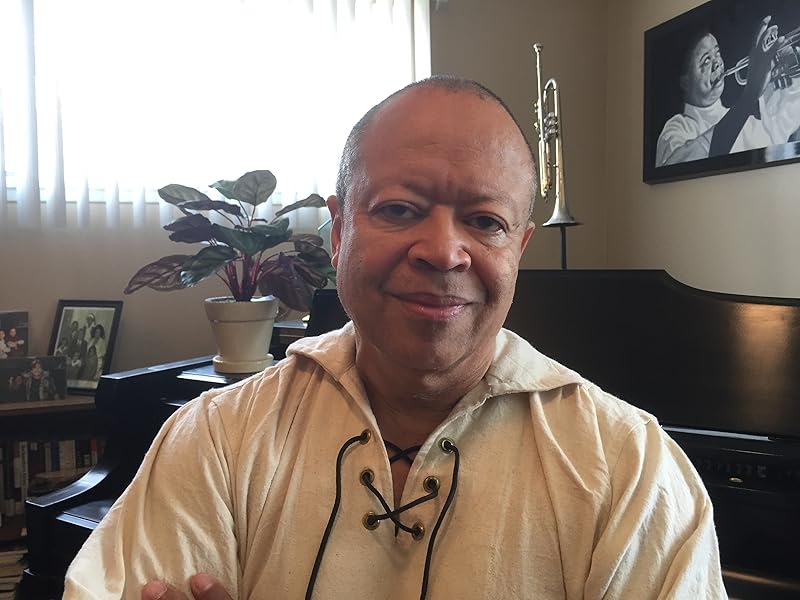
Far Beyond the Stars (Star Trek: Deep Space Nine) Kindle Edition
- Print length 292 pages
- Language English
- Sticky notes On Kindle Scribe
- Publisher Pocket Books/Star Trek
- Publication date September 22, 2000
- File size 2191 KB
- Page Flip Enabled
- Word Wise Enabled
- Enhanced typesetting Enabled
- See all details
Customers who bought this item also bought

Editorial Reviews
About the author, excerpt. © reprinted by permission. all rights reserved..
Copyright© 1998 by Steve Barnes
Product details
- ASIN : B000FC0OAO
- Publisher : Pocket Books/Star Trek (September 22, 2000)
- Publication date : September 22, 2000
- Language : English
- File size : 2191 KB
- Text-to-Speech : Enabled
- Screen Reader : Supported
- Enhanced typesetting : Enabled
- X-Ray : Not Enabled
- Word Wise : Enabled
- Sticky notes : On Kindle Scribe
- Print length : 292 pages
- #770 in Star Trek Series
- #7,504 in First Contact Science Fiction eBooks
- #15,506 in Science Fiction Adventure
About the author
Steven barnes.
There was a specific moment in my life when I realized I was a writer. I'd tried to stop writing, to make my Mom happy. My dad had been a back-up singer for Nat "King" Cole, and had failed in his career, and it damaged my family. Mom was afraid my dreams would send me down the same drain. So when I got to Pepperdine University, I studied drama, radio, journalism, composition, literature...everything except writing. Dancing all around it. Then one day they announced a short story contest, and I entered. And won. And found myself reading my story to a field full of alumni who were smiling, and laughing, and nodding, and then applauding. And...I realized. I got it. I was a writer. THIS was what I loved, more than anything. And that I would rather fail as a writer than succeed at anything else.
Never forgotten that moment, and it has sustained me for the rest of my life. No matter how bad things ever got, I CHOSE THIS.
Never asked for an easy life. I asked to be strong enough to survive an authentic one.
--Steven Barnes
Customer reviews
Customer Reviews, including Product Star Ratings help customers to learn more about the product and decide whether it is the right product for them.
To calculate the overall star rating and percentage breakdown by star, we don’t use a simple average. Instead, our system considers things like how recent a review is and if the reviewer bought the item on Amazon. It also analyzed reviews to verify trustworthiness.
- Sort reviews by Top reviews Most recent Top reviews
Top reviews from the United States
There was a problem filtering reviews right now. please try again later..
- Amazon Newsletter
- About Amazon
- Accessibility
- Sustainability
- Press Center
- Investor Relations
- Amazon Devices
- Amazon Science
- Sell on Amazon
- Sell apps on Amazon
- Supply to Amazon
- Protect & Build Your Brand
- Become an Affiliate
- Become a Delivery Driver
- Start a Package Delivery Business
- Advertise Your Products
- Self-Publish with Us
- Become an Amazon Hub Partner
- › See More Ways to Make Money
- Amazon Visa
- Amazon Store Card
- Amazon Secured Card
- Amazon Business Card
- Shop with Points
- Credit Card Marketplace
- Reload Your Balance
- Amazon Currency Converter
- Your Account
- Your Orders
- Shipping Rates & Policies
- Amazon Prime
- Returns & Replacements
- Manage Your Content and Devices
- Recalls and Product Safety Alerts
- Conditions of Use
- Privacy Notice
- Consumer Health Data Privacy Disclosure
- Your Ads Privacy Choices
Star Trek's George Takei pens children's book detailing childhood in World War II internment camps
"My Lost Freedom," is an autobiographical account of his experience as a child.
George Takei, who portrayed Hikaru Sulu in the "Star Trek" series, details his experience growing up in Japanese-American internment camps during World War II in his new book.
Takei's children's book, "My Lost Freedom," is an autobiographical account of his experience as a 5-year-old in a Japanese-American internment camp during World War II. The book aims to reach children and their parents.
The book recounts Takei's time as a child in a Japanese internment camp in Rohwer, Arkansas, a dark chapter in American history.
"I remember the terror, the confusion, the chaos of being moved constantly from one place to another, one strange part of the country to another," Takei told ABC News Live. "And so that's my real memory that I have. But I didn't understand what that was all about."
ABC News Live interviewed Takei about his new book, which pays tribute to his parents.
ABC NEWS LIVE: Many of you know him best as Hikaru Sulu from the Star Trek series, but his journey extends far beyond the stars. His new book, "My Lost Freedom," details his experience growing up in Japanese-American internment camps during World War II.
Joining us now is a true legend, actor, activist, social justice icon George Takei. Sir, thanks so much for joining us.
GEORGE TAKEI: Good to be here, appreciate it.
ABC NEWS LIVE: You're teaching us things already, not just in this book. This book details a really, you know, a dark chapter, in this country's history and in your own personal history. Why did you want to tackle it in a children's book?
TAKEI: Well, I was a child then. I was 5 years old, and I wanted to share, share this story, as an autobiography that was published in 1994. I did also a graphic memoir because I wanted to reach teenagers and, as a teenager, I loved comic books. So I told the same story as, from the vantage point of a teenager, to reach them. But with this one book, "My Lost Freedom," I'm reaching for two generations. The parents and their kiddies.
ABC NEWS LIVE: Absolutely. Because it's not just the kids reading it, it's the adults reading it to the children and having a conversation.
TAKEI: Exactly.
ABC NEWS LIVE: Opening up a conversation. I'm wondering, I know you wrote about it. You know, in the book that came out in 1994. And this is a different way of talking about it. Is it painful to relive this period or is it cathartic? Therapeutic in a way.
TAKEI: I think for my parents, the greatest pain was felt. I was 5 years old. Four years, five, six, seven, eight, four years of my life, in imprisonment. My brother was a year younger than me. And our baby sister went in as an infant. And so the first four years of her life was behind those barbed wire fences.
ABC NEWS LIVE: How did your family keep hope going?
TAKEI: So I remember the terror, the confusion, the chaos of being moved constantly from one place to another, one strange part of the country to another. And so that's my real memory that I have. But I didn't understand what that was all about. And as a teenager, out of camp and a few years having elapsed, I was very curious about my childhood imprisonment, and I went to libraries to look for books on it. Couldn't find a thing.
ABC NEWS LIVE: Do you think it had anything to do with you growing up, you know, having the career you had, but being the activist that you have turned into. Do you think it shaped you in that way?
TAKEI: Well, as I said, those after-dinner conversations that I had with my father, he said, and he loved quoting from the Gettysburg Address, President Lincoln's historic speech: "Ours is a government of the people, by the people and for the people." He said, "those are noble words. That's what makes American democracy so singular." But those words are also the weakness of American democracy because it's a people's democracy and people are fallible human beings, and they get swept up by the hysteria of the time and by racism and the president is also a human being. His other were tens of thousands of people that look just like the people that bombed Pearl Harbor. Living on the West Coast.
ABC NEWS LIVE: That weren't those people.
TAKEI: And he signed an executive order ordering all Japanese-Americans on the West Coast to be rounded up with no charge, no trial, no due process, in the most un-American way to be. Rounded up and imprisoned in barbed wire prison camps in some of the most hellish places and most desolate places in the country.
ABC NEWS LIVE: Yeah, it was a, it was a hugely dark time in this country's history. And to be able to put it in a book like this, to not only teach children, but the adults who are reading it to them, is really spectacular thing.
TAKEI: Well, I had to simplify it.
ABC NEWS LIVE: Absolutely
TAKEI: We don't deal with the loyalty question.
ABC NEWS LIVE: George, thank you so much; we so appreciate you coming in. You can purchase "My Lost Freedom" wherever books are sold
Related Topics
Top stories.

Mother who went missing on bike ride died by homicide, autopsy shows
- 2 hours ago

College protests live updates: Columbia tells protesters to leave camp by 2 p.m.

'Numerous' law enforcement officers struck by gunfire in Charlotte: Police
- 11 minutes ago

Ralph Yarl, teen shot after mistakenly going to the wrong house, files civil lawsuit
- Apr 29, 10:08 AM
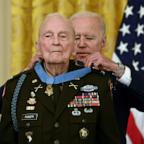
Medal of Honor recipient Col. Ralph Puckett to lie in honor in Capitol rotunda
- 21 minutes ago
ABC News Live
24/7 coverage of breaking news and live events
Screen Rant
10 best anime series every fan of frieren: beyond journey's end needs to watch.
Frieren: Beyond Journey's End is one of the biggest anime to come out in recent years, and its fans will surely be looking for similar shows to watch.
- There are plenty of anime that are great for fans of Frieren: Beyond Journey's End .
- Some anime are great for offering similar takes on adventuring through fantasy worlds as Frieren does.
- Others are great for the overlap they have with Frieren 's writing style and overall themes.
Frieren: Beyond Journey’s End is easily one of the biggest anime of the past few years. Not only does it have gorgeous art, animation, and overall direction, but its straightforward take on the fantasy genre, combined with intelligent and emotionally resonant writing, made it a major hit among fans and critics alike to a degree that very few anime have ever managed to achieve.
The first season of Frieren received unanimous praise from fans and critics alike. It’s currently unknown when Frieren: Beyond Journey’s End will return for a second season, if at all, but fortunately, there are plenty of anime that fans of the series can watch.
As unique a series as it may be, there are plenty of great anime that overlap with Frieren: Beyond Journey’s End in terms of themes, characters, and overall quality ; a few anime, in particular, are especially worth highlighting, and any fan of Frieren: Beyond Journey’s End is sure to get a lot out of them, even if it’s not the same experience.
10 Best Fantasy Anime Every Lord of the Rings Fan Needs to Watch
10 wandering witch captures the same pure essence of traveling as frieren, anime series by c2c; based on the light novel by jogi shiraishi.
C2C’s Wandering Witch: The Journey of Elaina stars Elaina the Ashen Witch, a young witch who travels the world in the hopes of living a life of adventure like her idol, the great witch Niké. Elaina takes it upon herself to not interfere in anything she witnesses on her travels, no matter how terrible something may be, but there are occasions where, at the very least, Elaina’s passivity does deeply affect her and force her to question her resolve.
Wandering Witch isn’t that well-known of an anime, but it’s still a great recommendation for fans of Frieren: Beyond Journey’s End . Wandering Witch: The Journey of Elaina is, like Frieren: Beyond Journey’s End , a thoughtful story of a magical being traveling across the world , but Elaina is a far more selfish person than Frieren, so it creates a different sort of traveling story, especially when her selfishness ends up hurting herself and others. Overall, Wandering Witch has the same sort of aesthetic as Frieren , but adds a unique-enough flavor to create a different experience, so it’s plenty worth checking out.
9 Kino’s Journey Highlights The Beauty & Danger Of The World, Just Like Frieren
Anime series by acgt; based on the light novel by keiichi sigsawa.
ACGT’s Kino’s Journey—the Beautiful World— is about Kino, a young girl traveling the world with no one by her side except her talking motorcycle, Hermes. Kino makes it a rule not to stay in one place longer than three days in two nights to keep herself from getting too attached, and with how dangerous some of the places she visits can be, she always makes sure to keep a variety of weapons with her, most notably her .44 single-action revolver the “Cannon” and her .22 automatic pistol the “Woodsman”.
Similar to Wander Witch: The Journey of Elaina , Kino’s Journey—the Beautiful World— is great for anyone who was a fan of the adventuring aspect of Frieren: Beyond Journey’s End . Not only do both stories have characters going on episodic adventures around the world, but the dark and fantastical nature of the places in Kino’s Journey—the Beautiful World— always adds something new to each story , whether it’s purely in aesthetic or in the themes the audience is expected to contemplate. Adventure is always used for thought-provoking storytelling, so that makes it perfect for fans of Frieren: Beyond Journey’s End .
8 Mushishi Is Another Great Anime About Supernatural Good Samaritans
Anime series by artland; based on the manga by yuki urushibara.
Artland’s Mushishi is an episodic anime set vaguely in 19th-century Japan where people are constantly plagued by ethereal beings called Mushi. As one of the few people who can see Mushi, series protagonist Ginko has taken it upon himself to research Mushi and aid those who suffer because of them whenever he comes across them in his travels.
From start to finish, Mushishi is an anime that does a great job of playing into the same core aesthetic of Frieren: Beyond Journey’s End . The element of traveling through a supernatural setting is one thing, but Mushishi being an episodic story of a supernatural good samaritan has a clear overlap with Frieren: Beyond Journey’s End , although Mushishi is the far more episodic story of the two. Nevertheless, both anime excellently play into the idea of good people just trying to help others, so any fan of one is sure to get a lot out of the other.
7 To Your Eternity Is Another Great Story About The Struggles Of Immortality
Anime series by drive; based on the manga by yoshitoki oima.
Drive’s To Your Eternity opens with a mysterious being called the Beholder releasing an orb into the world that takes on the form of anything that dies around it. The orb eventually becomes an immortal being named Fushi, and through his travels, he constantly befriends new people he’s always fated to outlive and must slowly come to understand why living that sort of life is so tragic.
Unlike some other anime, To Your Eternity ’s overlap with Frieren: Beyond Journey’s End is through one of the more tragic elements of its story. Both To Your Eternity and Frieren: Beyond Journey’s End revolve around nigh-immortal beings dealing with the reality of outliving the people closest to them , and sure enough, both anime use it to tell tragic and bittersweet stories from start to finish. The emotional beats of Frieren ’s writing have always been one of its biggest draws, and anyone who’s a fan of that is sure to be a fan of To Your Eternity .
6 Bocchi The Rock! Is Another Gorgeous Anime From Frieren’s Director
Anime series by cloverworks; based on the manga by aki hamazi.
CloverWorks’ Bocchi the Rock! stars Hitori Gotoh, a girl with crippling social anxiety who learned to play guitar in the hopes of using it to make friends, although her efforts never once managed to bear fruit. One day, however, Hitori is recruited to be the new guitarist in the band Kessoku Band, and as Hitori - now with the nickname Bocchi - commits herself to the band, she’ll find herself slowly but surely gaining the exact life she hoped for when she first started learning the guitar.
Bocchi the Rock! is a completely different story from Frieren: Beyond Journey’s End , but that doesn’t mean fans of the latter shouldn’t watch it. Both anime were directed by anime director Keiichiro Saito, and sure enough, both Bocchi the Rock! and Frieren: Beyond Journey’s End feature some of the best animation and overall direction of any anime that’s come out within the past few years. Keiichiro Saito is one of the best directors to come out of anime in the past few years, and if anyone wants to see what else he’s capable of, there’s no better anime to watch than Bocchi the Rock!
5 Spice And Wolf Excellently Makes The Mundane Entertaining
Anime series by brain's base & passione; based on the light novel by isuna hasekura, spice and wolf: merchant meets the wise wolf (2024).
Spice and Wolf is a low-fantasy anime about a traveling merchant named Kraft Lawrence who, one day, comes across a woman with wolf ears and a tail sleeping in his cart. The woman introduces herself as a harvest goddess named Holo, and after Lawrence helps Holo leave the confines of the village where they met, the two embark on a journey to bring Holo back to her birthplace while doing merchant work whenever and wherever it might come up.
Spice and Wolf is a very different sort of fantasy series from Frieren , but their similarities become readily apparent in their writing. In addition to characters having dry wit and largely unexaggerated dialogue, Spice and Wolf , much like Frieren: Beyond Journey’s End , is much more focused on the minute details of worldbuilding than it is on the action , specifically the inner workings of economics and trading, and the execution always keeps it from being boring. It's a perfect anime for fans of Frieren , and with the Spice and Wolf reboot , now's the perfect time for someone to start watching.
4 Magi’s Worldbuilding & Magic Are Perfect For Frieren Fans
Anime series by a-1 pictures; based on the manga by shinobu ohtaka, magi: the labyrinth of magic (2012).
A-1 Pictures’ Magi: The Labyrinth of Magic depicts an Arabian Nights -style fantasy world where people can challenge mysterious dungeons for untold wealth and power that can change the world. Among the people who have a go at this are the young pair of Aladdin and Alibaba, and while the two of them originally just wanted to go on an adventure, they soon find themselves wrapped up in one major conspiracy after another that are all poised to upend everything they know about their world.
Magi: The Labyrinth of Magic ’s flavor of fantasy is very different from Frieren: Beyond Journey’s End , but fans of Frieren can still get a lot out of it. Much like Frieren: Beyond Journey’s End , Magi: The Labyrinth of Magic has incredibly intricate worldbuilding through its political elements and its highly-developed magic system , two things that are essential parts of Frieren ’s writing. It’s more lighthearted than some of its contemporaries, but with that sort of writing, it’s a perfect recommendation for fans of Frieren: Beyond Journey’s End .
3 Violet Evergarden Is A Beautiful Exploration Into Humanity
Anime series by kyoto animation; based on the light novel by kana akatsuki, violet evergarden.
*Availability in US
Not available
The titular hero of Kyoto Animation’s Violet Evergarden is a former orphan turned soldier who spent her entire life fighting in a war that’s only now come to an end. Now needing a new purpose in life, Violet takes up a job as a special type of ghostwriter called an Auto Memory Doll in the hopes that writing for others will help better understand people, and she especially hopes it will help her understand why her commanding officer told her he loved her before he died.
Kyoto Animation is famous for its emotionally driven anime, and Violet Evergarden is easily one of its best. From start to finish, Violet Evergarden does an excellent job of depicting its hero’s struggles with learning what it means to be human in an emotionally poignant fashion , something that, of course, is at the core of Frieren: Beyond Journey’s End ’s overarching narrative. Add in the consistently gorgeous visuals and overall direction, and Violet Evergarden hits nearly all the same aesthetics that made Frieren: Beyond Journey’s End such a hit.
2 Delicious In Dungeon Is The Perfect Fantasy To Complement Frieren
Anime series by studio trigger; based on the manga by ryoko kui, delicious in dungeon.
In Studio Trigger’s hit fantasy anime Delicious in Dungeon , the adventure party of series protagonist Laios is wiped out by a dragon, with Laios’ sister, Falin, even being eaten alive. Laios and what remains of his party need to hurry back through the dungeon to revive Falin, but they lack the funds for the journey and have no time to gather them up. To deal with the situation, Laios convinces everyone, much to their disgust, to eat the monsters they encounter in the dungeon, something Laios is all but stated to have just been looking for an excuse to do.
Delicious in Dungeon is great for fans of Frieren thanks to largely being its opposite. While they’re both largely straightforward fantasy anime, Delicious in Dungeon , while not wholly unserious, has a far more comedic approach to fantasy than Frieren: Beyond Journey’s End , so the two can be seen as two sides of the same coin and of equal value to anime fans looking for something different from isekai and power fantasy anime. Add in its own uniquely great writing and animation, and Delicious in Dungeon makes for as great a watch as Frieren for a lot of the same reasons.
1 Fullmetal Alchemist & Frieren Are Both Excellent Gateways Into Anime
Anime series by studio bones; based on the manga by hiromu arakawa, fullmetal alchemist.
Studio Bones’ Fullmetal Alchemist is set in a world where alchemy is very much real, and in the nation of Amestris, alchemists can join the military in exchange for near-limitless authority. One of these state alchemists is Edward Elric, the titular Fullmetal Alchemist, and after an accident with alchemy costs Edward his limbs and forces the soul of his brother Alphonse to be bound to a suit of armor, Edward starts looking for the mythical Philosopher’s Stone in the hopes of restoring their bodies, completely unaware of the forces his journey will bring him into contact with.
10 Best Anime So Good They'll Turn Even the Most Skeptical Viewers Into Fans
Notably, Fullmetal Alchemist was replaced by Frieren: Beyond Journey’s End in many anime rankings' top spot, despite being completely different in both genre and story. Thanks to its stellar art and animation and a story that’s both entertaining and not too overly complex, Fullmetal Alchemist , like Frieren: Beyond Journey’s End , is one of the best anime for getting people invested in anime , something that hasn’t changed in the slightest after over a decade. There’s a definite overlap between the two in that regard, and that’s why Fullmetal Alchemist is probably the best anime for fans of Frieren: Beyond Journey’s End .
- Stranger Things Season 5
- Deadpool and Wolverine
- The Batman 2
- Spider-Man 4
- Yellowstone Season 6
- Fallout Season 2
- Entertainment
10 best TV shows of 2024 so far, ranked

Considering that we’re not even halfway through the year yet, it may seem premature to start naming the best TV shows of 2024. Regardless, 2024 has already proven to have a great crop of new and returning shows for television fans, especially from streaming services like Netflix , Hulu, and Amazon Prime Video . When the major studios are cutting back on content, the original streaming series are the ones that challenge our expectations while reminding us that television is a medium that can offer more rewarding stories than a two-hour film.
10. True Detective: Night Country
9. 3 body problem, 8. mr. & mrs. smith.
- 7. X-Men ’97
6. We Were the Lucky Ones
3. the sympathizer, 2. tokyo vice.
It’s too soon to declare this to be the definitive list of TV shows for 2024, especially since we have a full seven months to go before the end of the year. By that time, our top 10 will likely feature a very different lineup of shows. But at this moment in time, these are our picks for the 10 best TV shows of 2024 so far.
Ironically, one of the biggest trolls for True Detective: Night Country was none other than Nic Pizzolatto, the creator of the series who had no involvement with the current incarnation of the show. Pizzolatto may not have been so agitated if Night Country hadn’t referenced the events of the first season so many times, although it is a marked departure from the show’s overall tone. Instead of only teasing occult or supernatural things as the first season did, Night Country embraces those elements.
- 10 best Netflix shows with more than 5 seasons, ranked
- The 50 best shows on Netflix in April 2024
- The 10 most popular TV shows on Netflix right now
Night Country isn’t as good as the first season of True Detective , but it’s far better to the two other seasons that preceded it. Jodie Foster and Kali Reis carry this season on their shoulders as former friends Police Chief Liz Danvers and Trooper Evangeline Navarro. The mystery they’re given to solve seems almost impossible to fully unravel, and there are some questions that remain unanswered by the time the final credits roll.
Watch True Detective: Night Country on Max .
Living up to the high quality of Game of Thrones was always going to be nearly impossible for David Benioff and D. B. Weiss. That show was like lightning in a bottle that redefined fantasy on television. While 3 Body Problem will probably not have the same transformative effect on sci-fi TV series. the show – which was co-created by Benioff, Weiss, and Alexander Woo based on the novel by Liu Cixin – has a very intriguing premise that only gets more interesting as the season goes on.
There is an alien invasion at the heart of this series that’s unlike any of the others we’ve seen on film or television. The aliens won’t arrive on Earth for centuries, but their chaotic and disruptive influence is already felt in the present. Military might and even science seem useless in the face of this threat, leaving some brilliant minds, including Jin Cheng (Jess Hong) and Augustina “Auggie” Salazar (Eiza González), to devise unconventional strategies against them. Others, like Saul Durand (Jovan Adepo), are very reluctantly drawn into the fight as well. It’s refreshing that things seem so dire for humanity, and yet the show still offers some hope for the future.
Watch 3 Body Problem on Netflix .
The 2005 Mr. and Mrs. Smith movie seemed like an excuse for Brad Pitt and Angelina Jolie to explore their animal magnetism toward each other. Donald Glover and Maya Erskine will probably not be following in the former super couple’s footsteps. But their incarnation of Mr. and Mrs. Smith – which was co-created by Glover – is much more compelling.
In this reboot, John (Glover) and Jane Smith (Erskine) don’t really know each other at all when they’re tasked to pose as a married couple while carrying out lethal missions. But inevitably, they start to have romantic sparks, which complicates their relationship and their overall mission. The show goes out of its way to test the Smiths’ loyalty to their employers and each other. And while there’s currently no word about a renewal, this is a story that deserves to be continued.
Watch Mr. and Mrs. Smith on Prime Video .
7. X-Men ’97
This is the dark horse pick on the list, because no one expected X-Men ’97 to match up with the original X-Men: The Animated Series , much less surpass it. What does a throwback comic book superhero series have to say about racism, bigotry, tolerance, tragedy, forgiveness, romance, heartbreak, and more in 2024? It turns out a lot, at least according to showrunner Beau DeMayo.
With this show, DeMayo delivered more than just a modernized take on an old cartoon series; it’s also one of the most thrilling pieces of superhero fiction in years. X-Men ’97 hasn’t shied away from taking narrative risks or shocking places that even the comics haven’t dared to go. If this series can maintain its momentum through the first season finale, the show may actually rank higher on our list before the end of the year.
Watch X-Men ’97 on Disney+ .
National Geographic’s A Small Light was one of last year’s best shows on Disney+ and Hulu, and We Were the Lucky Ones explores several of the same themes this year. The series begins shortly before World War II as the Kurc family – including Halina (Joey King), Addy (Logan Lerman), and Genek (Henry Lloyd-Hughes) – attempt to escape persecution for being Jewish as Germany expands its power across Europe.
The Kurcfamily’s situation quickly becomes dire as they are forced to flee their homes and their former lives. Not all of them are able to escape the grasp of the Nazis. But a few of the Kurcs manage to get out and survive, even if they may never be able to reunite as a family again.
Watch We Were the Lucky Ones on Hulu .
Fallout has been a surprisingly faithful take on the postapocalyptic video game franchise. The show successfully translates the games’ sense of humor and retrofuturistic elements while maintaining the drama and action. It also wisely gives Walton Goggins a lot to do as a bounty hunter known as The Ghoul, as well as a look at his distant past as a fully human Hollywood actor named Cooper Howard. Whenever Goggins appears, he lights up the screen.
Ella Purnell stars as Lucy MacLean, a young woman who has spent most of her life living in a vault separated from the rest of humanity. When Lucy finally emerges from the vault to find her missing father, she’s not prepared for the people of the wasteland or the dangers that await her. But Lucy does prove that she’s a survivor as she acclimates to her new life.
Watch Fallout on Prime Video .
The Crown ‘s Tobias Menzies was seemingly doomed to play either villains or weasels throughout most of his TV career. But Apple TV+ finally gave him a chance for a true leading role in Manhunt , a post-Civil War drama that takes place in the aftermath of the assassination of President Abraham Lincoln (Hamish Linklater). Menzies plays Edwin Stanton, Lincoln’s friend and his Secretary of War.
Stanton is so outraged by the murder of Lincoln that he personally leads the hunt for the president’s killer, John Wilkes Booth (Anthony Boyle). But in this era, it was a lot harder to find a fleeing suspect who already had a head start. It’s an incredibly tense time for both the country and for Stanton, whose sanity may be cracking under the strain.
Watch Manhunt on Apple TV+ .
The Sympathizer would probably have been one of the best dramas of the year even if Robert Downey Jr. wasn’t in it. But with Downey Jr. co-starring in several different roles, it’s a can’t-miss experience to see just how far he’ll go in his performances. Hoa Xuande stars as the Captain, a spy for North Vietnam who is so deeply embedded with the other side that he’s forced to join the South Korean refugees in America after the end of the Vietnam war.
The Captain soon finds himself feeling conflicted loyalties while in living in the U.S. Only a few episodes of The Sympathizer have been released to date, but it’s been so wildly entertaining that it’s bound to remain on this list by the end of the year.
Watch The Sympathizer on Max .
Tokyo Vice had a strong first season on Max, and an even stronger second season earlier this year. The series follows journalist Jake Adelstein (Ansel Elgort) as he attempts to make his name on Tokyo’s crime beat near the end of the 20th century. Jake thought he could handle anything the criminal underworld had to throw at him, even as Detective Hiroto Katagiri (Ken Watanabe) tried to dissuade him. Now, Jake’s in way over his head. and he’s not the only one in danger.
Much like our pick for No. 1 on this list, Tokyo Vice has expanded its focus beyond following the white foreigner living in Japan, which has only made it a more interesting show.
Watch Tokyo Vice on Max .
1. Shōgun
If you’ve been watching any TV shows this year, then it should come as no surprise that FX’s Shōgun landed on top of this list. The original 1980 adaptation of James Clavell’s novel was considered to be the best TV miniseries of its era. However, the modern take on Shōgun has far surpassed it. This miniseries feels more alive and authentic because it isn’t simply about John Blackthorne (Cosmo Jarvis), an English sailor who is trapped in Japan in 1600. If anything, Blackthorne is the second or third lead behind Lord Yoshii Toranaga (Hiroyuki Sanada) and Toda Mariko (Anna Sawai).
Blackthorne gets to live because Lord Toranaga sees value in him, but Toranaga has far greater issues to deal with as he fights his rivals and attempts to hold on to his power. Mariko’s story is also explored in greater detail as she tutors Blackthorne in the ways of Japan’s people while they form a bond with each other. The higher production values of this adaptation are cinematic in scope, and the show is already an instant classic. Shōgun is the TV series to beat in 2024, and a strong contender to remain at No. 1 when the year comes to an end.
Watch Shōgun on Hulu .
Editors' Recommendations
- 10 best film noirs of all time, ranked
- The best British TV shows on Netflix
- 10 best movies set in L.A., ranked
- 10 best 2010s sci-fi movies, ranked
- 10 best anime movies ever, ranked

The sci-fi genre owes much of its evolution to a myriad of television series that have shaped and redefined it over the years. These influential shows underscore the power of the small screen to captivate audiences, particularly through sci-fi's distinct combination of innovative storytelling and ambitious visuals. Whether viewers are fans of futuristic technology, extraterrestrial encounters, or dystopian futures, there's something for every kind of sci-fi lover among the genre's best entries.
From the groundbreaking brilliance of Star Trek to the modern masterpiece Black Mirror, the greatest sci-fi TV shows of all time have expanded the genre's horizons and left an indelible mark on pop culture in the process. They promise worlds beyond anyone's wildest imagination, with the mind-bending journeys they depict ending up being some of the most unforgettable adventures ever seen on television. 10. Black Mirror (2011-present)
It's not often that Netflix gets to add a pirate drama to its lineup of shows, simply because there aren't many live-action pirate series to begin with. But since Starz already spent the money to produce Black Sails a decade ago, Netflix gets to reap the benefits by adding it. Similarly, BBC America's spy thriller Killing Eve is also joining Netflix this month. Both shows had multiseason runs, which make them perfect for bingeing.
Our third addition to the lineup in April is One Day, a romantic drama that chronicles a relationship through its beginning and all the way to the end. One Day also has a lot of episodes compared to other Netflix originals, and you'll want to keep some tissues handy because it's a tearjerker. Keep reading for these and more of the best dramas on Netflix right now. Black Sails (2014-2018)
The good news for Disney+ subscribers is that there are new episodes of X-Men '97 and Star Wars: The Bad Batch throughout April and into early May. Beyond those two shows, older audiences are starved for new programing on Disney+ that isn't geared toward young children. And if you do have kids, then you may learn just how many times you can watch the same episodes of Bluey season 3 over and over again without going mad.
This month, National Geographic is the only option for new Disney+ shows if you don't have a Hulu subscription as well. On April 21, National Geographic is debuting the new three-part miniseries Secrets of the Octopus, which will make its streaming debut April 22 on Disney+. Additionally, National Geographic's Drain the Oceans has been added to Disney+ as well.
We earn a commission for products purchased through some links in this article.
Beyond Paradise confirmed for season 3 and special episode
Humphrey and Martha's story isn't over.

The BBC announced the exciting news about the Death in Paradise spin-off following its hugely emotional season finale on Friday (April 26).
"The response to series two has been fantastic. So much love goes into the making of the show, and we’re delighted that the audience have enjoyed it so much," said executive producer Tim Key.
"We can’t wait to get back to Shipton Abbott for another Christmas special and series to continue the story and learn more about our characters and the town they live in – I can promise that we’ll be making the viewers laugh, cry, laugh a bit more and then baffling them with a series of ingenious puzzles. There will also be a duck.”

Related: Beyond Paradise 's dating storyline is a breath of fresh air
The second season of Beyond Paradise has continued to be a ratings winner for BBC One, with its opening episode attracting an impressive 7.5 million viewers thus far.
Friday's finale provided some resolution about the future of Shipton Abbott's station house following CS Charlie Wood's internal investigation, as well as an emotional decision for Martha and Humphrey about their future together.
The finale episode included Hollyoaks legend Jeff Rawle in a guest role as curator of the Shipton Abbott Museum, while Doctor Who 's Peter Davison recurred throughout the second season .
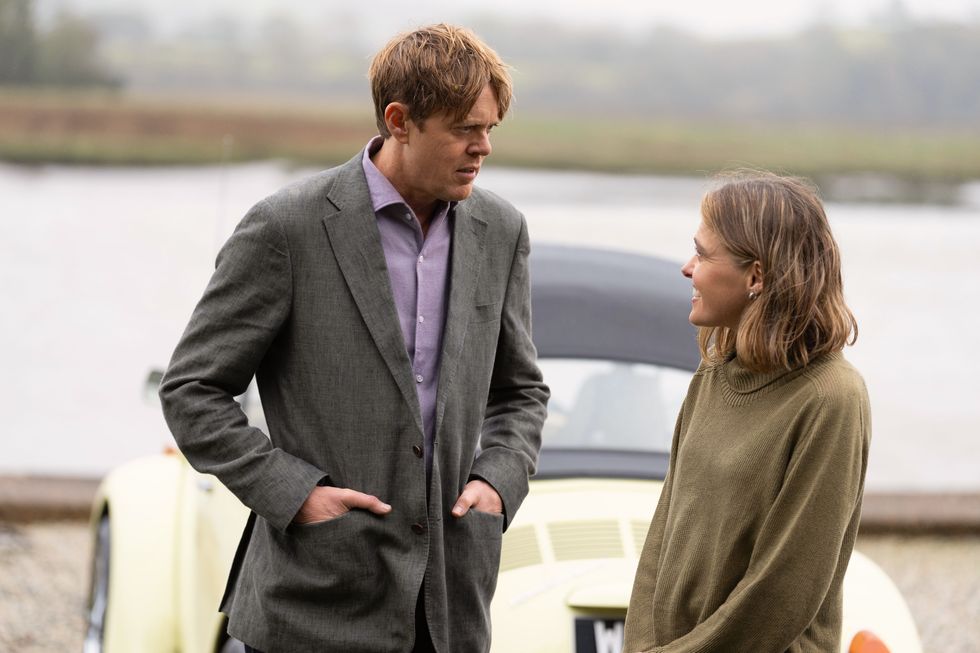
Related: Best streaming services 2024 — including Disney Plus, Netflix, iPlayer and Apple TV+
" Beyond Paradise has become such a huge hit with millions of viewers across the UK. It’s a show that is absolutely on a roll, and we’re beyond pleased to bring more fiendishly clever mysteries from the Shipton Abbott team to the BBC," BBC Director of Drama, Lindsay Salt, said.
This renewal news for Beyond Paradise comes ahead of sweeping changes to the companion show Death in Paradise after Ralf Little recently departed as lead detective Neville Parker.
Death in Paradise and its spin-off, Beyond Paradise , both air on BBC One and stream on BBC iPlayer.
April 2024 gift ideas and deals
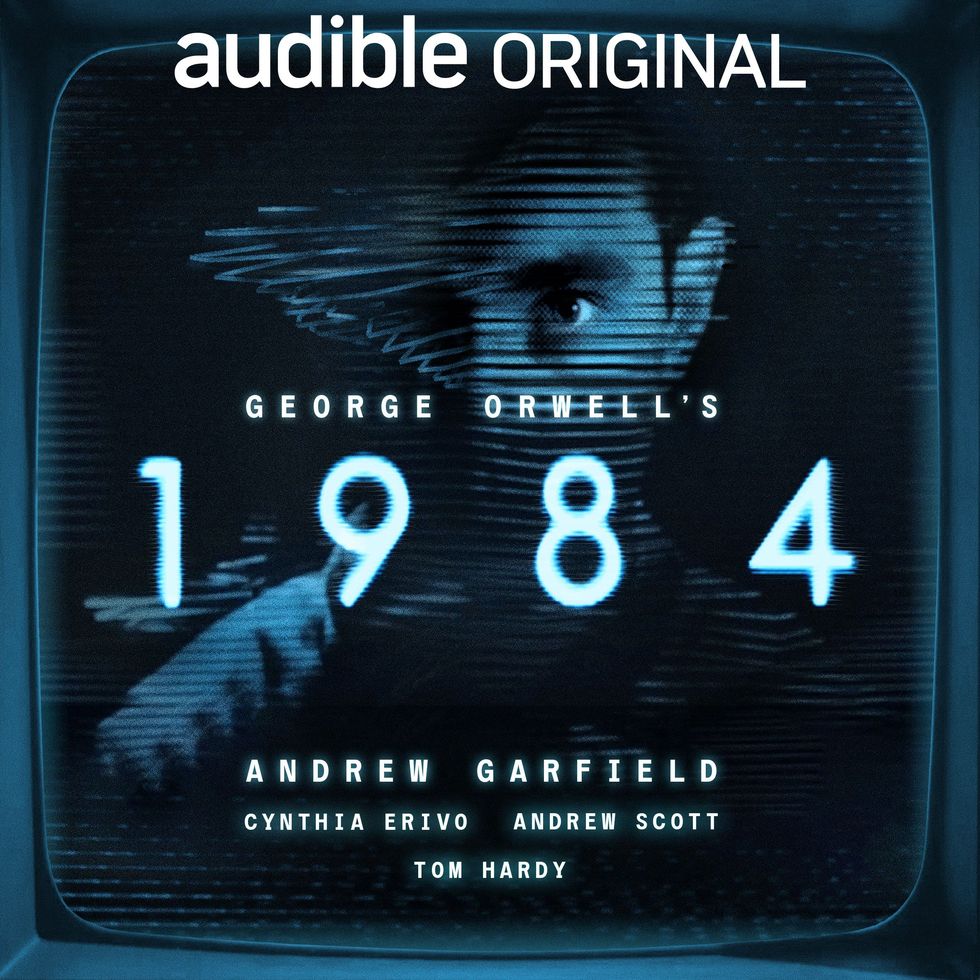
Audible, 3 months for 99p

Watch the Fallout TV show for free
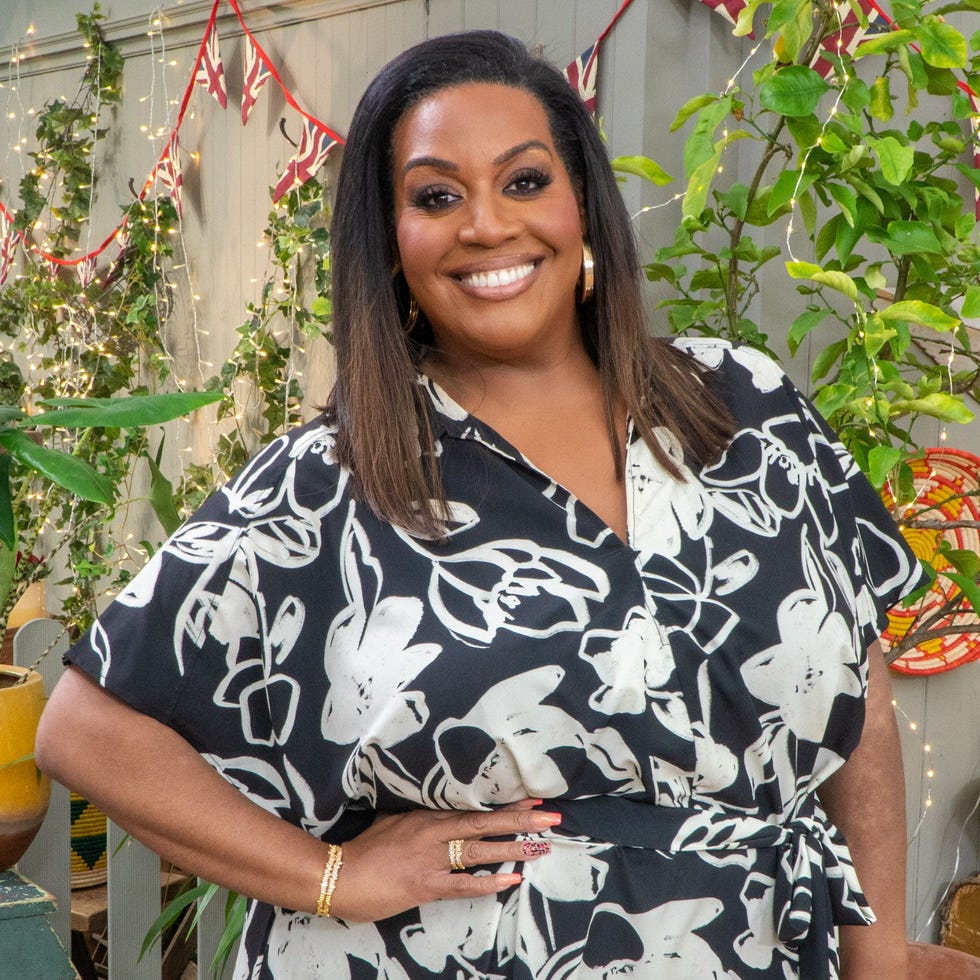
Buy Alison Hammond's outfits
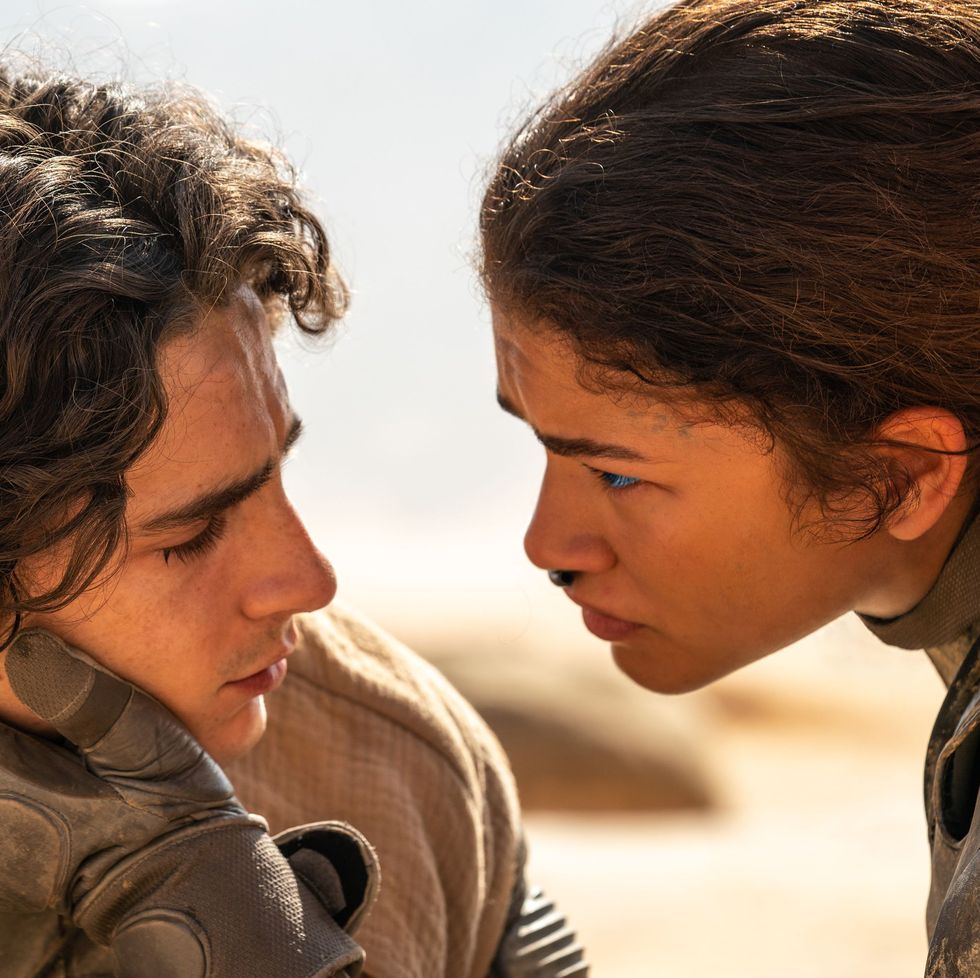
How to watch Dune: Part 2 at home right now

Best refurbished phones you can buy in 2024
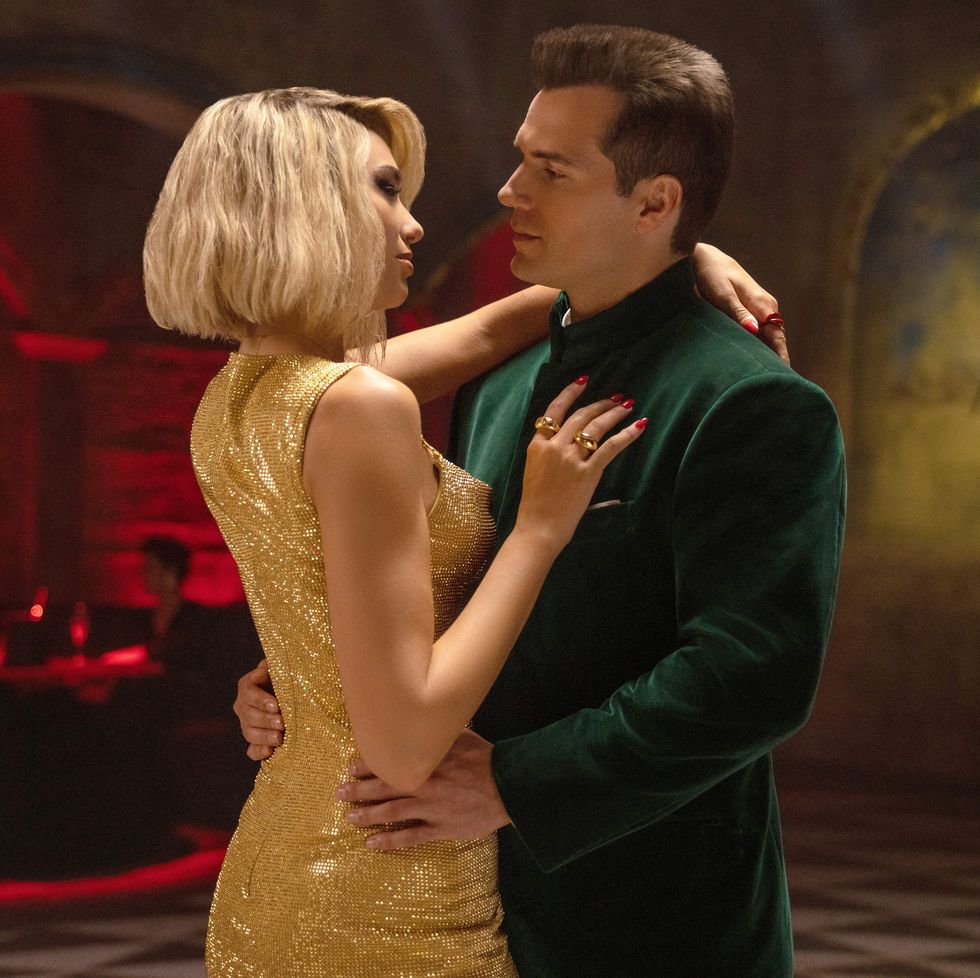
Apple TV+ 7-day free trial
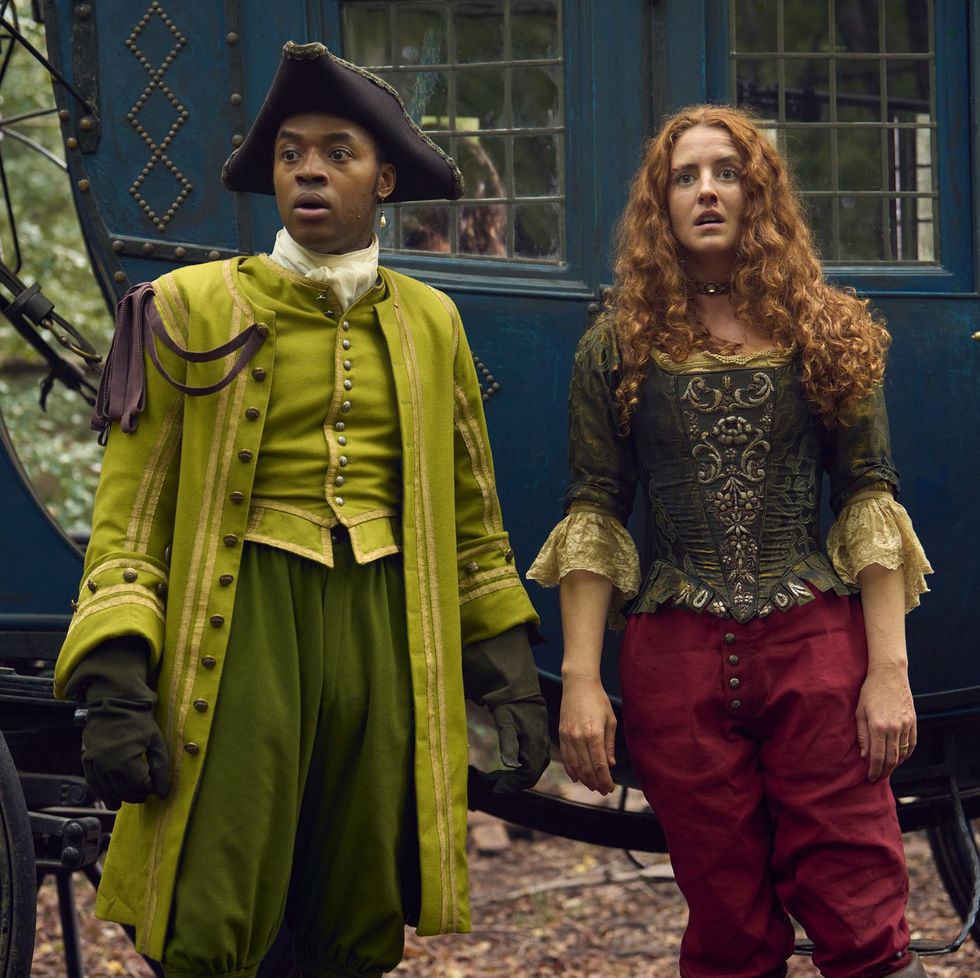
Sign up for Disney+

PS5 Slim Consoles
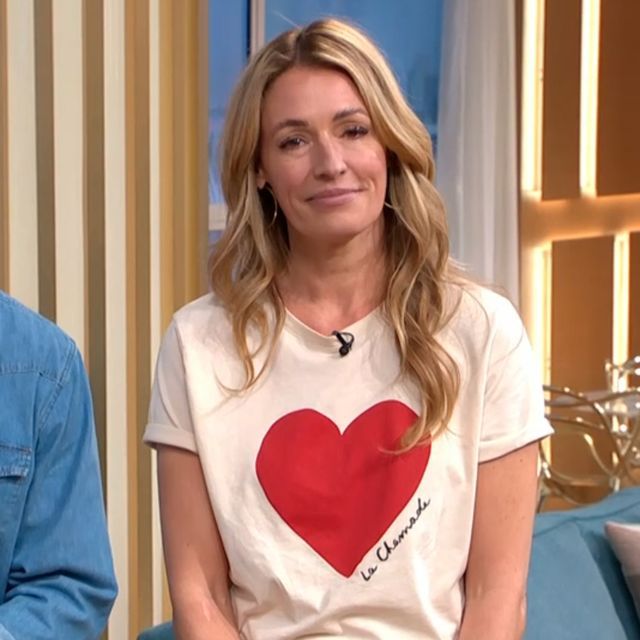
Buy Cat Deeley's This Morning outfits
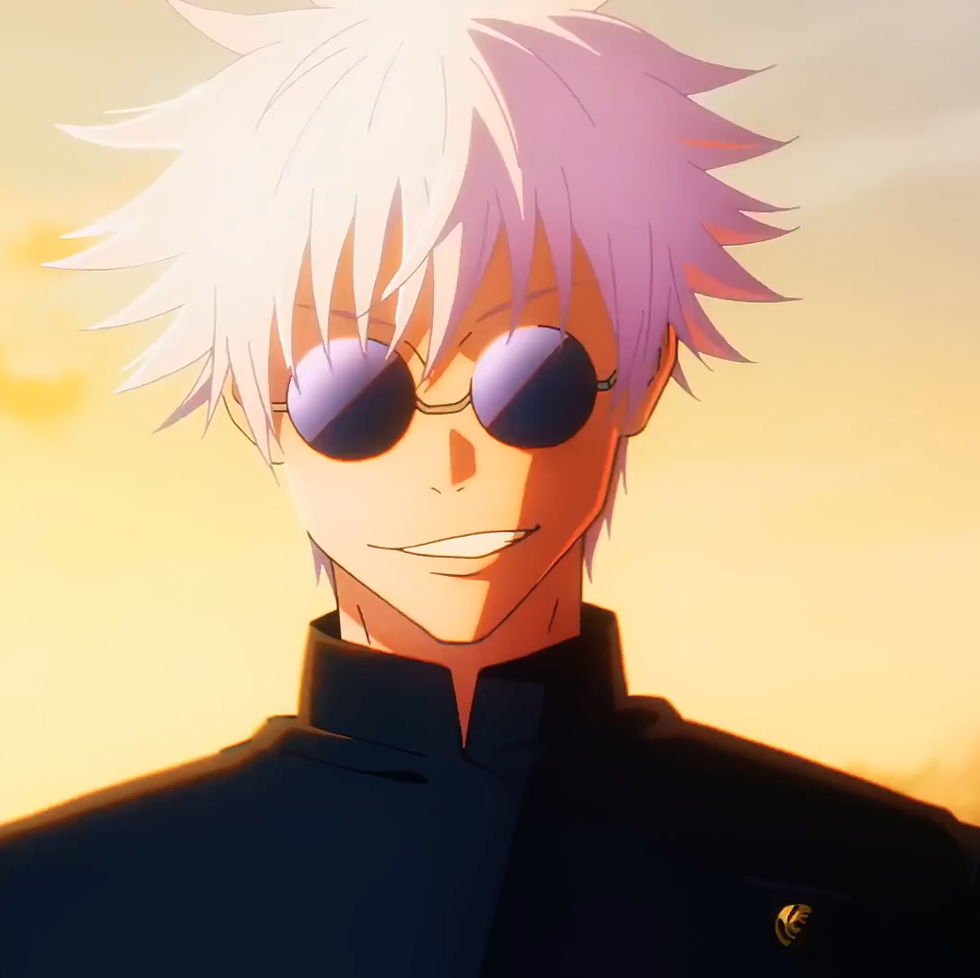
Crunchyroll 14-day free trial
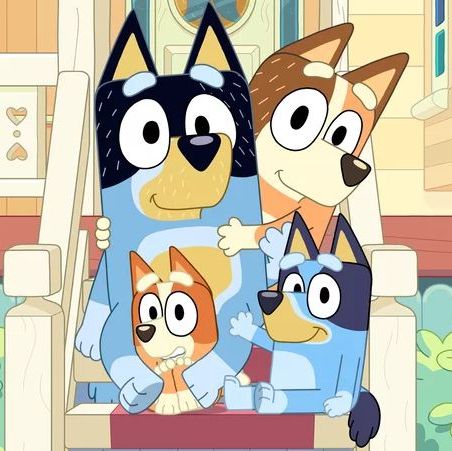
Bluey-themed family dinners launch at Gousto

Shop Sky TV, broadband and mobile
Night News Editor
Justin has been with Digital Spy since 2010, and in that time, has covered countless major news events for DS from the US.
He has worked previously as both a reporter and sub editor for the brand, prior to taking on the position of Night News Editor in 2016.
Over more than a decade, he has interviewed a wide-ranging group of public figures, from comedian Steve Coogan to icons from the Star Trek universe, cast members from the Marvel Cinematic Universe and reality stars from numerous Real Housewives cities and the Below Deck franchise. As a US contributor to Digital Spy, Justin has also been on the ground to cover major pop culture events like the Star Wars Celebration and the D23 Expo.
.css-15yqwdi:before{top:0;width:100%;height:0.25rem;content:'';position:absolute;background-image:linear-gradient(to right,#51B3E0,#51B3E0 2.5rem,#E5ADAE 2.5rem,#E5ADAE 5rem,#E5E54F 5rem,#E5E54F 7.5rem,black 7.5rem,black);} Beyond Paradise

Why Beyond Paradise Martha and Humphrey end works
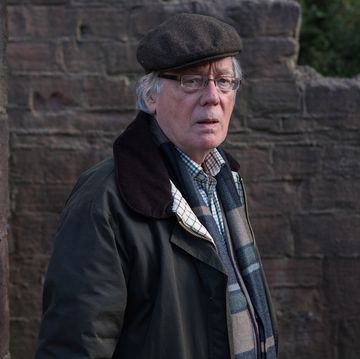
Hollyoaks villain is returning to TV tonight

Beyond Paradise reveals Esther lie in new episode
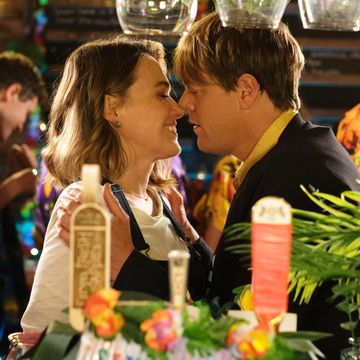
Will Beyond Paradise's Martha and Humphrey split?
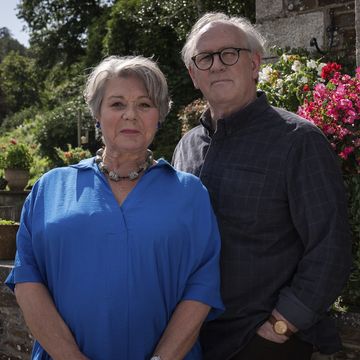
Doctor Who star on potentially leading Paradise

Beyond Paradise surprises with format twist
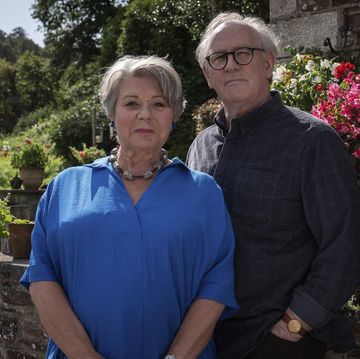
Beyond Paradise's dating storyline is perfect TV
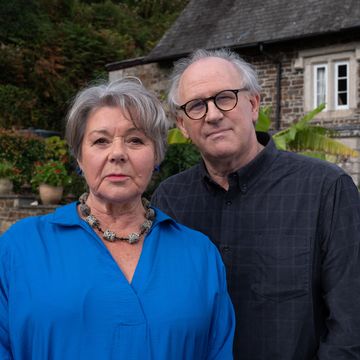
Beyond Paradise viewers divided over guest star
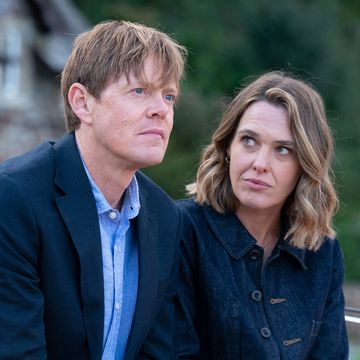
Beyond Paradise couple finally make big decision
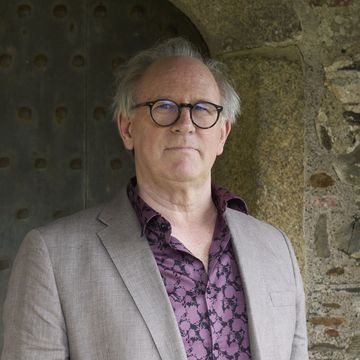
Beyond Paradise saw Doctor Who star in guest role
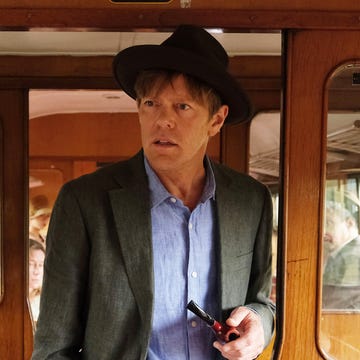
Beyond Paradise is failing viewers in this key way

CinemaBlend
Why William Shatner Allegedly Blocked Kirstie Alley From Returning For 'Star Trek 3,' According To A Trek Documentarian
Posted: April 29, 2024 | Last updated: April 29, 2024
Space may be the final frontier in the "Star Trek" world, but apparently, earthbound grudges can still travel quite keenly through the vastness of space. "Icons Unearthed" director Brian Volk-Weiss knows that firsthand, as an interview he conducted for another project involving Gene Roddenberry’s “Wagon Train to the stars” saw "Star Trek II: The Wrath of Khan’s" Kirstie Alley tell a story about how William Shatner allegedly blocked her from returning for the next film in the series that gave us some of the best sci-fi movies.
More for You
Megan Fox Signs With UTA
US buys 81 Soviet-era combat aircraft from Russia's ally costing on average less than $20,000 each, report says
Here’s What the US Minimum Wage Was the Year You Were Born
Do I have to pay off my spouse's debts when they die? Here's what you're responsible for and what you aren't after a loved one's death
Five teams that botched the 2024 NFL Draft
I’m a psychologist and mom—here are 3 phrases I wish more parents would say to their kids
iPhone users in 92 countries received a recent stark warning
What to Know About the New Student-Loan-Forgiveness Plans
‘NCIS: Hawai'i' Star Vanessa Lachey "Gutted" By Cancellation: "This Decision Was Bigger Than A TV Show"; Cast & Creators React – Update
Team USA Issues Statement Regarding Caitlin Clark's Olympic Status
2024 Mercedes-AMG CLE53: The Coupe, Made Swole
I Was Told My Father Was A 'Deadbeat.' After He Died, I Found Out Everything I Knew About Him Was Wrong.
5 Apple Products To Avoid Buying
67-year-old who left the U.S. for Mexico: I'm happily retired—but I 'really regret' doing these 3 things in my 20s
Tornadoes leave trail of destruction as 4 injured, hundreds of homes damaged
10 best new Netflix originals you need to add to your watch list
How Much Beer You'd Have To Drink To Equal A Single Shot Of Liquor
30 food items that you might not know are banned in America
We Ordered 7 Fast-Food Breakfast Sandwiches to Find the Best One
I Am Doing a PhD at 16—My Mother's Death Is the Reason
Who Will Star in ‘The Traitors’ Season 3?
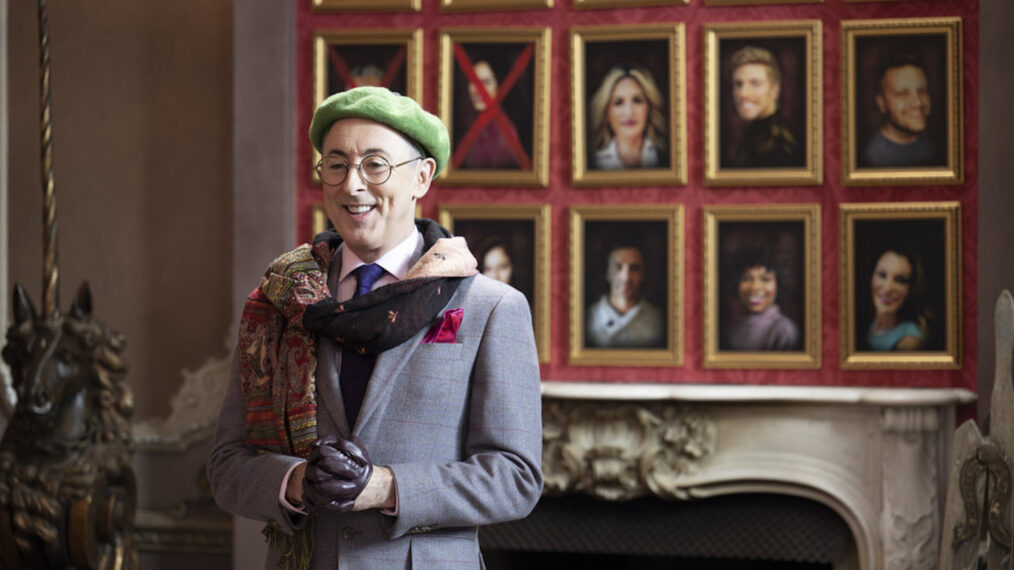
The Traitors
- Ask Matt: Betrayed by ‘Traitors,’ Oscars In Memoriam Fail & More
- ‘Chucky,’ ‘Resident Alien’ & More Stars Strike Poses for Our Portraits
The Traitors is coming back for Season 3, which means fans should prepare for another round of reality television favorites (and villains) fighting to stay “alive” in a spooky Scottish castle amid a massive game of whodunnit.
Seasons 1 and 2 featured TV alums from all over the reality spectrum, from Bravolebrities to The Challenge champions to Survivor alums to Bachelor Nation members and beyond. It’s one of the hottest shows on streaming right now, too, so when it comes to the next season, there’s pretty much no one who’s too cool to be recruited for the cast. In fact, according to The New York Times , reality stars are fighting to get considered for the show.
So, with the entirety of reality TV’s many personalities on the offering table, who’s going to join the fold for Season 3? Here’s what we know so far, along with some sublime fan wishlists.
What does it take to star in The Traitors Season 3?
Peacock has not yet revealed a cast list for The Traitors Season 3, but there are reports of certain reality alums vying for a chance to don one of those lush capes for the show.
Speaking to the New York Times, executive producer Mike Cotton said of the casting process, “You want people from all walks of life that are going to bring their own unique skills to it. You want people who are big competitors, you want people who are cutthroat, you want people who are master manipulators, people who are deep thinkers, people who will sit back and watch and listen. And I think the idea is that they’ll all bring their unique skills, and I think that’s why we have such a mix of people.”
Fellow executive producer Toni Ireland told The Wrap , “Comedy is key in this … [we want] people that give you the incredible sound bites in their master interviews. You want people like C.T. that are brilliant at the challenges, but you’ve got to have people with heart and warmth. You’ve got to have players the viewers are rooting for whether you’re a faithful fan or a traitor fan.”
Who could join The Traitors Season 3 cast?
The paper of record also reports that after The Challenge alums Chris “C.T.” Tamburello and Trishelle Cannatella went on to win Season 2, their fellow former challenger, Jemmye Carroll started hitting up Cannatella, who lives in the same city as her in New Orleans, to put in a good word with the show’s staff.
Previously, fellow Challenge alum and Teen Mom star Cory Wharton blasted MTV for not allowing him to join the first cast of the show, claiming on Twitter that he was supposed to join Season 1 before being called by the network, even though CT and Trishelle would later join with no repercussions (at least not for CT, who’s expected to be part of Season 40 ). Perhaps now he’ll refuse to heed such warnings if the opportunity comes up again.
Crazy to me that MTV literally called me the Day before I was gonna leave for Scotland and film season 1 of traitors 1 & told me i couldn’t go do that show Emailed higher ups and everything , Now I see 4 challenge cast members on season 2🤨??? Y’all feel me though ? — Cory Wharton (@CoryWharton) September 19, 2023
Also, while Wes Bergmann (who retired from The Challenge but is joining House of Villains Season 2) claimed to have no interest in joining the cast of The Traitors , he later changed his mind about the show after watching and became a super fan on Twitter — particularly when it came to Phaedra Park’s meme-able work in Season 2. Watch this space. And Veronica Portillo, who returned to The Challenge All Stars for Season 4, wrote on Twitter that she would “love” to be a part of the cast.
Yessssss!!! I would love to be on an adult-like show where you really have to use your brain for once! https://t.co/zleQ7CkyoB — Veronica Portillo. (@v_cakes) January 26, 2024
Meanwhile, Survivor ‘s Rob Cesternino is interested in joining the next season as well. (Coincidentally, his name is one of the most commonly bandied-about prospects on social media. See here , here , and here , for example.) Real World stars Danny Roberts and Melissa Beck also threw their names out there, as well as Matt Rogers, per NYT. And Captain Lee from Below Deck also answered in the affirmative when a social media follower asked if he’d join the show.
Yeah, I think I’d like that. https://t.co/Y7yPxFUggH — Captain Lee (@capthlr) February 10, 2024
Cotton told Variety that “there’s a chance” someone from Season 2 could appear in Season 3; however, he also felt that it was been there done that territory and wanted to “surprise people in a different way with a different casting twist of some sort.” Cotton had a similar sentiment when asked if another politician like John Bercow could be chosen for the show.
Also, Ireland told The Wrap there may be an interest in bringing in “more sports” people after the show had Olympian swimmer Ryan Lochte and former heavyweight champion boxer Deontay Wilder in Season 1 and 2 respectively, and Bravolebrities are “always in consideration” for the gig.
Who do fans want to star in The Traitors Season 3?
Fans are already putting together their wishlists for which reality television favorites (and villains) might make their way into the Scottish castle for a massive murder mystery game, and the choices have been pretty sublime!
Here are some of the best suggestions from the Traitors fanbase so far.
- Alaska Thunderf*** from RuPaul’s Drag Race : After Peppermint was eliminated way too early in the show, drag fans want to see another queen get a shot, and Alaska is at the tippy top of their wishlists.
- Danielle Reyes from Big Brother : One of the most frequent names to pop up on any given The Traitors Season 3 wishlist thread is this highly strategic and socially strong fan favorite.
- Da’Vonne Rogers from Big Brother and The Challenge : There are a lot of fans who want to see her take her wits and charm to the castle, too.
- Dorinda Medley from Real Housewives of New York : Another housewife whose name pops up on a lot of fan-casting lists is this housewife who, despite the meme, is doing well — at least where fans are concerned.
- Jason Kelce from NFL : Now that he’s retired from the NFL, this spitfire of a human could bring some of the wild energy (and belly dancing) to a new game, and a lot of fans would be in favor.
- Joey Graziadei from The Bachelor : Arie Luyendyk Jr. and Peter Weber proved to be viable competitors, it’s probable that another Bachelor will enter the house, and this is one of the fans want to see … for reasons.
- LeAnn and Trey from Squid Game: The Challenge : Season 2 of The Traitors featured a couple entering the competition, and some fans want to see another pair go head-to-head in Season 3 — this time, the mother-and-son duo who broke everyone’s hearts in the marbles challenge.
- Nene Leakes from The Real Housewives of Atlanta : Since Housewives have become such a mainstay of The Traitors at this point (#PhaedrasImpact), a lot of fans are pointing to Nene Leakes as the one to go for. Her personality can be just the right amount of ebullient to own the house, er castle, in this show.
- Stassi Shroeder from Vanderpump Rules : One consistent name that comes up on social media threads about the next cast is Stassi from VPR . She’d be the first Pump-er to join the show, and she would definitely make her presence known.
- Tom Sandoval from VPR : Another Pump alum that has been at the tip of everyone’s tongues lately is Tom Sandoval, whose infamous Scandoval event has already landed him a reality competition spot on Season 2 of Special Forces: World’s Toughest Test .
- Tyson Apostol from Survivor : A lot of fans think this notorious villain of the series — who also had a run-in or two with Season 2 traitor Parvati Shallow — would be a natural fit for the series.
There are also some lowkey chaotic suggestions floating around the web-o-sphere (like Gypsy Rose Blanchard and former U.S. congressman George Santos), so if the producers really want to put folks on edge… Nah.
The Traitors, Seasons 1 & 2, Peacock
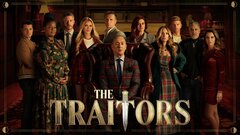
The Traitors where to stream
- More to Explore
- Series & Movies
Star Trek History: Far Beyond the Stars
On this day exactly 25 years ago, the Deep Space Nine episode premiered.
On this day in 1998, the Star Trek: Deep Space Nine episode "Far Beyond the Stars" premiered.
Stay tuned to StarTrek.com for more details! And be sure to follow @StarTrek on Facebook , Twitter , and Instagram .
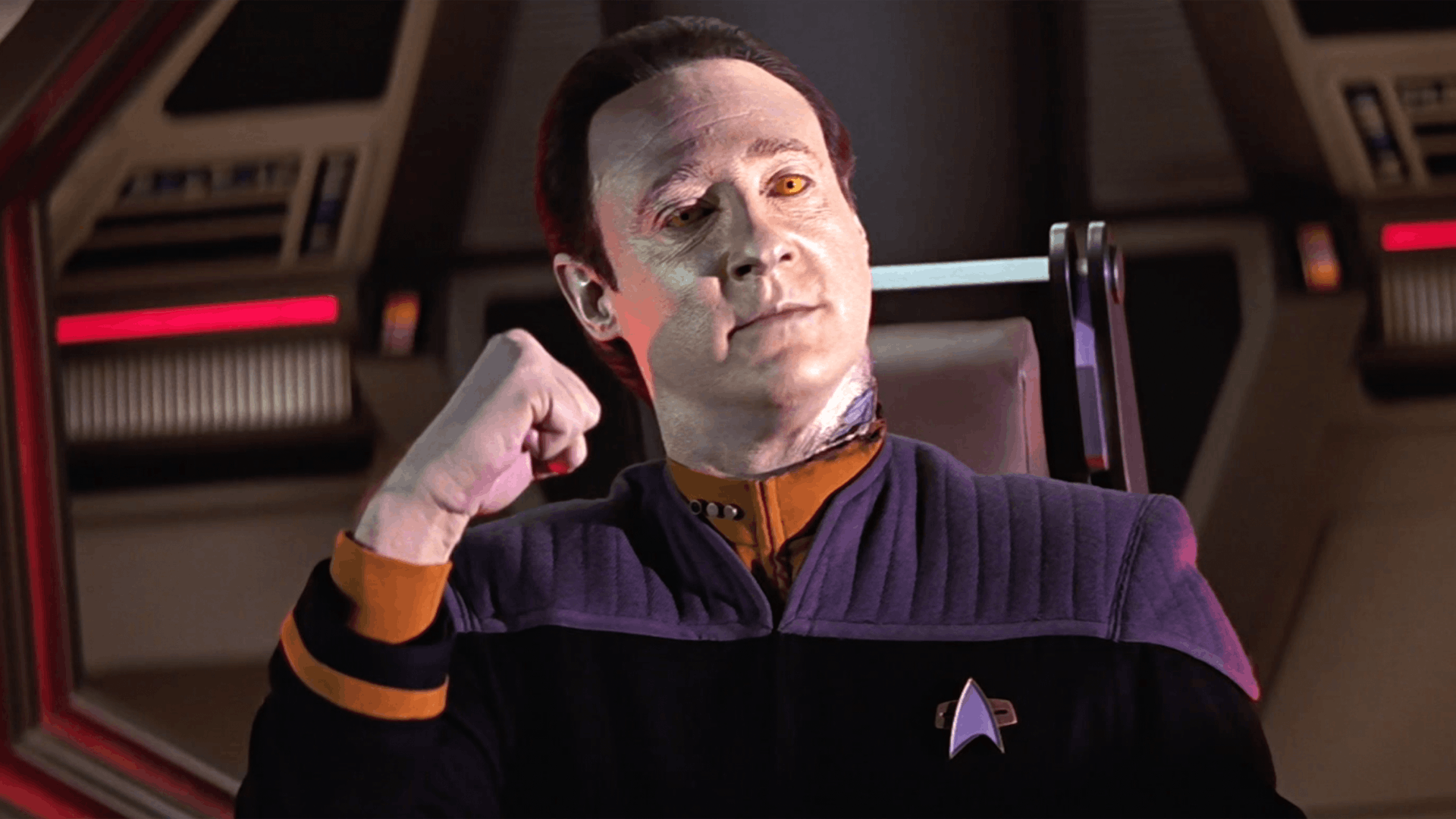

Fortnite Star Wars event 2024: Start date, rumours and predicted skins
"We've got a good feeling about this..."

- Share on facebook
- Share on twitter
- Share on pinterest
- Share on reddit
- Email to a friend
The Force is going to be strong with Fortnite in the very near future, with yet another Star Wars event due to kick off in the game.
Yep, the Disney-owned sci-fi franchise and the Epic-developed gaming sensation will be teaming up yet again, which shouldn't come as a massive surprise to anyone — especially when you consider that Disney recently made a big investment in Epic .
While we wait to see the whole new 'universe' of experiences that Disney and Epic are cooking up, players of Fortnite will be heading back to that galaxy far, far away for their umpteenth collab.
Read on to learn more!
When is the Fortnite Star Wars event? 2024 date revealed
The latest Fortnite Star Wars event will start on 3rd May 2024 , Disney and Epic games have confirmed, with the teaser below being shared on all the official channels.
More like this
This means that the 2024 Fortnite Star Wars event will be will under way in time for May the 4th (be with you), a celebrated day in the Lucasfilm franchise's fandom.
This will give players something fresh to enjoy while they wait for the next Fortnite season . We'd expect skins aplenty and probably some fun surprises too.
"We have a good feeling about this... Star Wars is returning to Fortnite," the official promo clip's caption says.
The Fortnite Star Wars event's 3rd May start date is confirmed in the video itself, with the Fortnite and Star Wars logos being shown.
Better yet, the teaser throws up the logos for LEGO Fortnite and Fortnite Festival , confirming that we'll be getting brick-based building and musical merriment from this crossover, as well as the usual battle royale action.
What will the new Fortnite Star Wars skins be? Our predictions
We would predict that this year's Fortnite Star Wars event will probably contain a lot of promotion for The Acolyte , the upcoming Disney Plus series that is set around 100 years before the events of Star Wars Episode I: The Phantom Menace.
With The Acolyte being the next major release from the Star Wars franchise, it would make perfect sense for Disney to promote it to Epic's massive Fortnite player base.
The Acolyte cast of characters includes Squid Game star Lee Jung-jae as Sol, The Matrix's Carrie-Anne Moss as Indara, and Logan's Dafne Keen as Jecki Lon, not to mention the returning book character Vernestra Rwoh and an eye-catching Wookiee Jedi named Kelnacca.
Stay ahead of the game!
Sign up for our gaming newsletter to receive the latest insights, reviews and expert recommendations
By entering your details, you are agreeing to our terms and conditions and privacy policy . You can unsubscribe at any time.
We wouldn't be surprised to see any of those lot turned into Fortnite Star Wars skins this time! Expect to see a lot of robe-based outfits on the island!
Popular Star Wars characters from other eras — like Anakin and Padmé from the Prequel Trilogy, and Luke and Leia from the Original Trilogy — have been added to Fortnite before. It would be an easy win for Epic and Disney to bring back some classic skins here, so don't be surprised to see that happen as well.
A few leaks and rumours seem to be doing the rounds online right now, so keep on reading if you don't mind seeing some potential spoilers for what could be coming .
What do the Fortnite Star Wars leaks and rumours say?
As ever, the Fortnite fandom has been mining the game's files and going to any lengths necessary to see what's coming in the Fortnite Star Wars event ahead of time.
Some very real-looking artwork has started doing the rounds online, making it look very likely that Lando Calrissian will be appearing in Fortnite Festival during this event.
We'd hope that Billy Dee Williams and Donald Glover's character is bringing the iconic Star Wars Cantina music with him! And you'd assume he'll be a playable skin in the other Fortnite modes, as well.
Another piece of artwork that's doing the rounds shows lightsabers in LEGO Fortnite , along with Star Wars-themed items to use in your building projects.
Beyond that, we haven't seen too much in the way of leaked materials. It's worth remembering that Ahsoka was in Fortnite last year, so could well make a quick comeback here as well.
As and when rumours become facts and all the Fortnite Star Wars details are confirmed, we'll be sure to update this page.
Discover more with Fortnite creative map codes: Fortnite horror maps | Fortnite action-adventure maps | Fortnite hide and seek maps | Fortnite Zone Wars maps | Fortnite fighting maps | Fortnite parkour maps | best Fortnite creative maps | Fortnite Squid Game map codes | Fortnite Monopoly code | Fortnite I'm A Celebrity Get Me Out Of Here code | Fortnite Doctor Who map code
Check out more of our Gaming coverage or visit our TV Guide and Streaming Guide to find out what's on. For more from the biggest stars in TV, listen to The Radio Times Podcast .

Subscribe to Radio Times
Try 10 issues for just £10!

Get quotes for private healthcare
Get quotes from Bupa, AXA, Aviva and more from Confused. Get quicker treatment when you need it most.

Win tickets to RHS Chelsea Flower Show!
Enter now for your chance to win tickets on Saturday 25 May
The best TV and entertainment news in your inbox
Sign up to receive our newsletter!

IMAGES
VIDEO
COMMENTS
In Star Trek 101 (p. 125), Terry J. Erdmann and Paula M. Block list "Far Beyond the Stars" as being one of the "Ten Essential Episodes" from Star Trek: Deep Space Nine. The Cinefantastique cover honoring the episode. Cinefantastique ranked "Far Beyond the Stars" as the seventh best episode of Star Trek: Deep Space Nine.
List of episodes. " Far Beyond the Stars " is the 137th episode of the syndicated science fiction television series Star Trek: Deep Space Nine, the 13th episode of season 6. The teleplay was written by Ira Steven Behr and Hans Beimler, based on a story by Marc Scott Zicree, and directed by Avery Brooks, who also played the episode's - and ...
Far Beyond the Stars: Directed by Avery Brooks. With Avery Brooks, Rene Auberjonois, Michael Dorn, Terry Farrell. Captain Sisko has a full sensory vision of himself as an under-appreciated science fiction magazine writer in 1950s America.
To celebrate the 16th anniversary of "Far Beyond the Stars" - it aired on February 11, 1998 -- StarTrek.com thought we'd revisit some of the terrific dialogue and share some "Did you know" bits. Also, StarTrek.com reached out to several of the episode's key players - including Shimerman, Visitor, Hertzler and Combs -- for ...
Deep Space Nine's classic episode 'Far Beyond the Stars' is a moving social allegory about racism, but it's also about the dream that is Star Trek. Summary. Star Trek: Deep Space Nine 's most unique episode is "Far Beyond the Stars," a story set in a Sci-Fi magazine's offices in 1950. One of DS9's most celebrated episodes, it deals with ...
Star Trek History: Far Beyond the Stars. This episode sees Captain Benjamin Sisko begin to hallucinate while speaking with his father and later while he's walking with down a corridor with Kasidy Yates. He sees figures that appear to be humans from the 1950s walking around the space station.
It's a fun argument, with almost too many options to consider, but, to us, the answer to the question What was the single best episode of Star Trek: Deep Space Nine? is "Far Beyond the Stars."The extraordinary hour of television -- which debuted on February 11, 1998 -- or 19 years ago today -- was directed by Avery Brooks and gave us a Prophets-inspired vision of 1950s science-fiction writer ...
Star Trek: Deep Space Nine "Far Beyond the Stars" Air date: 2/8/1998 Teleplay by Ira Steven Behr & Hans Beimler Story by Marc Scott Zicree Directed by Avery Brooks. Review by Jamahl Epsicokhan "You see, Albert's got the right idea. He's not interested in Negroes or whites. He writes about robots." "That's because he is a robot." — Douglas ...
Sisko has visions of himself and his crew as writers for a science fiction paper in 1950's Earth.
In the Star Trek: Deep Space Nine Season 6 episode "Far Beyond the Stars", Captain Benjamin Sisko ( Avery Brooks) is at a precipice—the Federation is in the midst of a war that has no end in ...
"Star Trek: Deep Space Nine" Far Beyond the Stars (TV Episode 1998) cast and crew credits, including actors, actresses, directors, writers and more. Menu. Movies. Release Calendar Top 250 Movies Most Popular Movies Browse Movies by Genre Top Box Office Showtimes & Tickets Movie News India Movie Spotlight.
Star Trek: Deep Space Nine S06E13 "Far Beyond the Stars". Now this one's a little different. Joseph Sisko pays a surprise visit to Deep Space Nine to see Benjamin and Jake. Ben confides in his father that the war with the Dominion is taking its toll on him, and he is considering stepping down. While talking with him, Benjamin sees a strange ...
Cirroc Lofton (Jake Sisko in Star Trek Deep Space Nine), Malissa Longo, and Ryan T. Husk review DS9's season 6, episode 13, "FAR BEYOND THE STARS." Special G...
Star Trek has a long history of using science fiction tropes to deal with social issues. We did a semi-jokey Inventory on the subject four years ago, and it's always been a symbol of the ...
For Star Trek: Deep Space Nine 's most beloved episode, "Far Beyond the Stars," Avery Brooks pulled double duty in more ways than one.. The actor spoke with ET leading up to its premiere 25 ...
Check out the preview for "Far Beyond the Stars" HERE._____ Terry J. Erdmann and Paula M. Block confess to having lifted parts of this story from their book The Star Trek: Deep Space Nine Companion. Their most recent books are the full color tomes, Star Trek The Original Series 365 and Star Trek The Next Generation 365.
Far Beyond the Stars is an episode of Star Trek: Deep Space Nine. It was directed by series star Avery Brooks and written by Ira Steven Behr and Hans Beimler. It aired in February 1998, with a novelization adaptation released in June that same year. Benjamin Sisko experiences another life where he is Benny Russell, a talented science fiction writer of the 1950s, who comes up against the racism ...
Far Beyond the Stars is very much an archetypal Star Trek story. In fact, it is tempting to describe the episode as cross between The City on the Edge of Forever and The Inner Light, two episodes that can make a convincing argument for being the best episodes of their respective runs.As in The City on the Edge of Forever, the lead character finds himself thrown back to mid-twentieth-century ...
Far Beyond the Stars (Star Trek: Deep Space Nine) Kindle Edition. Without warning, Benjamin Sisko is living another life. No longer a Starfleet captain, commander of space station Deep Space Nine, he is Benny Russell, a struggling science fiction writer living in 1950s Harlem. Benny has a dream, of a place called Deep Space Nine and a man named ...
ABC NEWS LIVE: Many of you know him best as Hikaru Sulu from the Star Trek series, but his journey extends far beyond the stars. His new book, "My Lost Freedom," details his experience growing up ...
The story, as told by Rafiki, "begins far beyond the mountain and the shadows on the other side of the light." "It's a story about how Mufasa rose to royalty," Jenkins said at Disney's D23 Expo in ...
Frieren: Beyond Journey's End is easily one of the biggest anime of the past few years. Not only does it have gorgeous art, animation, and overall direction, but its straightforward take on the fantasy genre, combined with intelligent and emotionally resonant writing, made it a major hit among fans and critics alike to a degree that very few anime have ever managed to achieve.
From the groundbreaking brilliance of Star Trek to the modern masterpiece Black Mirror, the greatest sci-fi TV shows of all time have expanded the genre's horizons and left an indelible mark on ...
© 2024 CBS Studios Inc., Paramount Pictures Corporation, and CBS Interactive Inc., Paramount companies. STAR TREK and related marks are trademarks of CBS Studios Inc.
The second season of Beyond Paradise has continued to be a ratings winner for BBC One, with its opening episode attracting an impressive 7.5 million viewers thus far.
Space may be the final frontier in the "Star Trek" world, but apparently, earthbound grudges can still travel quite keenly through the vastness of space. "Icons Unearthed" director Brian Volk ...
Previously, fellow Challenge alum and Teen Mom star Cory Wharton blasted MTV for not allowing him to join the first cast of the show, claiming on Twitter that he was supposed to join Season 1 ...
On this day exactly 25 years ago, the Deep Space Nine episode premiered. On this day in 1998, the Star Trek: Deep Space Nine episode "Far Beyond the Stars" premiered. Stay tuned to StarTrek.com for more details! And be sure to follow @StarTrek on Facebook, Twitter, and Instagram.
The Force is going to be strong with Fortnite in the very near future, with yet another Star Wars event due to kick off in the game. Yep, the Disney-owned sci-fi franchise and the Epic-developed ...